Pioneer T103 Digital wireless speaker system transmitter User Manual XV HTD640
Pioneer Corporation Digital wireless speaker system transmitter XV HTD640
Pioneer >
Users manual
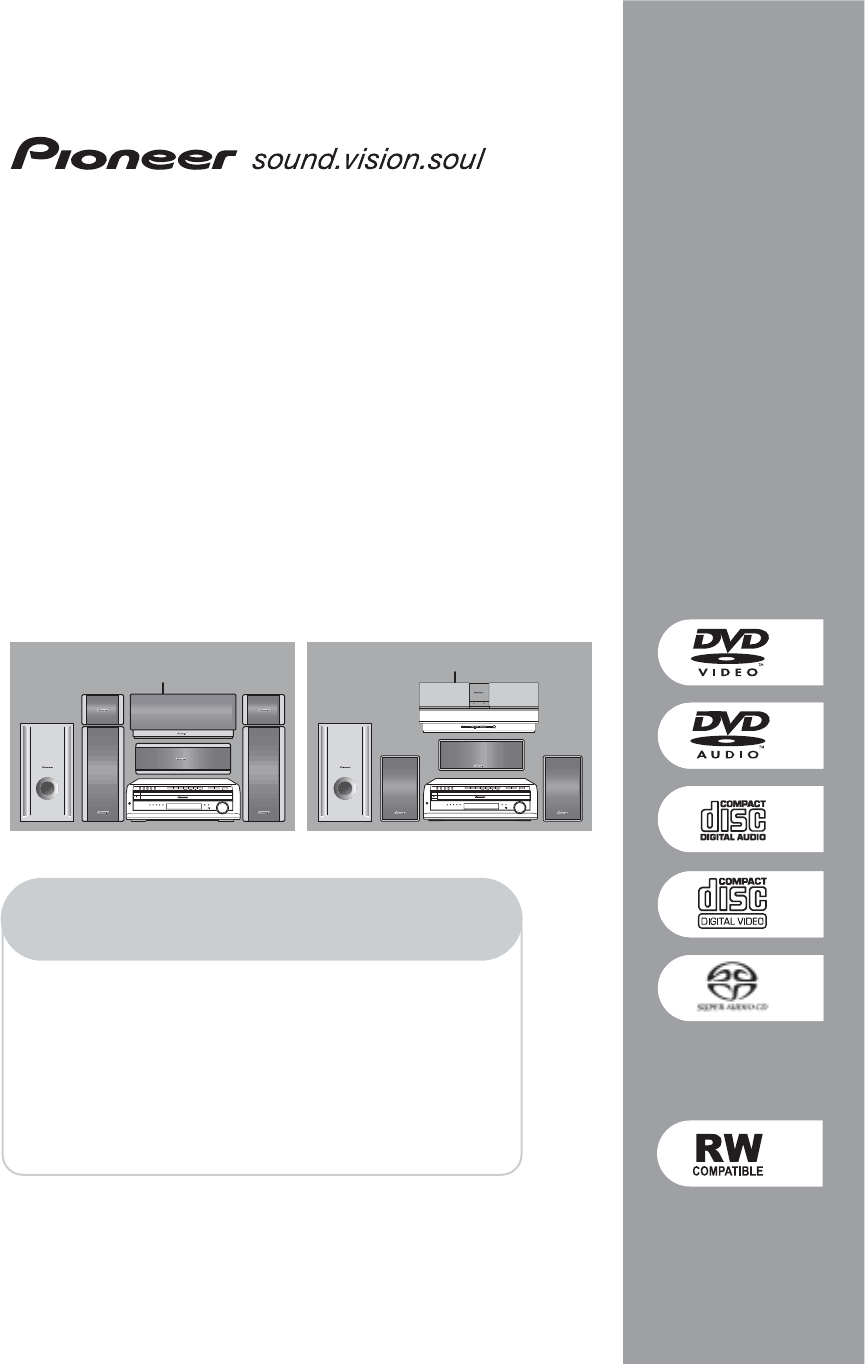
Register your product at:
www.pioneerelectronics.com
• Protect your new investment
The details of your purchase will be on file for reference in the event of an
insurance claim such as loss or theft.
• Improve product development
Your input helps us continue to design products that meet your needs.
• Receive a free Pioneer newsletter
Registered customers can opt in to receive a monthly newsletter.
• Receive free tips, updates and service bulletins on
your new product
HTD-645DV
XV-HTD640/S-HTD540/XW-HTD640 XV-HTD640/S-HTD630/XW-HTD630
HTD-641DV
TUNED
POWER WIRELESS
MODE
STEREO MODE
VOLUME
CHANNEL
SURROUND STEREO MIN MAXAUTO ON/OFF
OFF ON
AUTO
OFF ON
wireless
Digital
speaker system
PHONES
STANDBY/ON
DOWN
VOLUME
CD MODE TIMER
UP
DVD/CD TUNER TV/L1/L2
FM/AM/ST.
DIRECT PLAY
DISC SKIP EXCHANGE OPEN/CLOSE
12345
DISC 12345
PHONES
STANDBY/ON
DOWN
VOLUME
CD MODE TIMER
UP
DVD/CD TUNER TV/L1/L2
FM/AM/ST.
DIRECT PLAY
DISC SKIP EXCHANGE OPEN/CLOSE
12345
DISC 12345
DVD/
C
D Receive
r
XV-HTD640
Speaker System
S-HTD540
S-HTD630
Digital Wireless Speaker System
XW-HTD640
XW-HTD630
Operating Instructions

The exclamation point within an equilateral
triangle is intended to alert the user to the
presence of important operating and
maintenance (servicing) instructions in the
literature accompanying the appliance.
The lightning flash with arrowhead, within
an equilateral triangle, is intended to alert
the user to the presence of uninsulated
"dangerous voltage" within the product's
enclosure that may be of sufficient
magnitude to constitute a risk of electric
shock to persons.
CAUTION:
TO PREVENT THE RISK OF ELECTRIC
SHOCK, DO NOT REMOVE COVER (OR
BACK). NO USER-SERVICEABLE PARTS
INSIDE. REFER SERVICING TO QUALIFIED
SERVICE PERSONNEL.
CAUTION
RISK OF ELECTRIC SHOCK
DO NOT OPEN
D1-4-2-3_En
WARNING – TO PREVENT FIRE OR SHOCK
HAZARD, DO NOT EXPOSE THIS
APPLIANCE TO RAIN OR MOISTURE.
D1-4-2-1_En
IMPORTANT NOTICE – THE SERIAL NUMBER FOR THIS EQUIPMENT IS LOCATED IN THE REAR.
PLEASE WRITE THIS SERIAL NUMBER ON YOUR ENCLOSED WARRANTY CARD AND
KEEP IN A SECURE AREA. THIS IS FOR YOUR SECURITY.
D1-4-2-6-1_En
NOTE: This equipment has been tested and found to comply with the limits for a Class B digital device, pursuant to
Part 15 of the FCC Rules. These limits are designed to provide reasonable protection against harmful interference in
a residential installation. This equipment generates, uses, and can radiate radio frequency energy and, if not
installed and used in accordance with the instructions, may cause harmful interference to radio communications.
However, there is no guarantee that interference will not occur in a particular installation. If this equipment does
cause harmful interference to radio or television reception, which can be determined by turning the equipment off
and on, the user is encouraged to try to correct the interference by one or more of the following measures:
– Reorient or relocate the receiving antenna.
– Increase the separation between the equipment and receiver.
– Connect the equipment into an outlet on a circuit different from that to which the receiver is connected.
– Consult the dealer or an experienced radio/TV technician for help.
D8-10-1-2_En
For U.S. and Australia Model
C67-7-3_En
CAUTION – PREVENT ELECTRIC SHOCK DO
NOT USE THIS (POLARIZED) PLUG
WITH AN EXTENSION CORD.
RECEPTACLE OR OTHER OUTLET
UNLESS THE BLADES CAN BE
FULLY INSERTED TO PREVENT
BLADE EXPOSURE.
ATTENTION –
POUR PREVENIR LES CHOCS
ELECTRIQUES NE PAS UTILISER
CETTE FICHE POLARISEE AVEC UN
PROLONGATEUR UNE PRISE DE
COURANT OU UNE AUTRE SORTIE
DE COURANT, SAUF SI LES LAMES
PEUVENT ETRE INSEREES A FOND
SANS EN LAISSER AUCUNE PARTIE
A DECOUVVERT.
D2-4-4-1_EF
Energy-saving design
This system is designed to use 0.5W of
electricity when power is switched to
standby.
[Excluding XW-HTD630/640]
[For Canadian model only] [Pour le modèle Canadien]
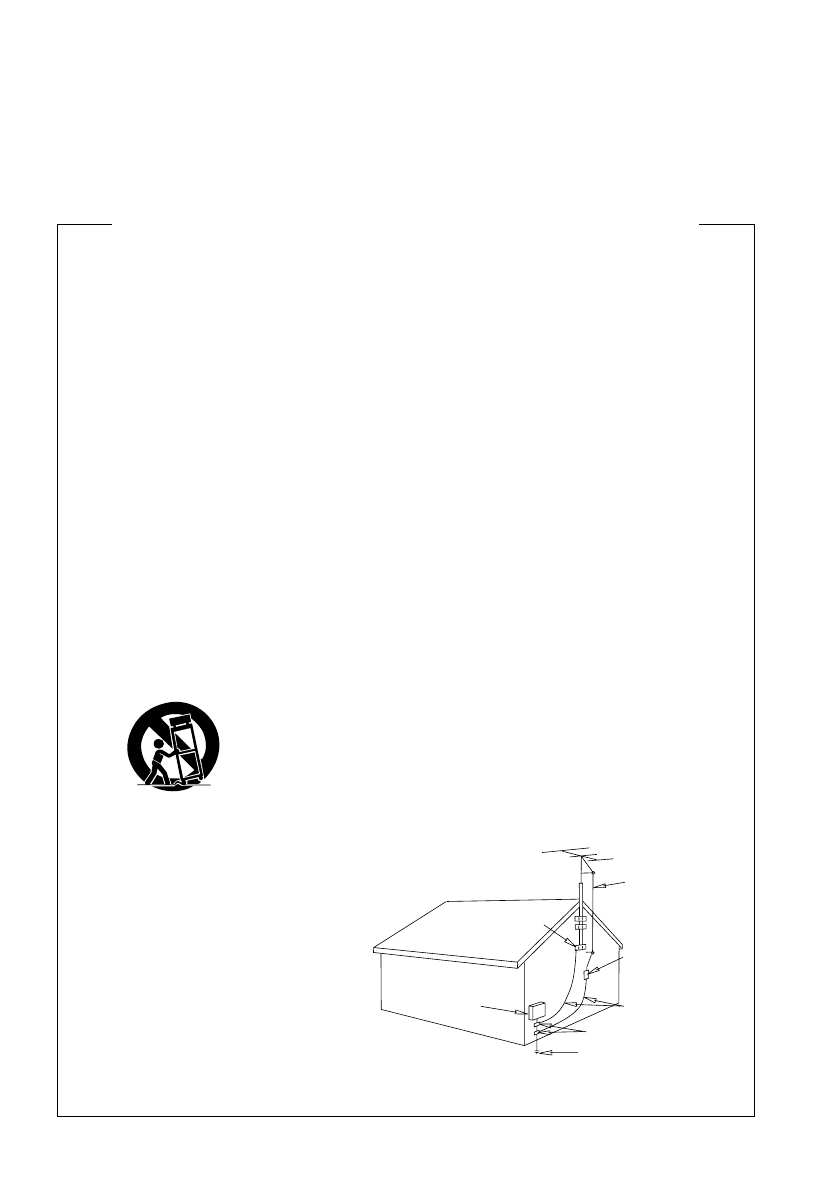
READ INSTRUCTIONS — All the safety and
operating instructions should be read before the
product is operated.
RETAIN INSTRUCTIONS — The safety and
operating instructions should be retained for
future reference.
HEED WARNINGS — All warnings on the product
and in the operating instructions should be
adhered to.
FOLLOW INSTRUCTIONS — All operating and use
instructions should be followed.
CLEANING — The product should be cleaned only
with a polishing cloth or a soft dry cloth. Never
clean with furniture wax, benzine, insecticides
or other volatile liquids since they may corrode
the cabinet.
ATTACHMENTS — Do not use attachments not
recommended by the product manufacturer as
they may cause hazards.
WATER AND MOISTURE — Do not use this
product near water — for example, near a
bathtub, wash bowl, kitchen sink, or laundry
tub; in a wet basement; or near a swimming
pool; and the like.
ACCESSORIES — Do not place this product on an
unstable cart, stand, tripod, bracket, or table.
The product may fall, causing serious injury to a
child or adult, and serious damage to the
product. Use only with a cart, stand, tripod,
bracket, or table recommended by the
manufacturer, or sold with the product. Any
mounting of the product should follow the
manufacturer’s instructions, and should use a
mounting accessory recommended by the
manufacturer.
CART — A product and cart combination should be
moved with care. Quick stops, excessive force,
and uneven surfaces may cause the product
and cart combination to overturn.
VENTILATION — Slots and openings in the cabinet
are provided for ventilation and to ensure
reliable operation of the product and to protect
it from overheating, and these openings must
not be blocked or covered. The openings should
never be blocked by placing the product on a
bed, sofa, rug, or other similar surface. This
product should not be placed in a built-in
installation such as a bookcase or rack unless
proper ventilation is provided or the
manufacturer’s instructions have been adhered
to.
POWER SOURCES — This product should be
operated only from the type of power source
indicated on the marking label. If you are not
sure of the type of power supply to your home,
consult your product dealer or local power
company.
LOCATION – The appliance should be installed in a
stable location.
NONUSE PERIODS – The power cord of the
appliance should be unplugged from the outlet
when left un-used for a long period of time.
GROUNDING OR POLARIZATION
• If this product is equipped with a polarized
alternating current line plug (a plug having one
blade wider than the other), it will fit into the
outlet only one way. This is a safety feature. If
you are unable to insert the plug fully into the
outlet, try reversing the plug. If the plug should
still fail to fit, contact your electrician to replace
your obsolete outlet. Do not defeat the safety
purpose of the polarized plug.
• If this product is equipped with a three-wire
grounding type plug, a plug having a third
(grounding) pin, it will only fit into a grounding
type power outlet. This is a safety feature. If you
are unable to insert the plug into the outlet,
contact your electrician to replace your obsolete
outlet. Do not defeat the safety purpose of the
grounding type plug.
POWER-CORD PROTECTION — Power-supply
cords should be routed so that they are not likely
to be walked on or pinched by items placed
upon or against them, paying particular
attention to cords at plugs, convenience
receptacles, and the point where they exit from
the product.
OUTDOOR ANTENNA GROUNDING — If an
outside antenna or cable system is connected to
the product, be sure the antenna or cable
system is grounded so as to provide some
protection against voltage surges and built-up
static charges. Article 810 of the National
Electrical Code, ANSI/NFPA 70, provides
information with regard to proper grounding of
the mast and supporting structure, grounding of
the lead-in wire to an antenna discharge unit,
size of grounding conductors, location of
antenna-discharge unit, connection to
grounding electrodes, and requirements for the
grounding electrode. See Figure A.
LIGHTNING — For added protection for this
product during a lightning storm, or when it is
left unattended and unused for long periods of
time, unplug it from the wall outlet and
disconnect the antenna or cable system. This
will prevent damage to the product due to
lightning and power-line surges.
POWER LINES — An outside antenna system
should not be located in the vicinity of overhead
power lines or other electric light or power
circuits, or where it can fall into such power
lines or circuits. When installing an outside
antenna system, extreme care should be taken
to keep from touching such power lines or
circuits as contact with them might be fatal.
OVERLOADING — Do not overload wall outlets,
extension cords, or integral convenience
receptacles as this can result in a risk of fire or
electric shock.
OBJECT AND LIQUID ENTRY — Never push
objects of any kind into this product through
openings as they may touch dangerous voltage
points or short-out parts that could result in a
fire or electric shock. Never spill liquid of any
kind on the product.
SERVICING — Do not attempt to service this
product yourself as opening or removing covers
may expose you to dangerous voltage or other
hazards. Refer all servicing to qualified service
personnel.
DAMAGE REQUIRING SERVICE — Unplug this
product from the wall outlet and refer servicing
to qualified service personnel under the
following conditions:
• When the power-supply cord or plug is
damaged.
• If liquid has been spilled, or objects have fallen
into the product.
• If the product has been exposed to rain or water.
• If the product does not operate normally by
following the operating instructions. Adjust only
those controls that are covered by the operating
instructions as an improper adjustment of other
controls may result in damage and will often
require extensive work by a qualified technician
to restore the product to its normal operation.
• If the product has been dropped or damaged in
any way.
• When the product exhibits a distinct change in
performance — this indicates a need for service.
REPLACEMENT PARTS — When replacement parts
are required, be sure the service technician has
used replacement parts specified by the
manufacturer or have the same characteristics
as the original part. Unauthorized substitutions
may result in fire, electric shock, or other
hazards.
SAFETY CHECK — Upon completion of any service
or repairs to this product, ask the service
technician to perform safety checks to
determine that the product is in proper
operating condition.
WALL OR CEILING MOUNTING — The product
should not be mounted to a wall or ceiling.
HEAT — The product should be situated away from
heat sources such as radiators, heat registers,
stoves, or other products (including amplifiers)
that produce heat.
GROUND
CLAMP
ELECTRIC
SERVICE
EQUIPMENT
ANTENNA
LEAD IN
WIRE
ANTENNA
DISCHARGE UNIT
(NEC SECTION 810-20)
GROUNDING CONDUCTORS
(NEC SECTION 810-21)
GROUND CLAMPS
POWER SERVICE GROUNDING
ELECTRODE SYSTEM
(NEC ART 250, PART H)
NEC — NATIONAL ELECTRICAL CODE
Fig. A
IMPORTANT SAFETY INSTRUCTIONS
D1-4-2-2_En

This product is for general household purposes.
Any failure due to use for other than household
purposes (such as long-term use for business
purposes in a restaurant or use in a car or ship)
and which requires repair will be charged for
even during the warranty period. K041_En
This product incorporates copyright protection
technology that is protected by method claims
of certain U.S. patents and other intellectual
property rights owned by Macrovision
Corporation and other rights owners. Use of
this copyright protection technology must be
authorized by Macrovision Corporation, and is
intended for home and other limited viewing
uses only unless otherwise authorized by
Macrovision Corporation. Reverse engineering
or disassembly is prohibited.
This Class B digital apparatus complies with Canadian ICES-003.
Cet appareil numérique de la Classe B est conforme à la norme NMB-003 du Canada.
D8-10-1-3_EF
Information to User
Alteration or modifications carried out without appropriate authorization may invalidate the user’s right to operate
the equipment.
D8-10-2_En
CAUTION : USE OF CONTROLS OR ADJUSTMENTS OR PERFORMANCE OF PROCEDURES OTHER THAN THOSE
SPECIFIED HEREIN MAY RESULT IN HAZARDOUS RADIATION EXPOSURE.
CAUTION : THE USE OF OPTICAL INSTRUMENTS WITH THIS PRODUCT WILL INCREASE EYE HAZARD.
D6-8-2-1_En
[For XW-HTD630 and XW-HTD640 only]
[For U.S. model]
Changes or modifications not expressly
approved by the manufacturer (party
responsible) for Compliance could not void
the user’s authority to operate the equipment.
[For Canadian model]
Operation is subject to the following two
conditions: (1) this device may not cause
interference, and (2) this device must accept
any interference, including interference that
may cause undesired operation of the device.
[Pour le modèle Canadien]
L’utilisation de l’appareil est soumise aux deux
conditions suivantes: (1) il ne provoque pas de
brouillage, et (2) il peut supporter tous les
brouillages, y compris ceux qui sont en mesure
de provoquer une anomalie de fonc-tionnement
de l’appareil.
[For Canadian model]
To prevent radio interference to the licensed ser-
vice, this device is intended to be operated in-
doors and away from windows to provide maxi-
mum shielding. Equipment (or its transmit an-
tenna) that is installed outdoors is subject to li-
censing.
[Pour le modèle Canadien]
Pour éviter le brouillage radioélectrique des
émetteurs ayant une licence, cet appareil doit
être utilisé à l’intérieur des habitations et loin
des fenêtres de manière à assurer la protec-tion
maximale. Un équipement (ou son antenne
d’émission) lorsqu’il est installé à l’extérieur ne
peut être utilisé qu’après obten-tion d’une licence.
WARNING: Handling the cord on this product or
cords associated with accessories sold with the
product will expose you to lead, a chemical known to
the State of California and other governmental
entities to cause cancer and birth defects or other
reproductive harm.
D36-P4_En
Wash hands after handling
[Excluding XW-HTD630/640] [For Canadian model only] [Pour le modèle Canadien]

5
En
Thank you for buying this Pioneer product.
Please read through these operating instructions so that you will know how to operate your model
properly. After you have finished reading the instructions, put them in a safe place for future
reference
.
Contents
01 Before you start
Features
. . . . . . . . . . . . . . . . . . . . . . . . . . . . 8
What’s in the box
. . . . . . . . . . . . . . . . . . . . . 8
Putting the batteries in the remote
control
. . . . . . . . . . . . . . . . . . . . . . . . . . . . . 9
Using the remote control
. . . . . . . . . . . . . . 9
Disc / content format playback
compatibility
. . . . . . . . . . . . . . . . . . . . . . . . 9
CD-R/RW compatibility
. . . . . . . . . . . . . . 10
DVD-R/RW compatibility
. . . . . . . . . . . . . 10
PC-created disc compatibility
. . . . . . . . . 10
Compressed audio compatibility
. . . . . . . 10
JPEG file compatibility
. . . . . . . . . . . . . . . 10
02 Connecting up
Connecting the speakers and wireless
speaker system
. . . . . . . . . . . . . . . . . . . . . 11
Placing the speakers
. . . . . . . . . . . . . . . . . 13
Placing the wireless speaker system
. . . . . 14
Wall-mounting the center and surround
speaker system
. . . . . . . . . . . . . . . . . . . . 15
Connecting to your TV
. . . . . . . . . . . . . . . . 16
Connecting using the S-video output
. . . . 16
Connecting using the component video
output
. . . . . . . . . . . . . . . . . . . . . . . . . . . 17
Listening to TV audio through this
system
. . . . . . . . . . . . . . . . . . . . . . . . . . . 18
Using this unit with a Pioneer plasma
display
. . . . . . . . . . . . . . . . . . . . . . . . . . . . 18
Using the SR+ mode with a Pioneer
plasma display
. . . . . . . . . . . . . . . . . . . . . 19
Connecting the supplied antennas
. . . . . . . 20
Assembling the loop antenna
. . . . . . . . . 20
AM loop antenna
. . . . . . . . . . . . . . . . . . . 20
FM wire antenna
. . . . . . . . . . . . . . . . . . . 21
Connecting the power
. . . . . . . . . . . . . . . . 21
03 Controls and displays
Front panel
. . . . . . . . . . . . . . . . . . . . . . . . 22
Display
. . . . . . . . . . . . . . . . . . . . . . . . . . . . 23
Remote control
. . . . . . . . . . . . . . . . . . . . . 25
Transmitter (HTD-645DV)
. . . . . . . . . . . . . . 28
Wireless speaker (HTD-645DV)
. . . . . . . . . 28
04 Getting started
Switching on and setting up
. . . . . . . . . . . 30
Setting the clock
. . . . . . . . . . . . . . . . . . . 31
Using the Room Setup
. . . . . . . . . . . . . . . . 31
Setting up the remote to control
your TV
. . . . . . . . . . . . . . . . . . . . . . . . . . . . 32
Using the on-screen displays
. . . . . . . . . . . 33
Playing discs
. . . . . . . . . . . . . . . . . . . . . . . 33
Basic playback controls
. . . . . . . . . . . . . 34
Resume and Last Memory
. . . . . . . . . . . . 35
Changing discs
. . . . . . . . . . . . . . . . . . . . . 36
DVD-Video disc menus
. . . . . . . . . . . . . . 37
Video CD PBC menus
. . . . . . . . . . . . . . . . 38
Listening to the radio
. . . . . . . . . . . . . . . . . 39
Improving poor FM reception
. . . . . . . . . 39
Memorizing stations
. . . . . . . . . . . . . . . . 40
Listening to station presets
. . . . . . . . . . . 40
Listening to other sources
. . . . . . . . . . . . . 40
Using the wireless speaker system
. . . . . . 41
05 Listening to your system
About the listening modes
. . . . . . . . . . . . . 43
Auto listening mode
. . . . . . . . . . . . . . . . . 43
Listening in surround sound
. . . . . . . . . . . 44
Dolby Pro Logic II Music settings
. . . . . . 44
Using the Advanced Surround effects
. . . . 45
Using Front Surround
. . . . . . . . . . . . . . . . 45
Adjusting the Advanced and Front
Surround effect level
. . . . . . . . . . . . . . . . 46
Listening in stereo
. . . . . . . . . . . . . . . . . . . 46
Listening with headphones
. . . . . . . . . . . . 46

6
En
Enhancing dialogue
. . . . . . . . . . . . . . . . . . 47
Listening with a virtual surround back
speaker
. . . . . . . . . . . . . . . . . . . . . . . . . . . 47
Using Quiet and Midnight listening
modes
. . . . . . . . . . . . . . . . . . . . . . . . . . . . 47
Adjusting the bass and treble
. . . . . . . . . . 48
Boosting the bass level
. . . . . . . . . . . . . . . 48
06 Playing discs
Playing only CDs, SACDs and MP3 discs
(CD mode)
. . . . . . . . . . . . . . . . . . . . . . . . . 49
Scanning discs
. . . . . . . . . . . . . . . . . . . . . 49
Playing in slow motion
. . . . . . . . . . . . . . . . 49
Frame advance/frame reverse
. . . . . . . . . . 50
Using the Disc Navigator to browse the
contents of a disc
. . . . . . . . . . . . . . . . . . . 50
Looping a section of a disc
. . . . . . . . . . . . 51
Using repeat play
. . . . . . . . . . . . . . . . . . . . 52
Using random play
. . . . . . . . . . . . . . . . . . 52
Creating and editing a DVD program
list
. . . . . . . . . . . . . . . . . . . . . . . . . . . . . . . 53
Creating and editing a non-DVD program
list
. . . . . . . . . . . . . . . . . . . . . . . . . . . . . . . 54
Other functions available from the
program menu
. . . . . . . . . . . . . . . . . . . . 56
Searching a disc
. . . . . . . . . . . . . . . . . . . . 56
Switching subtitles
. . . . . . . . . . . . . . . . . . 57
Switching DVD audio language
. . . . . . . . . 57
Switching audio channels when playing
a Video CD
. . . . . . . . . . . . . . . . . . . . . . . . . 57
Zooming the screen
. . . . . . . . . . . . . . . . . . 58
Switching camera angles
. . . . . . . . . . . . . 58
Displaying disc information
. . . . . . . . . . . . 58
07 Viewing JPEG discs
Playing a JPEG slideshow
. . . . . . . . . . . . . 60
Using the JPEG Disc Navigator and Photo
Browser
. . . . . . . . . . . . . . . . . . . . . . . . . . . 60
Zooming the screen
. . . . . . . . . . . . . . . . . . 61
08 Using the timer
Setting the wake-up timer
. . . . . . . . . . . . . 62
Turning the wake-up timer on/off
. . . . . . . 63
Setting the sleep timer
. . . . . . . . . . . . . . . . 63
09 Surround sound and other
settings
Using the System Setup menu
. . . . . . . . . .64
Surround and sound setup options
. . . . . .64
SR+ control options for Pioneer plasma
displays
. . . . . . . . . . . . . . . . . . . . . . . . . . .65
Setting the channel levels
. . . . . . . . . . . . . .66
10 Video Adjust menu
Video Adjust
. . . . . . . . . . . . . . . . . . . . . . . .68
Creating your own presets
. . . . . . . . . . . .68
11 Initial Settings menu
Using the Initial Settings menu
. . . . . . . . . .69
Video Output settings . . . . . . . . . . . . . . . . .69
Language settings. . . . . . . . . . . . . . . . . . . .70
Display settings. . . . . . . . . . . . . . . . . . . . . .70
Options . . . . . . . . . . . . . . . . . . . . . . . . . . . .71
Parental Lock . . . . . . . . . . . . . . . . . . . . . .72
Bonus Group. . . . . . . . . . . . . . . . . . . . . . .73
12 Additional information
Optional system settings. . . . . . . . . . . . . . .74
System Setup menu options in standby . .74
Resetting the system. . . . . . . . . . . . . . . . . .75
Using and taking care of discs . . . . . . . . . .75
Titles, chapters and tracks . . . . . . . . . . . .75
DVD Video regions . . . . . . . . . . . . . . . . . .76
Handling discs . . . . . . . . . . . . . . . . . . . . .76
Storing discs. . . . . . . . . . . . . . . . . . . . . . .76
Discs to avoid . . . . . . . . . . . . . . . . . . . . . .77
Proper installation and maintenance of
this system . . . . . . . . . . . . . . . . . . . . . . . . .77
Hints on installation . . . . . . . . . . . . . . . . .77
Cleaning the pickup lens . . . . . . . . . . . . .77
Problems with condensation . . . . . . . . . .77
Moving the system unit. . . . . . . . . . . . . . .77
Power cord caution. . . . . . . . . . . . . . . . . .78
Wireless speaker system maintenance
and precautions . . . . . . . . . . . . . . . . . . . . .78
Cleaning the exterior. . . . . . . . . . . . . . . . .78
Moving the wireless speaker. . . . . . . . . . .78
Radio wave reflections . . . . . . . . . . . . . . .79
Radio wave caution. . . . . . . . . . . . . . . . . .79
Scope of operation . . . . . . . . . . . . . . . . . .79
For safety in operation . . . . . . . . . . . . . . .80
Static electricity . . . . . . . . . . . . . . . . . . . .80
Connecting external antennas. . . . . . . . . . .80

7
En
Connecting auxiliary components . . . . . . . 81
Recording mode . . . . . . . . . . . . . . . . . . . 81
Troubleshooting. . . . . . . . . . . . . . . . . . . . . 83
General . . . . . . . . . . . . . . . . . . . . . . . . . . 83
DVD/CD/Video CD player. . . . . . . . . . . . . 84
MP3/JPEG discs . . . . . . . . . . . . . . . . . . . 85
Tuner. . . . . . . . . . . . . . . . . . . . . . . . . . . . 85
Wireless speaker system . . . . . . . . . . . . . 86
Error Messages . . . . . . . . . . . . . . . . . . . . 87
Screen sizes and disc formats . . . . . . . . . . 88
Widescreen TV users . . . . . . . . . . . . . . . . 88
Standard TV users . . . . . . . . . . . . . . . . . . 88
Selecting languages using the language
code list . . . . . . . . . . . . . . . . . . . . . . . . . . . 88
Language code list. . . . . . . . . . . . . . . . . . . 89
Country code list . . . . . . . . . . . . . . . . . . . . 89
Preset code list . . . . . . . . . . . . . . . . . . . . . 90
Glossary. . . . . . . . . . . . . . . . . . . . . . . . . . . 91
Specifications . . . . . . . . . . . . . . . . . . . . . . 92

Before you start01
8
En
Chapter 1
Before you start
Features
• DVD-Audio and SACD compatible
Experience the super high-quality audio perfor-
mance of DVD-Audio and Super Audio CD
(SACD).
The on-board 24-bit/192kHz DAC means that
this system is fully compatible with high
sampling-rate discs, capable of delivering
exceptional sound quality in terms of dynamic
range, low-level resolution and high-frequency
detail.
• Surround sound entertainment with
Dolby Digital and DTS software
The built-in Dolby Digital and DTS decoders let
you enjoy great surround sound with Dolby
Digital and DTS discs.
• Pure Cinema progressive scan video
When connected to a progressive scan-
compatible TV or monitor using the
component video outputs, you can enjoy
extremely stable, flicker free images, with the
same frame refresh rate as the original movie.
• Picture zoom
See Zooming the screen on page 58.
• MP3 compatibility
See
Compressed audio compatibility
on
page 10.
• JPEG compatibility
See JPEG file compatibility on page 10.
• Graphical on-screen displays
Setting up and using your DVD home theater
system is made easy using the graphical on-
screen displays.
• Wireless speaker system
The wireless speaker system can be used for
multichannel sound with your main setup, or
as a second stereo speaker system.
• Energy saving design
This system is designed to use 0.5 W of power
when in standby.
What’s in the box
Please confirm that the following accessories
are in the main system box when you open it.
• Remote control
• AA/R6P dry cell batteries x2
• Video cable (yellow plugs)
• AM loop antenna
• FM wire antenna
• Power cord
• These operating instructions
• Warranty card
Please confirm that the following accessories
are in the speaker box when you open it.
• Speaker cables (HTD-645DV – x6 / HTD-
641DV – x4)
•Non-skid pads for speakers (HTD-645DV – 2
sheets / HTD-641DV – 1 sheet)
Please confirm that the following accessories
are included with the wireless speaker system:
• AC adapter
• RCA stereo cord
• Operating Instructions (HTD-641DV only)
• Warranty card
•Power cord (HTD-645DV only)
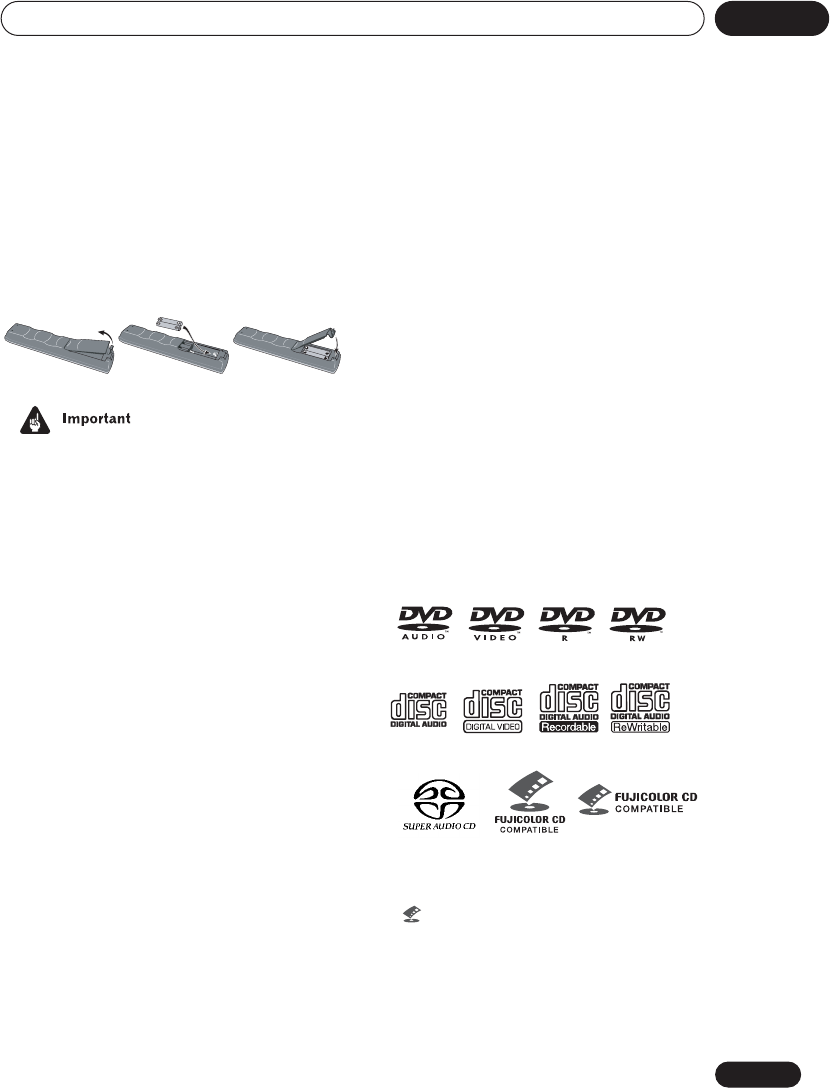
Before you start 01
9
En
Putting the batteries in the
remote control
• Open the battery compartment cover
and insert the batteries as shown.
Use two AA/R6P batteries and follow the
indications (, ) inside the compartment.
Close the cover when you’re finished.
Incorrect use of batteries can result in hazards
such as leakage and bursting. Please observe
the following:
• Don’t mix new and old batteries together.
• Don’t use different kinds of battery
together—although they may look similar,
different batteries may have different volt-
ages.
•Make sure that the plus and minus ends of
each battery match the indications in the
battery compartment.
• Remove batteries from equipment that
isn’t going to be used for a month or more.
• When disposing of used batteries, please
comply with governmental regulations or
environmental public instruction’s rules
that apply in your country or area.
H048 En
Using the remote control
Keep in mind the following when using the
remote control:
• Make sure that there are no obstacles
between the remote and the remote sensor
on the system unit.
• The remote has a range of about 23 ft. /
7 m at an angle of less than 30º.
• Remote operation may become unreliable
if strong sunlight or fluorescent light is
shining on the system unit’s remote
sensor.
• Remote controllers for different devices
can interfere with each other. Avoid using
remotes for other equipment located close
to this system.
• Replace the batteries when you notice a
fall off in the operating range of the remote.
Disc / content format playback
compatibility
This player is compatible with a wide range of
disc types (media) and formats. Playable discs
will generally feature one of the following logos
on the disc and/or disc packaging. Note
however that some disc types, such as record-
able CD and DVD, may be in an unplayable
format—see below for further compatibility
information.
• KODAK Picture CD
• is a trademark of Fuji Photo Film Co. Ltd.
DVD-Vi
deo
DVD
-
R
DVD
-
RW
Video
CD
Audio
CD
C
D-
R
C
D-R
W
DVD-A
ud
i
o
Super Audio CD Fujicolor CD

Before you start01
10
En
CD-R/RW compatibility
• This system will play CD-R and CD-RW
discs recorded in CD Audio or Video CD
format, or as a CD-ROM containing MP3 or
JPEG files. However, any other content
may cause the disc not to play, or create
noise/distortion in the output.
•This system cannot record CD-R or CD-RW
discs.
• Unfinalized CD-R/RW discs recorded as
CD Audio can be played, but the full Table
of Contents (playing time, etc.) will not be
displayed.
DVD-R/RW compatibility
• Compatible formats: DVD-Video, Video
Recording (VR)*
* Edit points may not play exactly as edited;
screen may go momentarily blank at edited
points.
• Unfinalized playback: No
•MP3/JPEG file playback on DVD-R/RW: No
PC-created disc compatibility
Discs recorded using a personal computer
may not be playable in this unit due to the
setting of the application software used to
create the disc. In these particular instances,
check with the software publisher for more
detailed information.
Discs recorded in packet write mode (UDF
format) are not compatible with this player.
Check the DVD-R/RW or CD-R/RW software
disc boxes for additional compatibility
information.
Compressed audio compatibility
•Compatible formats: MPEG-1 Audio Layer 3
(MP3)
• Sampling rates: 32, 44.1 or 48kHz
• Bit-rates: Any (128Kbps or higher recom-
mended)
• VBR (variable bit rate) MP3 playback: Yes
• VBR playback: No
• DRM (Digital Rights Management)
compatible: Yes (DRM-protected audio
files will not play in this player). See also
DRM in the Glossary on page 91.
•File extensions: .mp3 (these must be used
for the player to recognize MP3 files – do
not use for other file types)
• File structure: Up to 999 files per folder
JPEG file compatibility
• Compatible formats: Baseline JPEG and
EXIF 2.1* still image files up to 8 mega-
pixels are supported (maximum resolution
is 5120 x 5120 pixels).
*File format used by digital still cameras
• File extensions: .jpg (must be used for the
player to recognize JPEG files – do not use
for other file types)
• File structure: Up to 999 files per folder
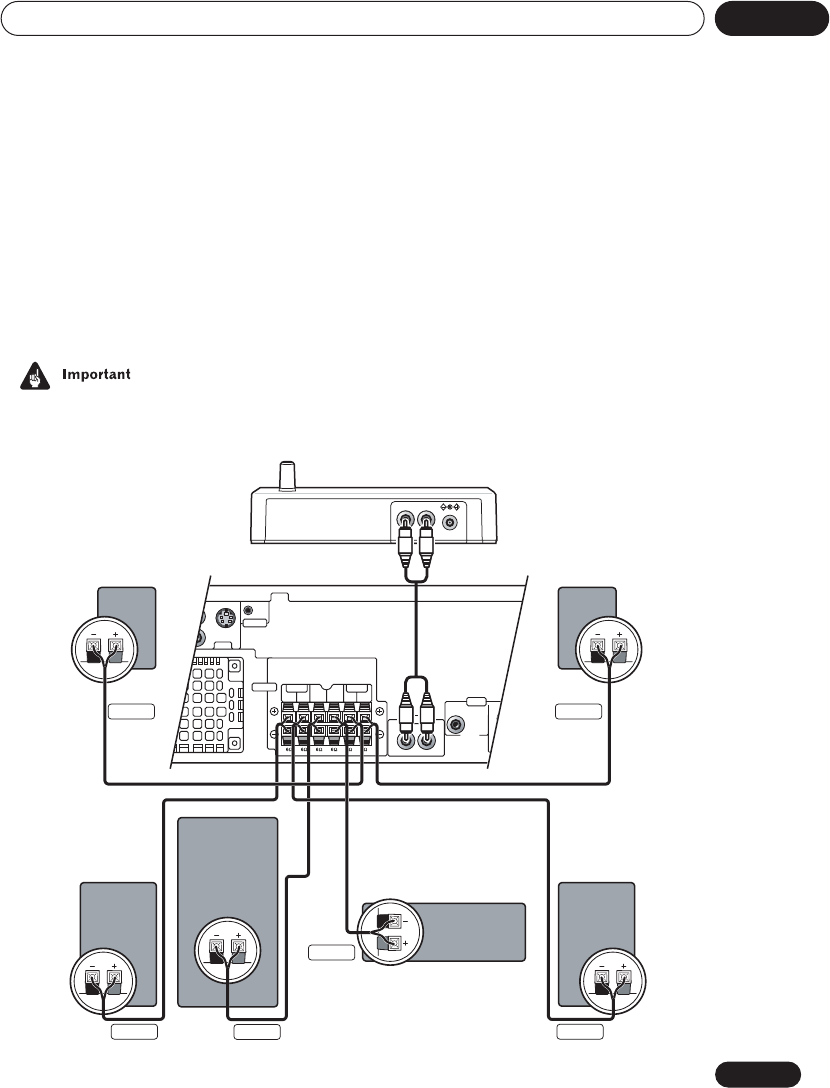
Connecting up 02
11
En
Chapter 2
Connecting up
Connecting the speakers and wireless speaker system
Connect each speaker using the color-coded speaker cable. Match them to the colored labels
above the speaker terminals. Note that surround speaker are not provided with the HTD-641DV,
but if you want, you can connect speakers with a nominal impedence of 6Ω–16Ω.
• Before making or changing any rear panel connections, make sure that all the components
are switched off and unplugged from the power supply.
AUDIO
VIDEO
CONTROL
Y
LINE 1
LINE 2
OUT IN
L
R
COAXIAL IN
CENTER
SUB
WOOFER
LRLR
FRONT
SURROUND
S-VIDEO
OUT
VIDEO
OUT
SPEAKERS
IN
WIRELESS
OUT
L
R
Front right
Surround right
(HTD-645DV only) Surround left
(HTD-645DV only)
Front left
Subwoofer
Center
RL
IN
WIRELESS
Transmitter
Gray Blue
WhiteRed Purple
XV-HTD640
Green
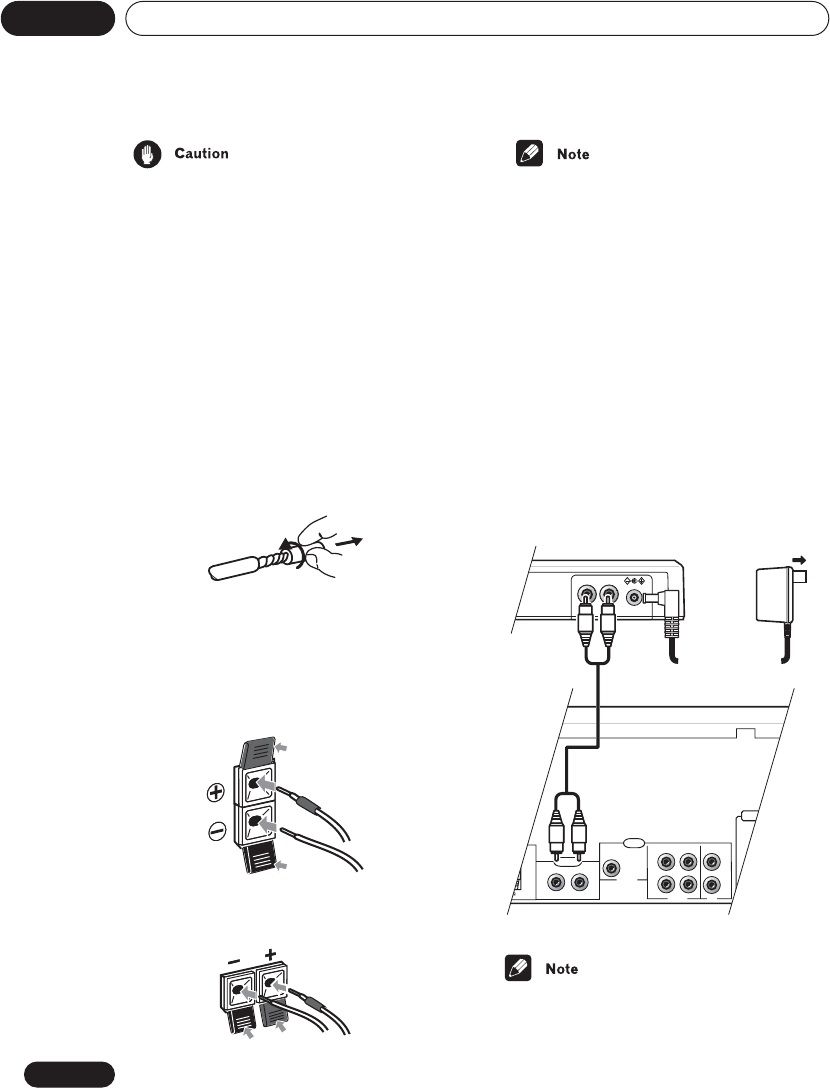
Connecting up02
12
En
• These speaker terminals can be under
HAZARDOUS VOLTAGE. When you
connect or disconnect the speaker cables,
to prevent the risk of electric shock, do not
touch uninsulated parts before
disconnecting the power cord.
• Do not connect any of the supplied
speakers to any other amplifier. This may
result in malfunction or fire. This system is
designed for best performance when
connected to the supplied speakers. We do
not, therefore, recommend connecting and
using other speakers with this system.
1Twist and pull off the protective shields
on each wire.
2Connect to the speaker terminals on the
rear of the unit.
Match the colored wire with the color-coded
label (above the tabs), then insert the colored
wire into the red (+) tab and the other wire with
the black (–) tab.
3Connect to the speaker terminals on the
rear of the speakers in the same way.
• Remove the supplied non-skid pads from
the paper, and stick four onto the base of
each satellite speaker (HTD-645DV only –
refer to the setup guide for more on this).
Actual speakers supplied may differ from
those shown.
4 Connect the WIRELESS (IN) jack on the
transmitter to the WIRELESS (OUT) jack on
the rear panel of the receiver, using the
supplied RCA stereo cord.
The wireless speaker system can be used for
multichannel sound with your main setup, or
as a second stereo speaker system.
5Connect the supplied AC adapter to the
DC IN inlet on the rear panel of the unit,
then plug into a power outlet.
• Do not use any AC adapter but the one
provided with this system.
ANTENNA
AM LOOP
ANTENNA
FM
UNBAL
75
AUDIO
LINE 1
LINE 2
TV
OUT IN IN
L
R
L
R
COAXIAL IN
L
UND
WIRELESS
OUT
LR
RL
To power outlet
XV-HTD640
Transmitter AC adaptor
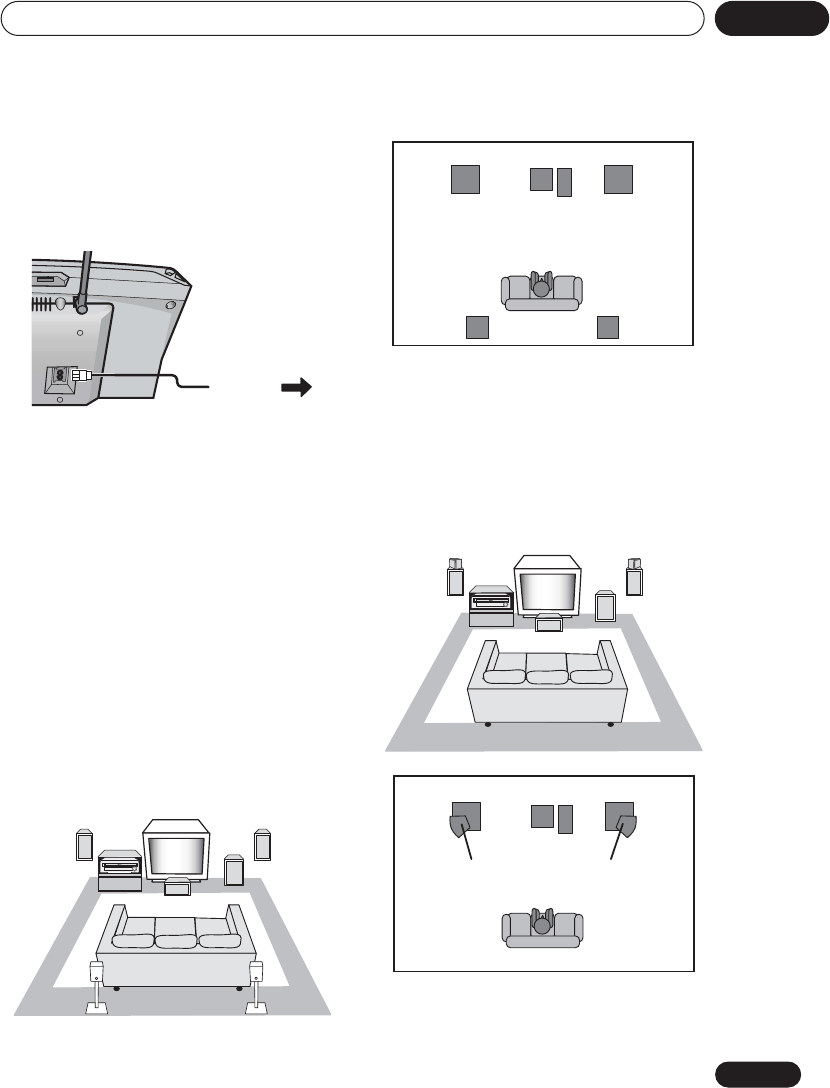
Connecting up 02
13
En
6 When you’re finished connect the
power cord to a household power outlet.
•HTD-645DV only – Before doing this, plug
the supplied power cord into the wireless
speaker AC IN inlet (see below).
Placing the speakers
Note that the HTD-641DV does not include
surround speakers. If not connected, simply set
up your speakers using the Standard surround
5-spot setup shown below, disregarding the
surround speakers in the diagram.
Depending on the size and characteristics of
your room, you can choose to place your
speakers in one of two ways using this system.
Note that the following setups are possible
when you are using the the wireless speaker as
a second stereo system (see Using the wireless
speaker system on page 41 for more on this).
•Standard surround 5-spot setup – This is
a standard multichannel surround sound
speaker setup for optimal 5.1 channel
home theatre sound.
•Front surround 3-spot setup – This setup
is ideal when rear surround speaker
placement isn’t possible or you want to
avoid running long speaker cables in your
listening area. Use this setup together with
the Front Surround modes to take
advantage of wall and ceiling reflections
for a very realistic surround effect.
Power outlet
Center
Front rightFront left Sub-
woofer
System
unit
Surround
left Surround
right
Front left
Surround
left
Listening position
Center
Subwoofer
Front right
Surround
right
Center
Front
left Front
right
Sub-
woofer
System
unit
Surround
left Surround
right
Front
left Front
right
Surround
left Surround
right
Listening position
Center
Subwoofer
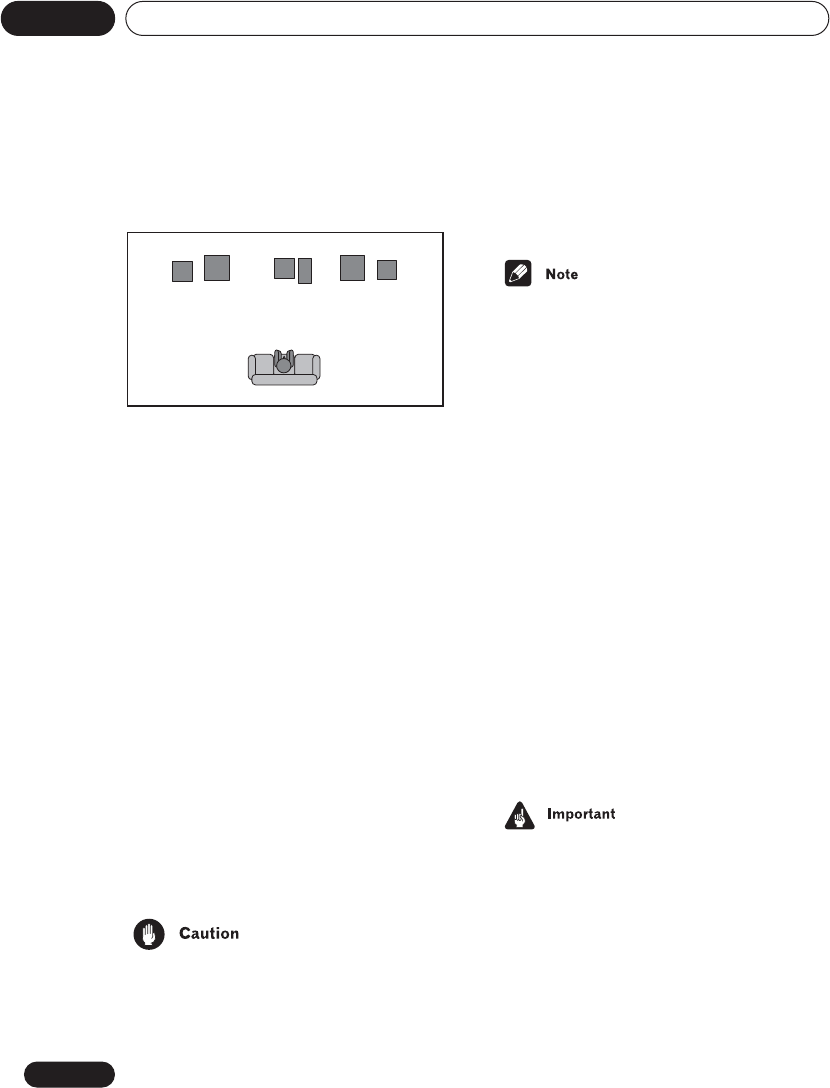
Connecting up02
14
En
The above illustrations are for the HTD-645DV
only. If you connected surround speakers to the
HTD-641DV, place them on either side of the
front speakers as shown below.
See About the listening modes on page 43 for
more on using the different listening modes
with each speaker setup.
Where you put your speakers in the room has a
big effect on the quality of the sound. The
following guidelines should help you to get the
best sound from your system.
• The subwoofer can be placed on the floor.
Ideally, the other speakers should be at
about ear-level when you’re listening to
them. Putting the speakers on the floor
(except the subwoofer), or mounting them
very high on a wall is not recommended.
• For the best stereo effect, place the front
speakers 6–9 ft. / 2–3 m apart, at equal
distance from the TV.
• Install the center speaker above or below
the TV so that the sound of the center
channel is localized at the TV screen.
• When using a 5-spot setup, install the
surround speakers slightly above ear level,
if possible.
• Make sure that all speakers are securely
installed (if you choose to install the center
speaker on top of the TV, be sure to secure
it by suitable means). This not only
improves sound quality, but also reduces
the risk of damage or injury resulting from
speakers being knocked over or falling in
the event of external shocks such as
earthquakes.
•The front, and center and surround
speakers supplied with this system are
magnetically shielded. However, placing
them extremely close to a television may
result in color distortion on the screen. If
this happens, move the speakers a little
further away and switch off the television
for 15–30 minutes.
•The subwoofer is not magnetically shielded
and so should not be placed near a TV or
monitor.
Placing the wireless speaker
system
You can choose to use the wireless speaker
system for multichannel sound with your main
setup, or as a second stereo speaker system.
The Standard surround (5-spot) setup
described in Placing the speakers above will
achieve the best surround sound when using
the wireless speaker system for multichannel
sound (the 3-spot setup is not recommended).
• After setting up the wireless speaker for
multichannel sound, see Setting the
channel levels on page 66 to lower the
surround speaker levels.
Note that the following illustration shows a
speaker setup including surround speakers,
which are not included with the HTD-641DV
model. See Connecting the speakers and
wireless speaker system on page 11 for more
on connecting surround speakers.
Front
left Front
right
Surround
left
(not supplied)
Surround
right
(not supplied)
Listening position
Center
Subwoofer
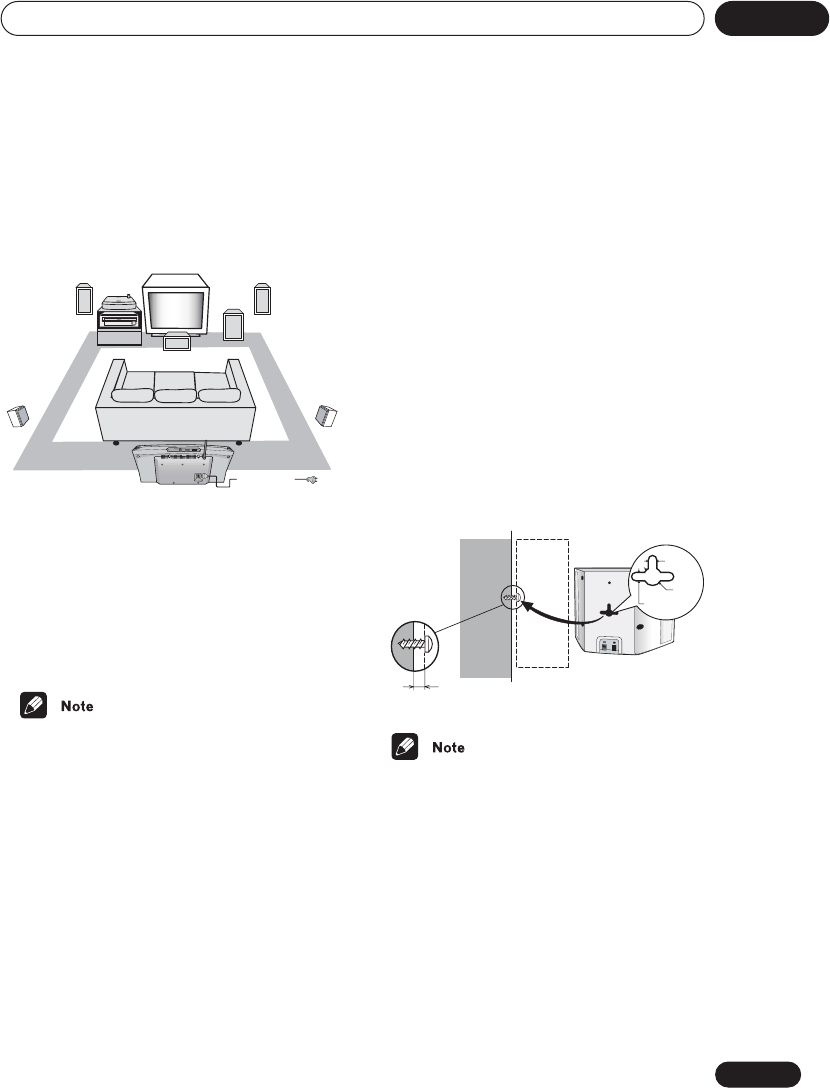
Connecting up 02
15
En
If not connected, simply set up your speakers
using the Standard surround setup as shown
below, disregarding the surround speakers in
the diagram. Using the wireless speaker, you
can still achieve exceptional surround sound
from your system.
For best surround sound, make sure to place
the wireless speaker directly behind the center
of the listening position and no higher than ear
level. Also, make sure you don't move the
wireless speaker too far behind the listening
position or you will lose much of the surround
sound effect. For more placement options, see
Using the wireless speaker system on page 41.
• For a greater surround sound effect from
the wireless speaker, see Setting the
channel levels on page 66 to increase the
surround channel levels.
•As well as setting the wireless mode on the
speakers, you must also set the mode on
the main unit. See Using the wireless
speaker system on page 41 for more on
this.
Wall-mounting the center and
surround speaker system
Surround speakers are not supplied with the
HTD-641DV. Illustration shows the HTD-645DV.
Before mounting
• Remember that the speaker system is
heavy and that its weight could cause the
wood screws to work loose, or the wall
material to fail to support it, resulting in the
speaker falling. Make sure that the wall you
intend to mount the speakers on is strong
enough to support them. Do not mount on
plywood or soft surface walls.
• Mounting screws are not supplied. Use
screws that are suitable for the wall
material and that will support the weight of
the speaker.
• If you are unsure of the qualities and
strength of the walls, consult a
professional for advice.
• Pioneer is not responsible for any
accidents or damage that result from
improper installation.
Center
Front rightFront left Sub-
woofer
Surround
left Surround
right
Wireless speaker
Transmitter/
XV-HTD640
to AC outlet
CHANNEL
Wood screw
Protrusion: 5-7mm
5 mm
5 mm 10 mm
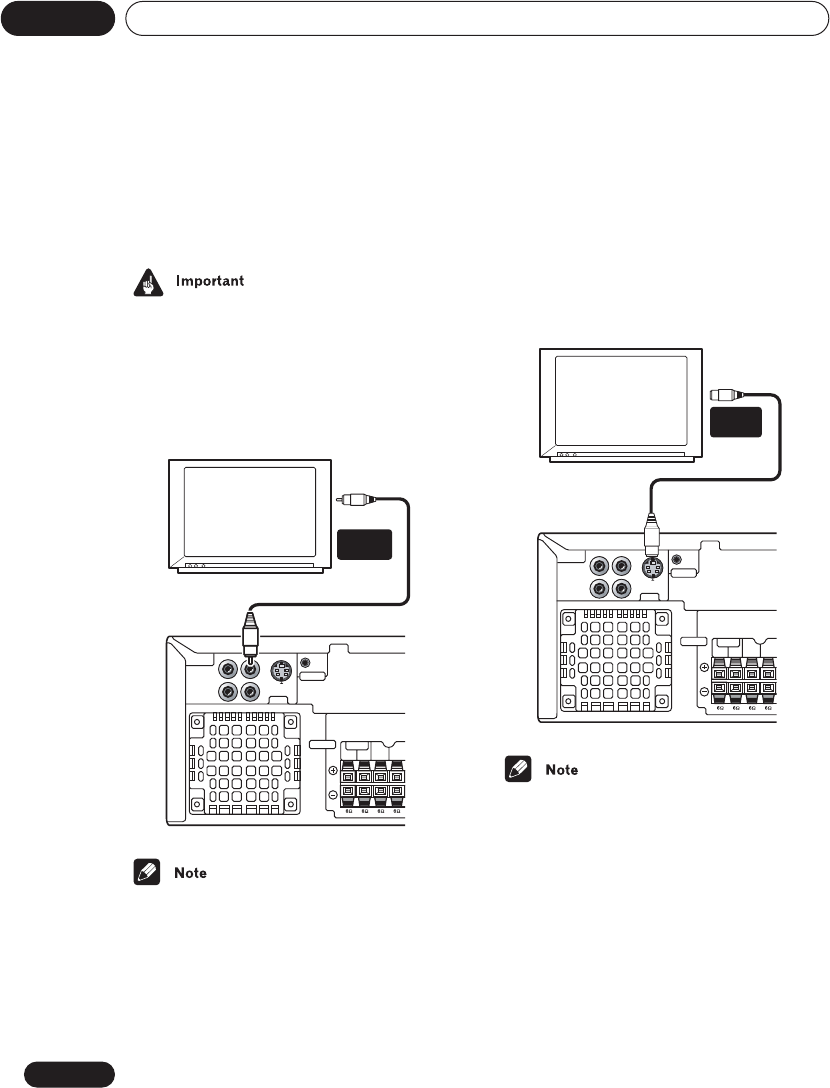
Connecting up02
16
En
Connecting to your TV
This system has three different kinds of video
output that you can use to connect up your TV.
Check the available inputs on your TV to see
which you can use.
•Do not connect a VCR between this system
and your TV as DVD playback will be
affected.
•Use the supplied video cable to connect
the VIDEO OUT jack to a video input on
your TV.
•Placing the system unit too close to your TV
may cause interference, especially if you’re
using an indoor antenna. If you notice
interference, move the system unit away
from the TV.
Connecting using the S-video output
If your TV has an S-video input, you can use this
instead of the standard video output for a
better quality picture.
• Use an S-video cable (not supplied) to
connect the S-VIDEO OUT to an S-video
input on your TV.
Line up the small triangle below the jack with
the same mark on the plug before plugging in.
• The S-video output is switchable between
S1 and S2 formats for compatibility with all
TVs. See Video Output settings on page 69
for more on this.
VIDEO
CONTROL
PR
PBY
COMPONENT
VIDEO OUT
CENTER
SUB
WOOFER
LR
FRONT
S-VIDEO
OUT
IN
VIDEO
OUT
SPEAKERS
TV
VIDEO
INPUT
VIDEO
CONTROL
PR
PBY
COMPONENT
VIDEO OUT
CENTER
SUB
WOOFER
LR
FRONT
S-VIDEO
OUT
IN
VIDEO
OUT
SPEAKERS
S-VIDEO
INPUT
TV
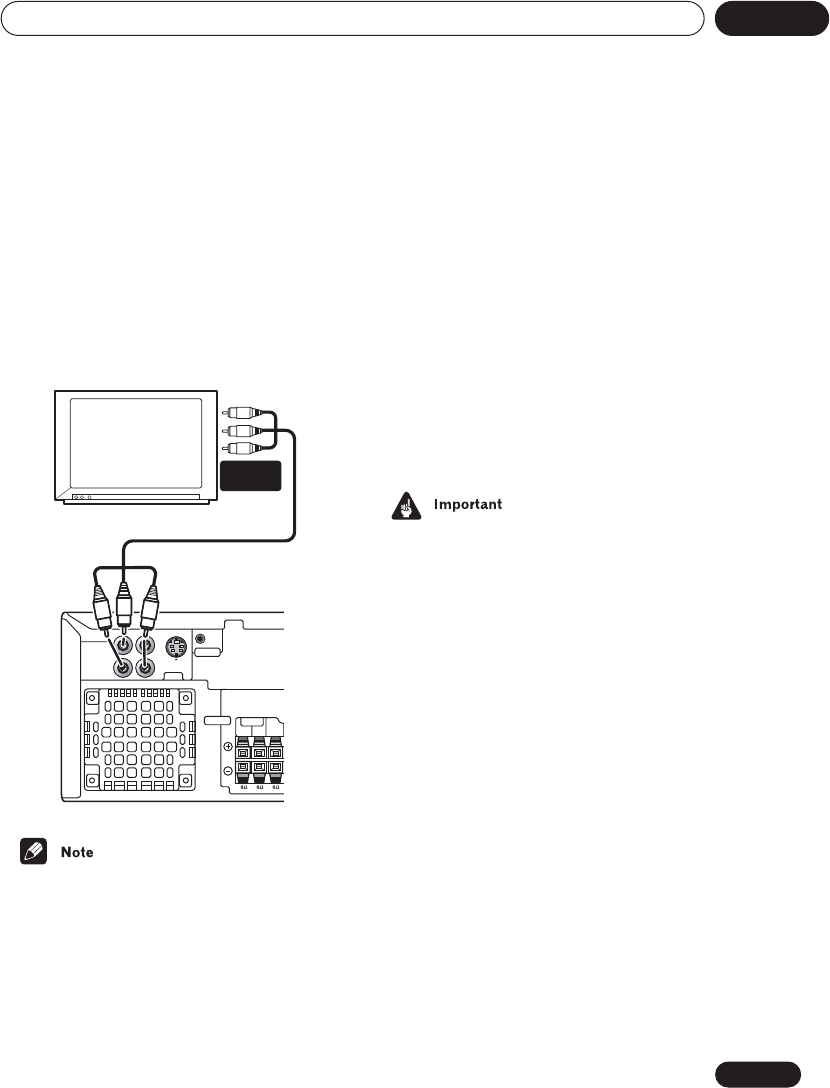
Connecting up 02
17
En
Connecting using the component
video output
If your TV has component video inputs, you can
use these instead of the standard video output
to connect this system to your TV. This should
give you the best quality picture from the three
types of video output available.
• Use a component video cable (not
supplied) to connect the COMPONENT
VIDEO OUT to a set of component inputs
on your TV.
•The component video output is switchable
between interlaced and progressive
formats. See Video Output settings on
page 69 and Watching progressive scan
video from the component video outputs
below for more on this.
Watching progressive scan video from
the component video outputs
Compared to interlace video, progressive scan
video effectively doubles the scanning rate of
the picture, resulting in a very stable, flicker-
free image. Progressive scan video is available
only from the component video output. There
are a few things to keep in mind when
switching the Component Out (page 69)
setting to Progressive:
•When set to Progressive, there is no video
output from the VIDEO OUT (composite)
and S (S-video) jacks.
• If you want to display video on more than
one monitor simultaneously, make sure
the player is set to Interlace.
• If you connect a TV that is not compatible
with a progressive scan signal and switch
the setting to Progressive, you will not be
able to see any picture at all. In this case,
press STANDBY/ON to put the system
in standby, then press and hold the front
panel (stop) button for about 8 seconds
until the display shows Mem.Clr.?. Press
the front panel or button
so that the display shows Interlace?. Press
the front panel button to set to
interlace and switch the system back on.
Compatibility of this player with
progressive-scan and high-definition TVs
This player is compatible with progressive
video Macro Vision System Copy Guard.
Consumers should note that not all high-
definition television sets are fully compatible
with this product and may cause artifacts to be
displayed in the picture. In case of 525
progressive scan picture problems, it is
recommended that the user switch the
connection to the ‘standard definition’ output
(Interlace).
VIDEO
CONTROL
PR
PBY
COMPONENT
VIDEO OUT
SUB
WOOFER
LR
FRONT
S-VIDEO
OUT
VIDEO
OUT
SPEAKERS
IN
TV
COMPONENT
INPUT
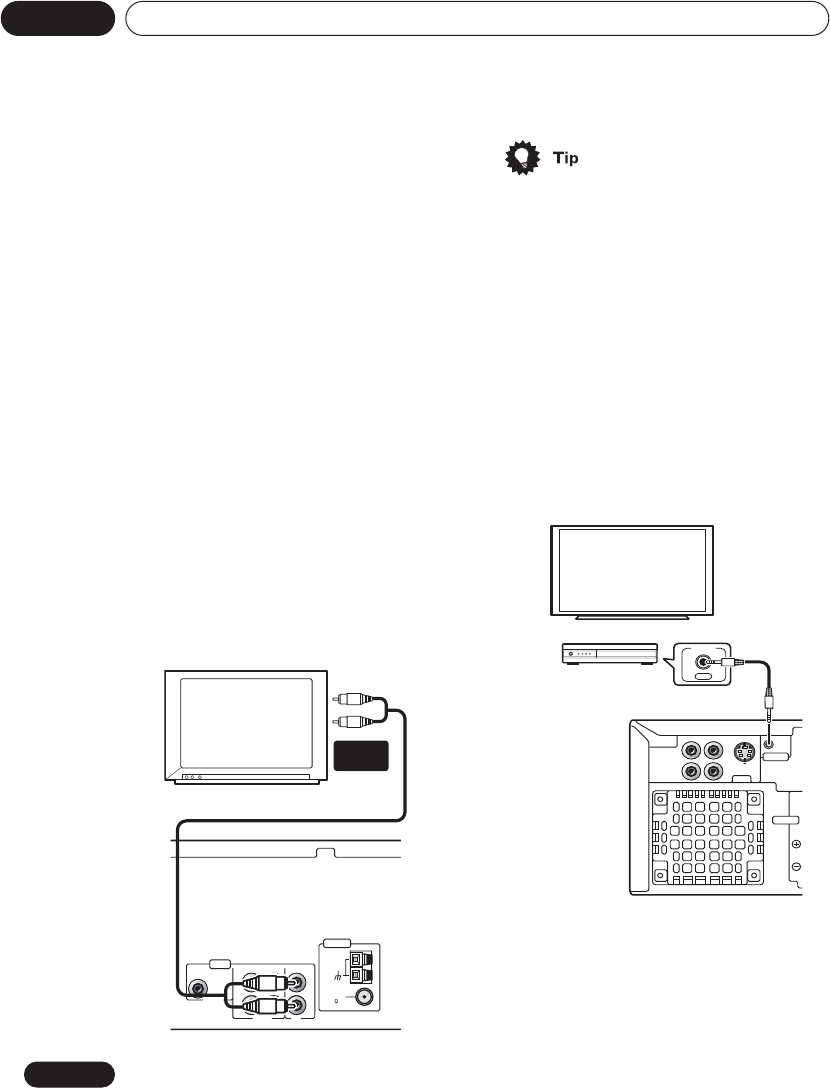
Connecting up02
18
En
If there are questions regarding our TV set
compatibility with this model, please contact
our customer service center.
This system is compatible with the following
Pioneer displays and monitors:
Plasma display
PDP-505HD, PDP-5030HD, PDP-4330HD, PDP-
5040HD, PDP-4340HD, PRO-10000HD, PRO-
800HD, PRO-1000HDI, PRO-800HDI, PRO-
1110HD, PRO-910HD, PDP-4300, PDP-5031
Projection monitor receiver
SD-533HD5, SD-643HD5, PRO-710HD, PRO-
610HD, PRO-510HD, PRO-720HD, PRO-620HD,
PRO-520HD, PRO-730HD, PRO-630HD, PRO-
530HD, PRO-730HDI, PRO-530HDI
Listening to TV audio through this
system
You can connect the audio output of your TV to
this system so that broadcast TV sound is
played through this system.
• Connect a stereo audio cable (not
supplied) from the audio outputs of your
TV to the TV IN jacks on this system.
• If you find that the TV audio is distorting
when played through this system, you can
set the input attenuator to reduce the input
signal level. See Optional system settings
on page 74 to do this.
Using this unit with a Pioneer
plasma display
If you have a Pioneer plasma display (models
PRO-1110HD, PRO-910HD, PDP-5040HD,
PDP-4340HD), you can use an SR+ cable (see
note below) to connect it to this unit and take
advantage of various convenient features,
such as automatic video input switching of the
plasma display when the input is changed.
AUDIO
ANT ENNA
AM LOOP
ANT ENNA
FM
UNBAL
75
LINE 1
LINE 2
TV
OUT IN IN
L
R
L
R
COAXIAL IN
TV
AUDIO
OUTPUT
VIDEO
CONTROL
P
R
P
B
Y
COMPONENT
VIDEO OUT
S-VIDEO
OUT
VIDEO
OUT
SPEAKERS
OUT
CONTROL
Pioneer plasma display
Media receiver
IN

Connecting up 02
19
En
• Use a 3-ringed miniplug SR+ cable to
connect the CONTROL IN jack of this unit
through a media receiver to the CONTROL
OUT jack of your plasma display.
Before you can use the extra SR+ features, you
need to make a few settings in the unit. See
SR+ control options for Pioneer plasma displays
on page 65 for detailed instructions.
Using the SR+ mode with a Pioneer
plasma display
When connected using an SR+ cable, a
number of features (such as automatic video
input switching and volume muting on the
plasma display) become available to make
using this unit with your Pioneer plasma
display even easier.
See also SR+ control options for Pioneer
plasma displays on page 65 for information on
setting up the unit.
1Make sure that the plasma display and
this unit are switched on and that they are
connected with an SR+ cable.
See Using this unit with a Pioneer plasma
display above for more on connecting these
components.
2To switch SR+ mode on/off, press SR+
(SHIFT + 7).
The front panel display shows the new setting;
SR+ ON or SR+ OFF.
• If SR+ Error shows in the display, it means
there is a communication problem
between the unit and the plasma display.
Check all connections and retry.
• The 3-ringed SR+ cable from Pioneer is
commercially available under the part
number ADE7095. Contact the Pioneer
Customer Support division for more
information on obtaining an SR+ cable.
•You won’t be able to use the remote sensor
of this unit with the CONTROL IN jack of
this unit connected to the CONTROL OUT
jack of your plasma display. You can use
the remote sensor of the plasma display
(even in standby) as long as the power isn’t
switched off.
• The automatic volume muting feature is
enabled separately; see SR+ control
options for Pioneer plasma displays on
page 65. (You can also use the System
Setup menu to switch the SR+ mode of
this unit.)
•If you disconnect the SR+ cable or switch
the plasma display off while SR+ is on, the
setting automatically reverts to SR+ OFF.
This displays an error if you switch the
input of the unit with the plasma display
switched off. Likewise, if this unit is
switched off, the link with the plasma
display will be terminated.
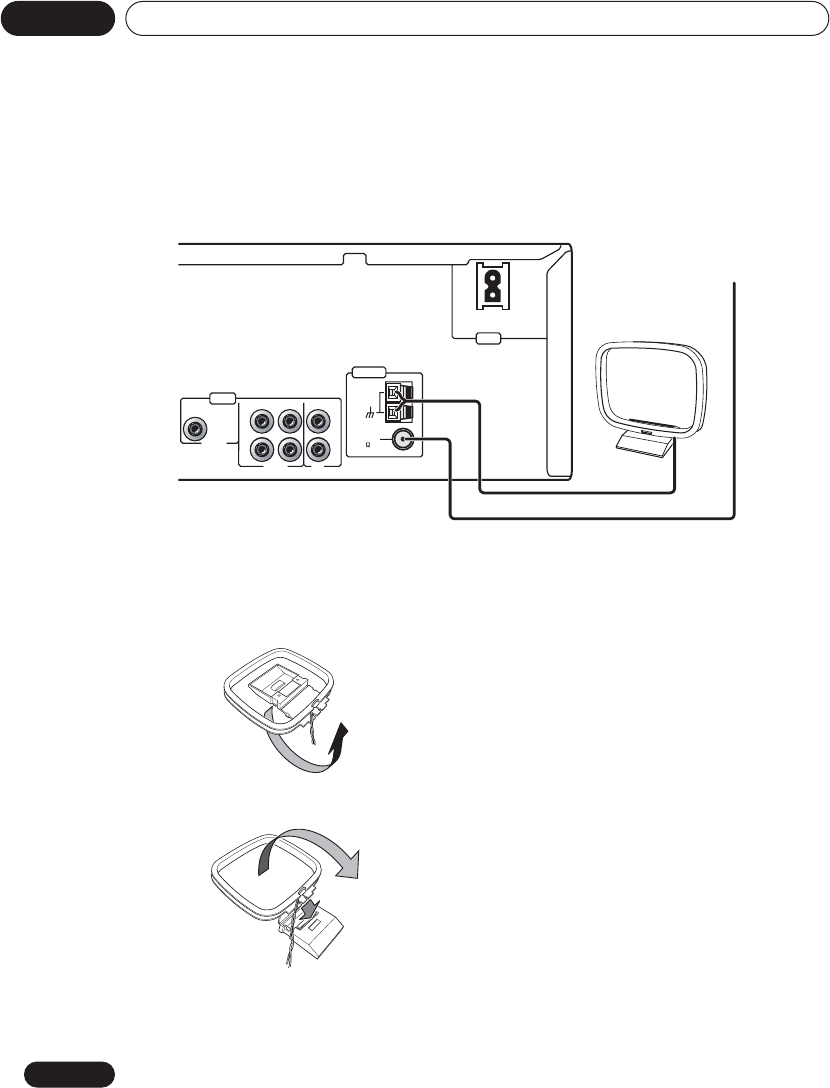
Connecting up02
20
En
Connecting the supplied antennas
The supplied antennas provide a simple way to listen to AM and FM radio. If you find that reception
quality is poor, an outdoor antenna should give you better sound quality—see Connecting external
antennas on page 80 for more on how to do this.
Assembling the loop antenna
1 Bend the stand in the direction
indicated.
2 Clip the loop onto the stand.
AM loop antenna
1 Pull off the protective shields of both
AM antenna wires.
2Press the antenna terminal tabs to open
and insert one wire into each terminal.
3 Release the tabs to secure the AM
antenna wires.
4Place the AM antenna on a flat surface
and point in the direction giving the best
reception.
Avoid placing near computers, television sets
or other electrical appliances and do not let it
come into contact with metal objects.
AUDIO
ANTENNA
AC IN
AM LOOP
ANTENNA
FM
UNBAL
75
LINE 1
LINE 2
TV
OUT IN IN
L
R
L
R
COAXIAL IN
AM loop antenna
FM wire (PAL)
antenna
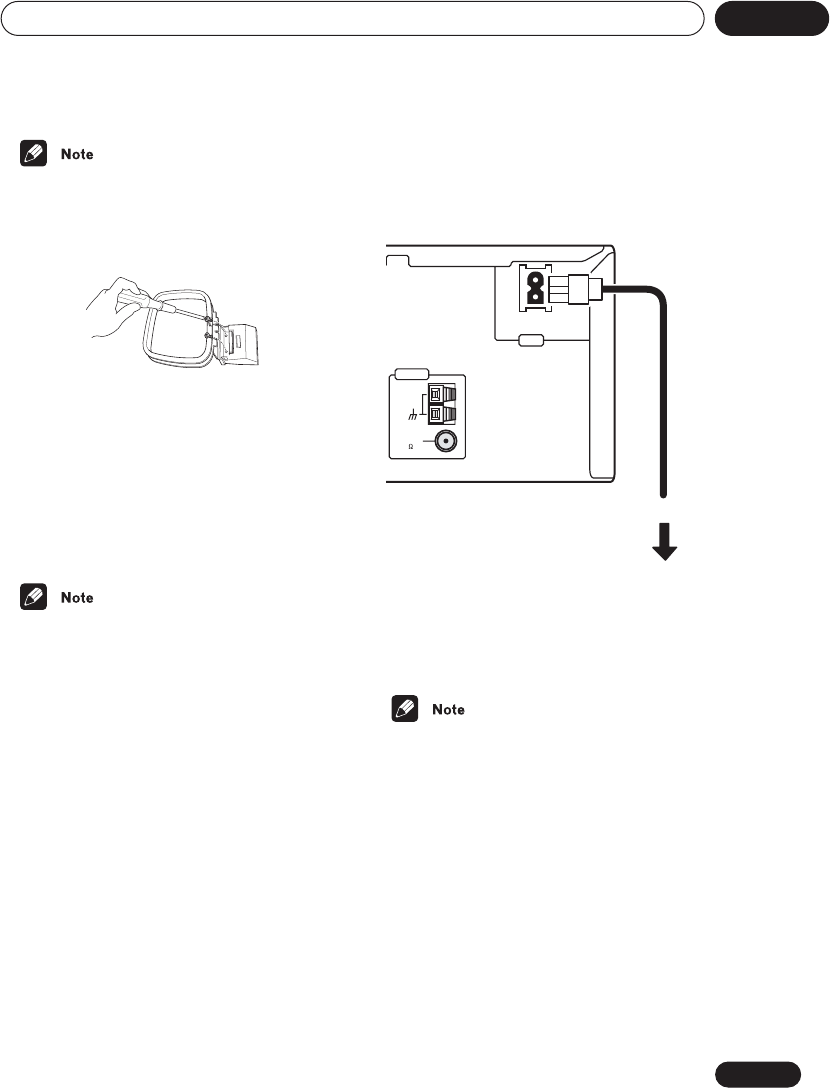
Connecting up 02
21
En
•It’s also possible to fix the AM antenna to a
wall using two screws (see illustration
below). Before fixing, make sure that the
reception is satisfactory.
FM wire antenna
•Connect the FM wire antenna to the FM
UNBAL 75Ω terminal in the same way as
the AM loop antenna.
For best results, extend the FM antenna fully
and fix to a wall or door frame. Don’t drape
loosely or leave coiled up.
• The signal ground () is designed to
reduce noise that occurs when an antenna
is connected. It is not an electrical safety
ground.
Connecting the power
Before connecting the power and switching on
for the first time make sure that everything is
connected properly.
1 Plug one end of the supplied power
cord into the AC INLET.
2 Plug the other end into a household
power outlet.
• See Connecting auxiliary components on
page 81 for details of other connections
you can make with this system.
ANTENNA
AC IN
AM LOOP
ANTENNA
FM
UNBAL
75
Power outlet
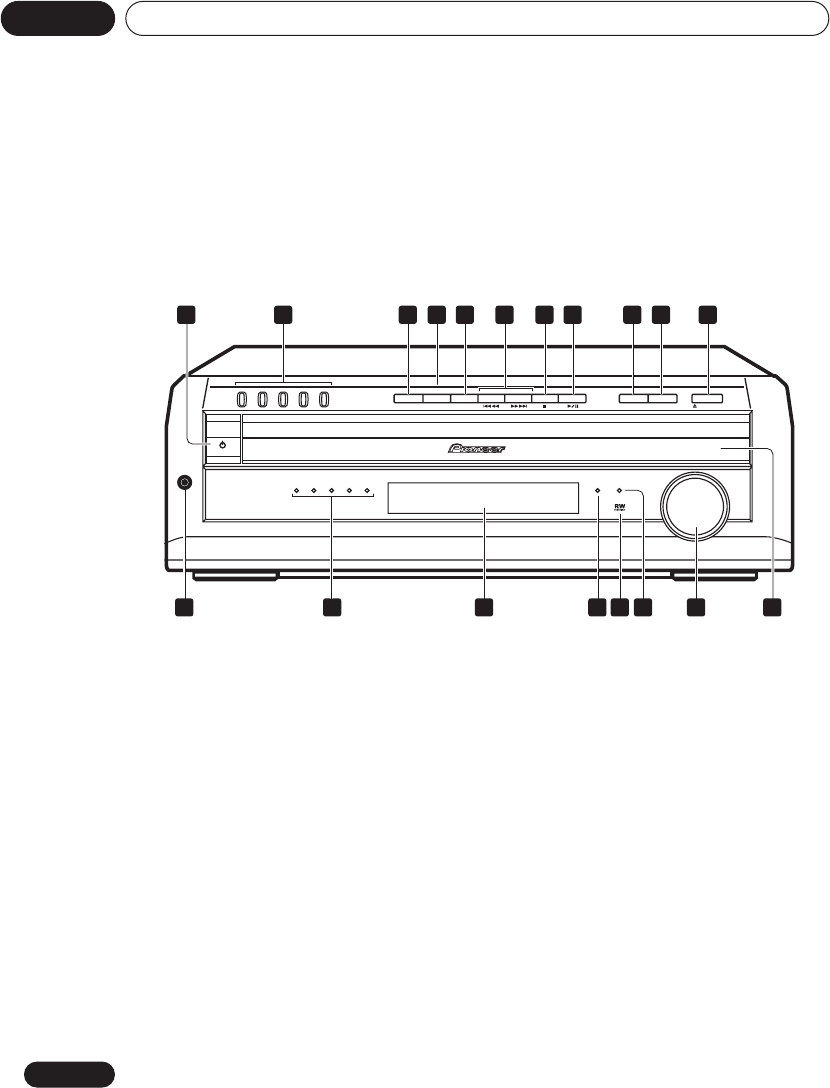
Controls and displays03
22
En
Chapter 3
Controls and displays
Front panel
1 STANDBY/ON (page 30)
Press to switch the system on or into standby.
2 DIRECT PLAY buttons (page 34)
Press to start playback of any disc in the
player.
3 DVD/CD (page 33)
Press to switch to the DVD/CD function. Also
starts/pauses/resumes playback of the
currently loaded disc.
4 TUNER FM/AM/ST. (page 39)
Press to switch to the tuner function, then
between bands and station presets.
5 TV/L1/L2 (page 40)
Press to switch between the external sources,
TV, LINE 1 (L1) and LINE 2 (L2).
6 and
Press to skip tracks/chapters; press and hold
to scan backwards/forwards.
•When in listening to the tuner, use to tune
to stations or select presets.
7
Press to stop playback.
8
Press to start or resume playback. During
playback, press to pause; press again to
restart playback.
9 DISC SKIP (page 34, 36)
•During playback, press to start playing the
next disc in the player.
• If the disc tray is open while no disc is
playing, the tray rotates one disc space.
• If the disc tray was opened using the
EXCHANGE button, then pressing DISC
SKIP rotates the disc tray two disc spaces.
PHONES
STANDBY/ON
DOWN
VOLUME
CD MODE TIMER
UP
DVD/CD TUNER TV/L1/L2
FM/AM/ST.
DIRECT PLAY
DISC SKIP EXCHANGE OPEN/CLOSE
1234
5
DISC 12345
1
19 1418 17 15 13 12
2 3 4 5 7 8
910 11
6
16
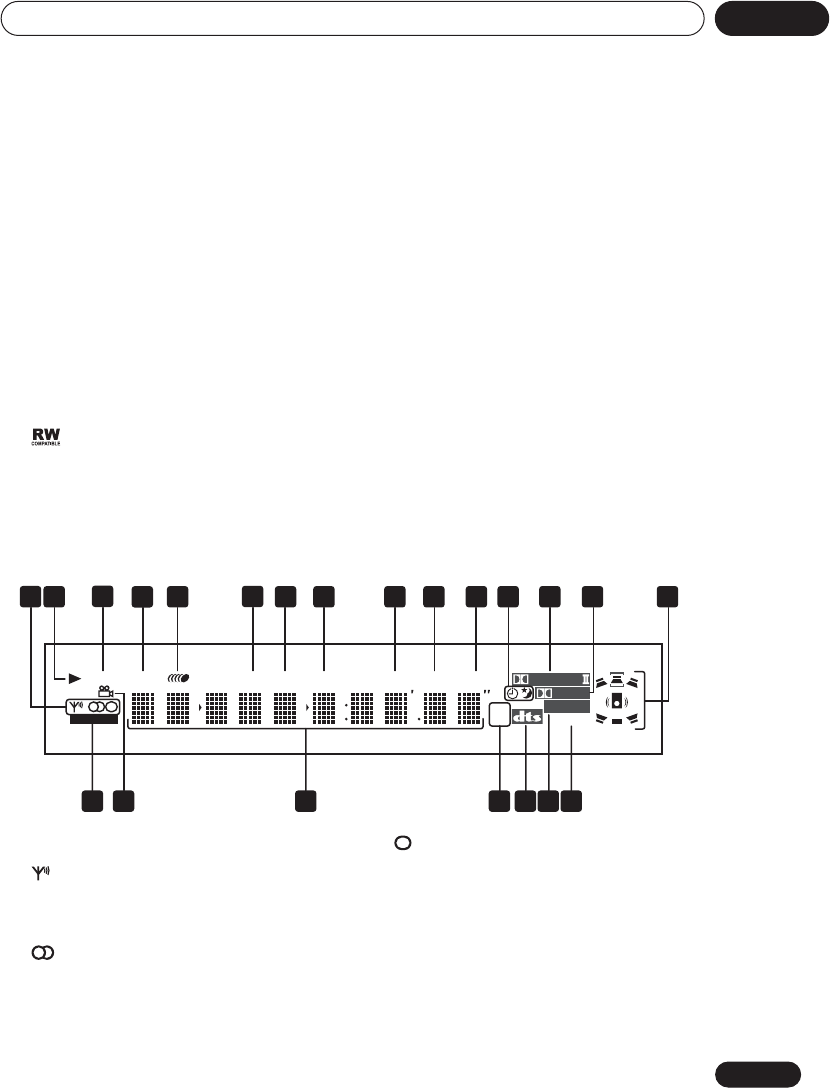
Controls and displays 03
23
En
10 EXCHANGE (page 36)
Press during playback to open the disc tray
without stopping playback. Press again to
close the disc tray.
11 OPEN/CLOSE
Press to open/close the disc tray.
12 Disc tray
13 VOLUME control
Use to adjust the volume.
14 Timer indicator (page 62)
Lights when the timer is set.
15
This mark indicates compatibility with DVD-
RW discs recorded on a DVD recorder in
Video Recording (VR) mode.
16 CD MODE indicator (page 49)
Lights when the CD Mode is on. In this mode,
the system only plays audio CDs and MP3
discs.
17 Display
See Display on page 23 for detailed
information.
18 DISC indicators
Shows which disc spaces are currently
occupied.
19 PHONES jack
Headphone jack.
Display
1 Tuner indicators (page 39)
Lights when a broadcast is being
received.
Lights when a stereo FM broadcast is
being received in auto stereo mode.
Lights when FM mono reception is
selected.
2
Lights when a disc is playing.
3 MIDNIGHT (page 47)
Lights when the Midnight mode is selected.
4 QUIET (page 47)
Lights when the Quiet mode is selected.
MIDNIGHT QUIET PGMMANNER RPT - 1 RDM V.PART ATT REC MODE
kHz ADV.SURR.
Neo:6
DIGITAL
MHz PRGSVE
PRO LOGIC
WIRELESS
161718192022 21
2
134675 8 9 10 11 12 13 14 15
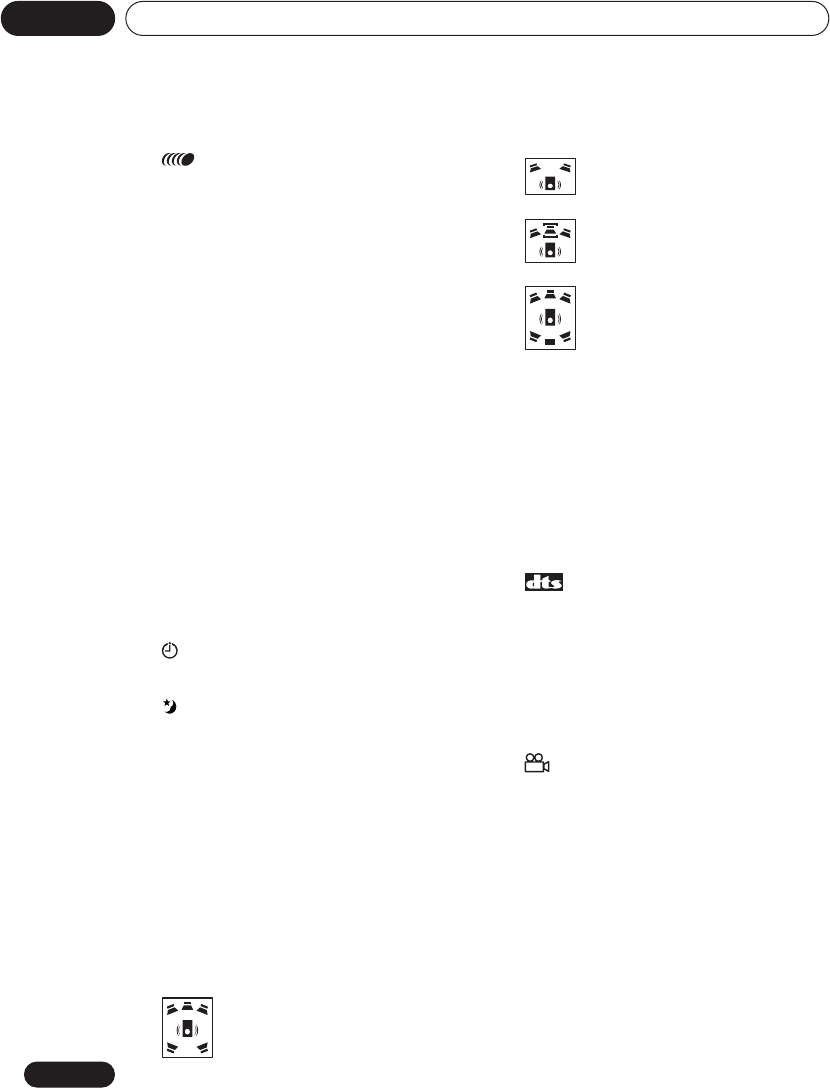
Controls and displays03
24
En
5
Lights to indicate random or repeat play of all
discs loaded.
6 PGM (page 53)
Lights when a program list has been
programmed.
7 RPT and RPT-1 (page 52)
RPT lights during repeat play. RPT-1 lights
during repeat one-track play.
8 RDM (page 52)
Lights during random play.
9 V.PART
Lights when playing a video part of a DVD
disc.
10 ATT (page 74)
Lights when the input attenuator is active for
the currently selected analog input.
11 REC MODE (page 81)
Lights when Rec Mode is on.
12 Timer indicators (page 62)
Lights when the timer is set
Lights when the sleep timer is active
13 2 PRO LOGIC II (page 44)
Lights during Dolby Pro Logic II decoding.
14 2 DIGITAL (page 44)
Lights during playback of a Dolby Digital
source.
15 Speaker indicators
These show which speakers are being used to
output the current source (they are not
placement diagrams). The illustrations below
show some example displays.
(When headphones are connected, none of
the speaker indicators are lit.)
16 PRGSVE (page 69)
Lights when progressive scan video output is
selected.
17 ADV.SURR. (page 45)
Lights when one of the Advanced or Front
Surround listening modes is selected.
18 (page 44)
Lights during playback of a DTS source.
19 kHz / MHz
Indicates the unit of the frequency shown in
the character display (kHz for AM, MHz for
FM)
20 Character display
21 (page 58)
Lights during multi-angle scenes on a DVD
disc.
22 WIRELESS
Lights when the W.Surr. mode is selected
(see Using the wireless speaker system on
page 41).
5.1 channel surround sound
Stereo (2.1 channel) sound
3.1 channel sound with Dialogue
enhancement on the center
channel
5.1 channel surround sound with
Virtual Surround Back mode active
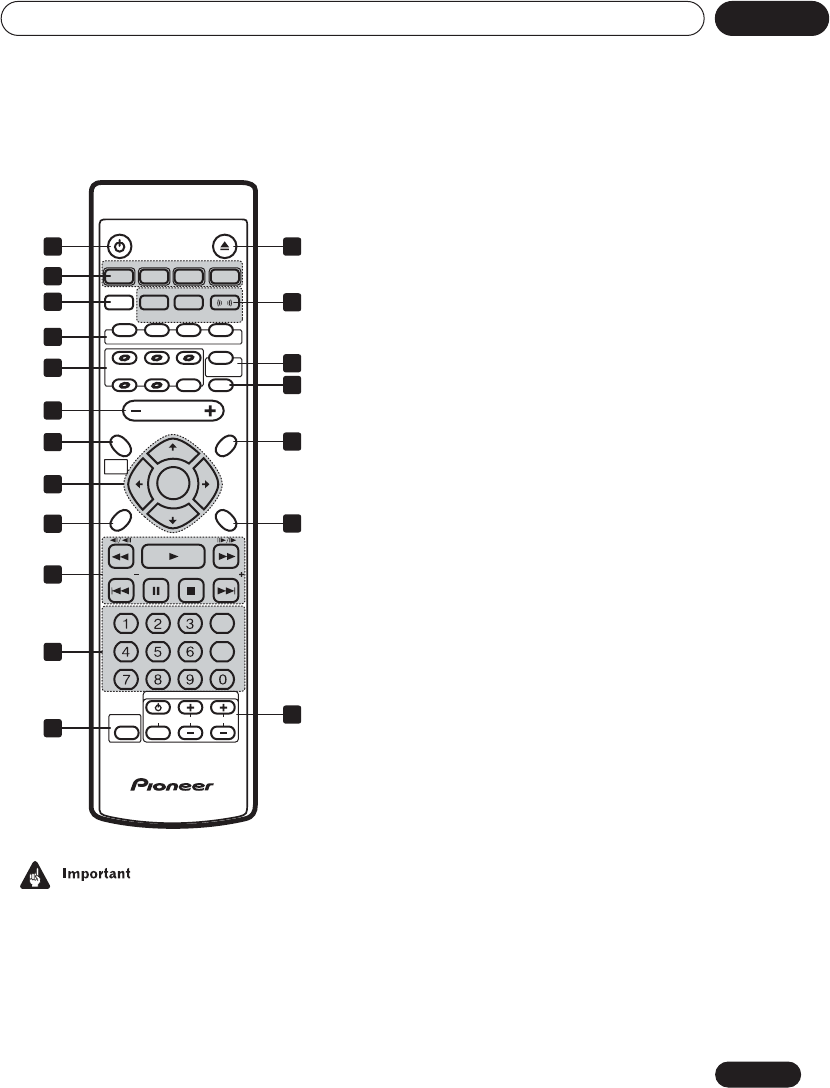
Controls and displays 03
25
En
Remote control
• Functions printed in green on the remote
control are accessed using the SHIFT
button. Press the function button you want
while holding down SHIFT.
1 STANDBY/ON (page 30)
Press to switch the system on or into standby.
2 OPEN/CLOSE
Press to open/close the disc tray.
3 Function select buttons
Press to select the source you want to listen to
(DVD/CD, TUNER, TV, LINE).
4 SOUND MODE
Press to access the sound menu, from which
you can adjust the DSP effect level, bass and
treble, etc. (pages 44–48) Also switches the
recording mode on/off (page 81).
5 Surround sound and enhancement
buttons
SURROUND (page 44)
Use to select a Surround mode.
DIALOGUE (SHIFT + SURROUND)
(page 47)
Use to select a Dialogue mode.
ADVANCED (page 45)
Use to select an Advanced Surround
mode.
VIR. SB (SHIFT + ADVANCED) (page 47)
Press to switch the Virtual Surround Back
speaker effect on/off.
FRONT SURROUND (page 45)
Use to select a Front Surround listening
mode.
BASS MODE (SHIFT + FRONT
SURROUND) (page 48)
Use to select a Bass Mode.
6 DVD buttons
AUDIO (page 57)
Press to select an audio channel or
language.
SUBTITLE (page 57)
Press to display/change the subtitle
display.
TUNE +
ST +ST –
TUNE –
OPEN/CLOSE
STANDBY/ON
L1/L2FM/AM
AUDIO
SUBTITLE
ANGLE ZOOM
WIRELESS
FOLDER
MUTE
SYSTEM SETUP
HOME
MENU
TOP MENU
DVD MENU
RETURN
SHIFT
QUIET/
MIDNIGHT
ROOM
SETUP
VOLUME
DVD/CD
CLEAR
ENTER
ENTER
TUNER
TV LINE
BASS MODE
SURROUND ADVANCED
CD MODE
DISC SKIP
SOUND
MODE
FRONT
SURROUND
DIALOGUE VIR.SR
FOLDER
PROGRAM
REPEAT RANDOM
TV CONTROL
TEST TONE CH LEVEL
TIMER
DISPLAYSR +
DISC 1 DISC 2
DISC 4 DISC 5
DISC 3
SURROUND
5.1ch DVD SYSTEM
DIMMER
CHANNELINPUT VOLUME
1
3
4
6
8
11
10
13
14
16
17
19
2
5
7
9
12
15
18

Controls and displays03
26
En
ANGLE (page 58)
Press to change camera angle during DVD
multi-angle scene playback.
ZOOM (page 58)
Press to change the screen zoom level.
7 ROOM SETUP (page 31)
Press to start Room Setup.
WIRELESS (SHIFT+ROOM SETUP)
Press to switch between surround modes
with the wireless speaker system (see
Using the wireless speaker system on
page 41).
8 Disc selection buttons
DISC select buttons (page 33)
Use to select discs in the player.
DISC SKIP / CD MODE
•During playback, press to start playing the
next disc in the player.
• If the disc tray is open while no disc is
playing, the tray rotates one disc space.
• If the disc tray was opened using the
EXCHANGE button (front panel only), then
pressing DISC SKIP rotates the disc tray
two disc spaces. (page 34, 36)
• Use with SHIFT for CD MODE: Use to
switch CD Mode on/off. (page 49)
9 MUTE
Press to mute all sound from the speakers and
headphones (press again to cancel).
10 VOLUME
Use to adjust the volume.
11 HOME MENU / SYSTEM SETUP
• Press to display (or exit) the on-screen
menu for Initial Settings, Play Mode
functions, etc.
•Use with SHIFT for SYSTEM SETUP: Use to
make various system and surround sound
settings. (page 64)
12 DVD MENU / TOP MENU
•Press to display a DVD-Video disc menu, or
the Disc Navigator if a VR mode DVD-RW,
CD, Video CD, MP3 or JPEG disc is loaded.
• Use with SHIFT for TOP MENU: Use to
display the top menu of a DVD disc in the
play position (this may be the same as
pressing DVD MENU).
13 Cursor buttons, ENTER and tuning
buttons
Cursor buttons
Use the cursor buttons (///) to
navigate on-screen displays and menus.
ENTER
Press to select an option or execute a
command.
TUNE +/–
Use to tune the radio.
ST +/–
Use to select station presets when
listening to the radio.
14 QUIET/MIDNIGHT (page 47)
Use to select Quiet and Midnight listening
modes.
15 RETURN
Press to return to a previous menu screen.
16 Playback controls
Press to start or resume playback.
and /
Use for reverse slow motion playback,
frame reverse and reverse scanning.
and /
Use for forward slow motion playback,
frame advance and forward scanning.

Controls and displays 03
27
En
/ FOLDER –
Press to jump to the beginning of the
current chapter/track, then to previous
chapters/tracks.
Press SHIFT + to jump to the
beginning of the previous folder
/ FOLDER +
Press to jump to the next chapter/track (or
folder by pressing SHIFT + ).
Press to pause playback; press again to
restart.
Press to stop playback.
17 Number buttons and SHIFT functions
Use the number buttons for selecting
chapters/tracks from a disc directly; use with
the SHIFT button to access the functions
printed in green.
PROGRAM (SHIFT + 1) (page 53)
Use to program/play a program list.
REPEAT (SHIFT + 2) (page 52)
Use to select a repeat play mode.
RANDOM (SHIFT + 3) (page 52)
Use to select a random play mode.
TEST TONE (SHIFT + 4) (page 66)
Use to output the test tone (for speaker
setup).
CH LEVEL (SHIFT + 5) (page 66)
Use to adjust the speaker level.
TIMER (SHIFT + 6) (page 62)
Press to display the clock and to access the
timer menu.
SR+ (SHIFT + 7) (page 19)
Press to switch SR+ on or off.
DISPLAY (SHIFT + 8) (page 58)
Press to display/change disc information
shown on-screen.
DIMMER (SHIFT + 9)
Press to switch between normal and
dimmed front panel display.
CLEAR
Press to clear an entry.
ENTER
Press to select menu options, etc. (works
exactly the same as the ENTER button in 13
above).
18 TV CONTROL buttons
These buttons are dedicated to control the TV
assigned to the TV button.
Use to turn on/off the power of the TV.
INPUT
Use to select the TV function.
TV CHANNEL +/–
Use to select channels.
TV VOLUME +/–
Use to adjust the volume on your TV.
19 SHIFT
Use to access the functions/commands
printed in green on the remote (press the
button for the function you want while holding
down SHIFT).
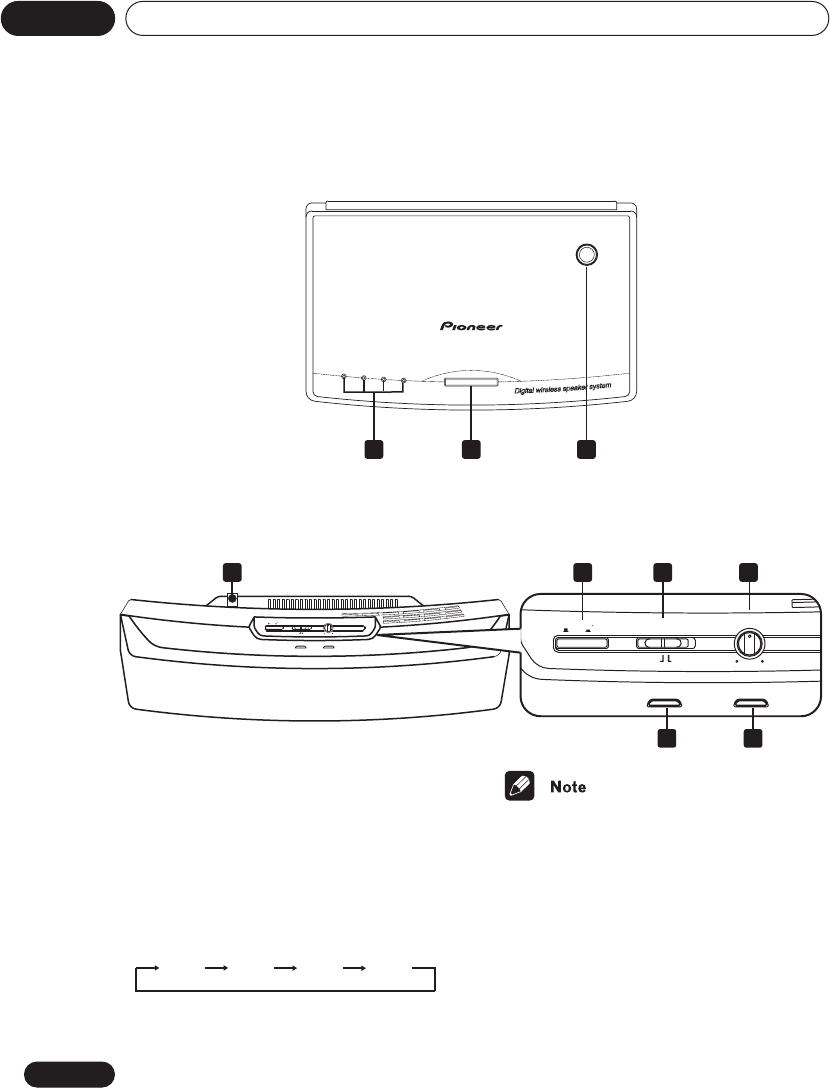
Controls and displays03
28
En
Transmitter (HTD-645DV)
With the HTD-641DV model, please refer to the XW-HTD630 wireless speaker manual.
Wireless speaker (HTD-645DV)
With the HTD-641DV model, please refer to the XW-HTD630 wireless speaker manual.
1 CHANNEL indicators
Light to indicate the selected channel.
2 CHANNEL
In case of poor reception due to interference
from other electrical devices, you can improve
reception by selecting another channel. Each
time you press the button, the channel
changes sequentially:
• Poor reception may cause the audio to be
interrupted or to disappear completely.
This is not a malfunction. Try changing the
location or orientation of the transmitter
and/or the wireless speaker to improve
reception.
• The wireless speaker can be used at
distances of up to 10m from the
transmitter. This range may change
depending on the environment.
CHANNEL
1234
21 3
W.SURROUND W.STEREO
WIRELESS
MODE
STEREO MODE
VOLUME
MIN MAX
TUNED
POWER
POWER
OFF ON
W.SURROUND W.STEREO
WIRELESS
MODE
STEREO MODE
VOLUME
MIN MAX
TUNED
POWER
POWER
OFF ON
6
5 7
8
4
9
CH 2 CH 3 CH 4
CH 1
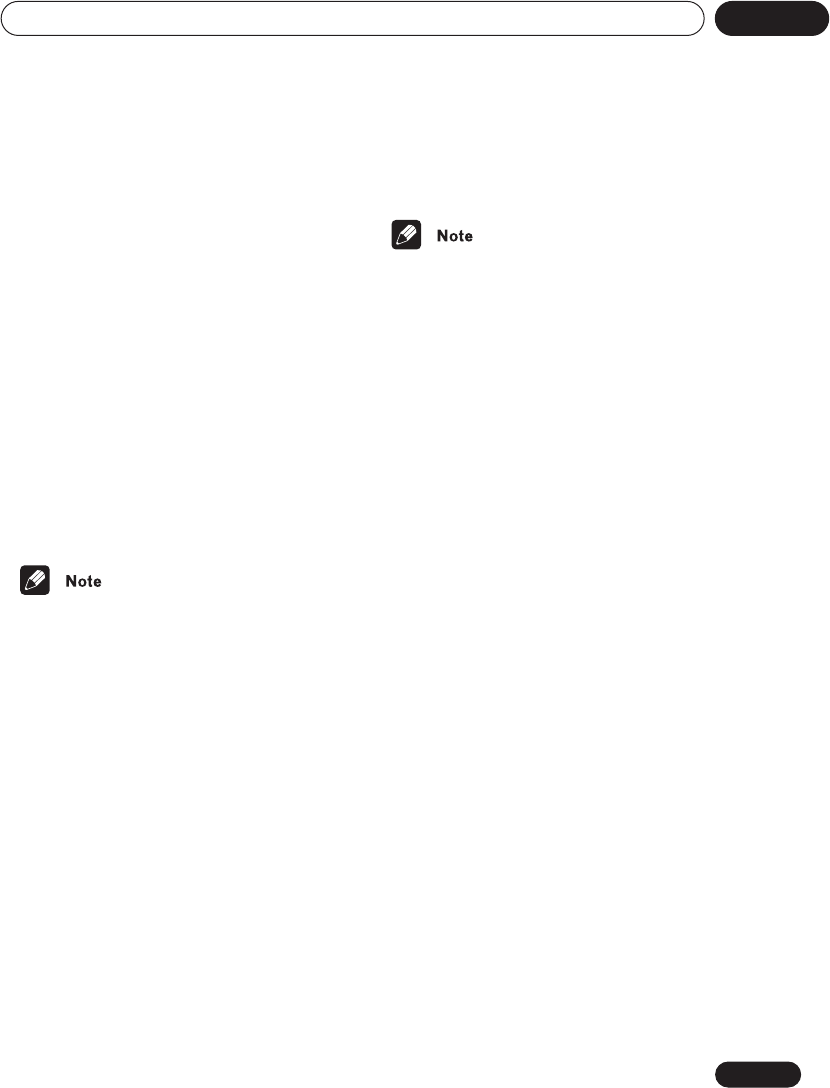
Controls and displays 03
29
En
3 Transmitter antenna
Transmits signals to the wireless speaker.
4 Wireless speaker antenna
Receives signals from the transmitter.
5 POWER
Press to switch the unit on or off.
6 WIRELESS MODE switch
Slide to select either W.SURROUND or
W.STEREO mode. See Using the wireless
speaker system on page 41 for more on these
modes.
•W.SURROUND — Sounds going to the
surround left and right channels are heard
through the wireless speakers.
•W.STEREO — Any source playing through
the main system is heard in stereo through
the wireless speakers (multichannel
sources will be downmixed to stereo).
• The system should be in standby when
switching between modes (see Using the
wireless speaker system on page 41).
•If the mode of the wireless speaker system
and the mode of the DVD receiver do not
match, loud noise may be output from the
wireless speaker system.
• The STEREO MODE VOLUME control can
be used to adjust the volume when
W.STEREO is selected.
7 STEREO MODE VOLUME
Turn to adjust the speaker volume when the
WIRELESS MODE is set to W.STEREO.
When set to W.SURROUND, the volume
control does not operate. The volume changes
automatically.
8 POWER indicator
Lights when the wireless speaker is switched
on.
9 TUNED indicator
Lights when the signal from the transmitter is
properly received.
• For more on using the wireless speaker
system Using the wireless speaker system
on page 41.
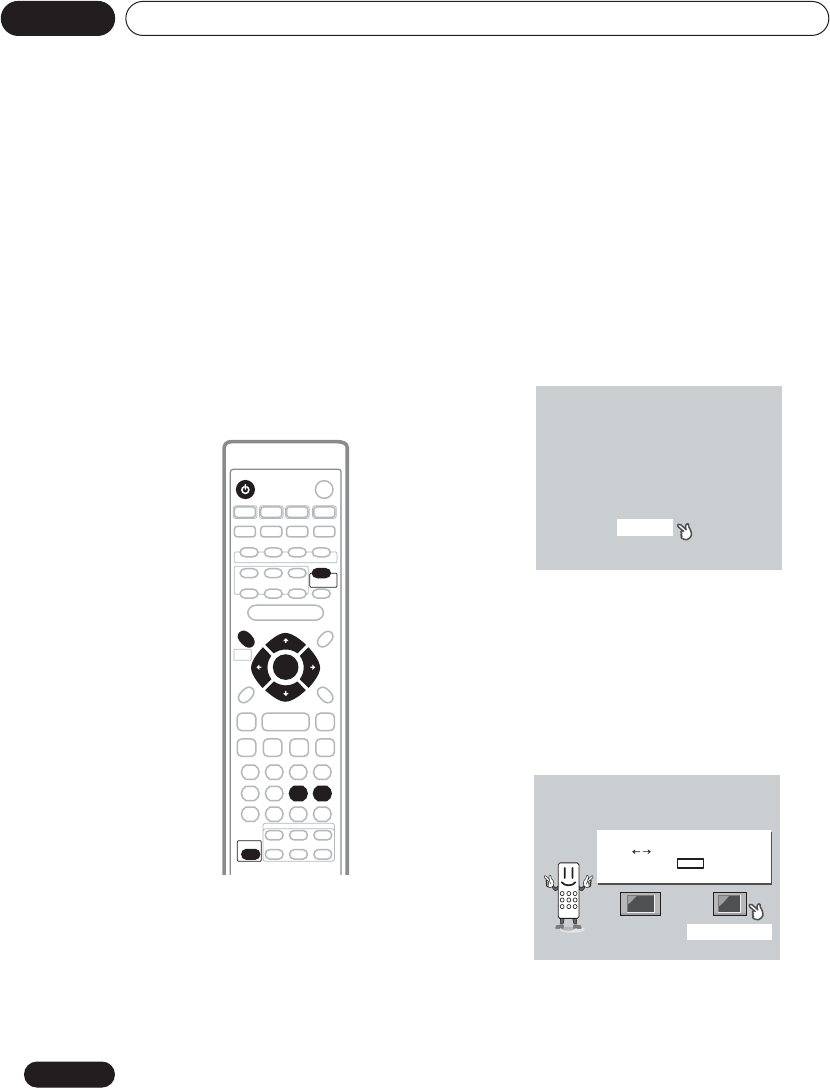
Getting started04
30
En
Chapter 4
Getting started
Switching on and setting up
After making sure everything is connected up
properly, you’re ready to switch on. The first
thing to do is to tell the system what kind of TV
you’re using, standard or widescreen.
After that you can set up the surround sound
for your room, and set the clock so that you can
use the timer features.
1 Press STANDBY/ON (on the remote or
on the front panel) to switch the system
on.
Also make sure that your TV is switched on and
that the video input is set to this system. You
should see the welcome screen displayed.
2 Press ENTER to move on to the next
screen.
3Use the / (cursor left/right) buttons
to select either ‘Wide screen’ or ‘Standard
size screen’ according to the kind of TV you
have, then press ENTER.
See also Screen sizes and disc formats on
page 88 if you’re not sure which one to choose.
ENTER
STANDBY/ON
SYSTEM SETUP
SHIFT
ROOM
SETUP
ENTER
TIMER
Welcome to Pioneer DVD!
Thank you for purchasing this Pioneer DVD player.
Before using, please take a little time
to setup your DVD player
Put the batteries into the remote control
Next, press the [ENTER] button on the remote control
and start the Let's Get Started Menu
Next
Let's Get Started Menu
What kind of TV do you have?
Use the / cursor buttons
to choose, then press ENTER
Wide screen (16:9) Standard size screen (4:3)
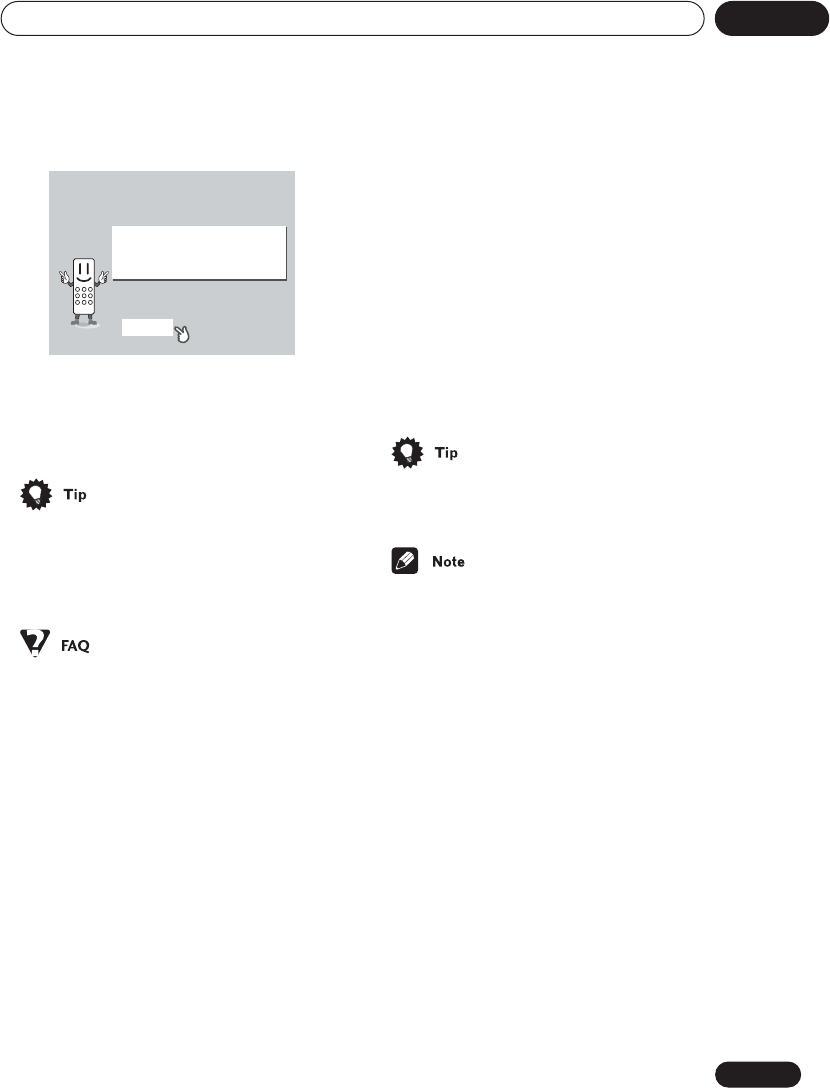
Getting started 04
31
En
4 Press ENTER again to finish setting up.
• Use the (cursor right) button to select
Back then press ENTER if you want to go
back and change the setting you just
made.
• You can also use the OPEN/CLOSE
button on the front panel or the function
buttons (DVD/CD, TUNER, etc.) to switch
the system on from standby.
• The system switches on, but there is
nothing displayed on my TV.
Make sure that the TV is set to the correct
video input (not a TV channel). For
example, if you connected this system to
the VIDEO 1 input on your TV, switch your
TV to VIDEO 1.
Setting the clock
Setting the clock allows you to use the timer
features.
1Press TIMER (SHIFT + 6).
• If you are adjusting the clock, rather then
setting it for the first time, press TIMER
(SHIFT + 6) again.
2 If ‘Clock ADJ?’ isn’t already shown in
the display, press or (cursor left or
right) until you see it.
3Press ENTER.
4Use the / (cursor up/down) buttons
to set the hour.
5Press ENTER.
6Use the / (cursor up/down) buttons
to set the minute.
7 Press ENTER to confirm.
The display flashes to indicate the clock is set.
• Press TIMER (SHIFT + 6) anytime to
display the clock.
• If you unplug the system from the wall
outlet, or there is a power outage, you will
need to set the clock again.
Using the Room Setup
After you have set up your speakers to your
liking (see Placing the speakers on page 13),
make sure you calibrate your system for
surround sound. This is a quick and easy way
to get good surround sound for your room.
For more detailed surround sound setup, see
Surround sound and other settings on page 64.
1 If the system isn’t already on, press
STANDBY/ON to switch it on.
2Press ROOM SETUP.
•If you have previously set up the room type
and seating position, the display will show
the current room settings. See note below
if you see Room Set? in the display.
Let's Get Started Menu
Setup complete
If you're finished setting up,
choose [Complete],
to start again choose [Back]
Complete Back
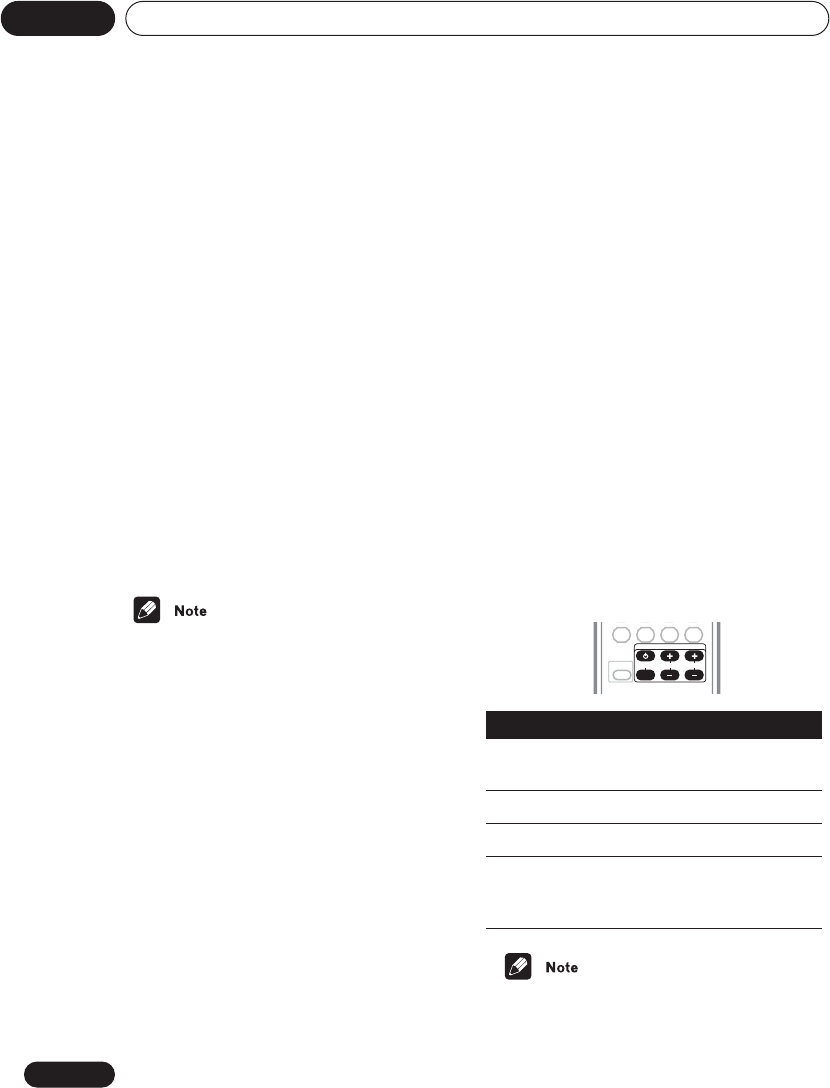
Getting started04
32
En
3Press ENTER.
4Use the / (cursor up/down) buttons
to select a room type then press ENTER.
Choose one of the following depending on your
room size:
•S – Smaller than average room
•M – Average room
•L – Larger than average room
5Use the / (cursor up/down) buttons
to select a seating position setting, then
press ENTER.
Choose one of the following depending on
where your main listening position is:
•Fwd – If you are nearer to the front
speakers than the surround speakers
•Mid – If you are equal distance from the
front and surround speakers
•Back – If you are nearer to the surround
speakers than the front speakers
• The Room Setup automatically sets up
channel levels and channel delay. If you
have already set the channel levels
manually (see Setting the channel levels on
page 66), you will see Room Set? in the
display when you first press the ROOM
SETUP button. If you continue, the previous
settings will be overwritten.
• If you are using a multichannel wireless
speaker setup (see Placing the wireless
speaker system on page 14), see Setting the
channel levels on page 66 to lower the
surround speaker levels after completing
the Room Setup.
Setting up the remote to
control your TV
You can set up the supplied remote to control
your TV using the TV CONTROL buttons.
1 Switch on your TV.
2 Find the name of the manufacturer of
your TV in the Preset Code List on page 90.
Next to each manufacturer is one or more
three digit codes. These tell the remote what
kind of TV you have.
If the name of the manufacturer of your TV
does not appear in the table, you won’t be able
to set up this remote to control your TV. Note
that there are also cases where the preset
codes listed for a manufacturer in the table
may not work for your TV.
3Point the remote at your TV, hold down
the CLEAR button, then enter the three
digit code for your TV.
The remote transmits an on/off signal to the TV.
If you’ve entered the correct code, your TV
should switch off.
If your TV doesn’t turn off, repeat the procedure
using the next code in the list until your TV
switches off successfully. Once set, you can
then use the individual TV controls shown
below.
• The default setting is for a Pioneer TV.
Button What it does
Switches your TV on or into
standby.
CHANNEL +/– Changes the TV channel.
VOLUME +/– Adjusts the volume.
INPUT Switches the TV’s input
between the built in TV tuner
and an external video source.
TV CONTROL
CHANNELINPUT VOLUME
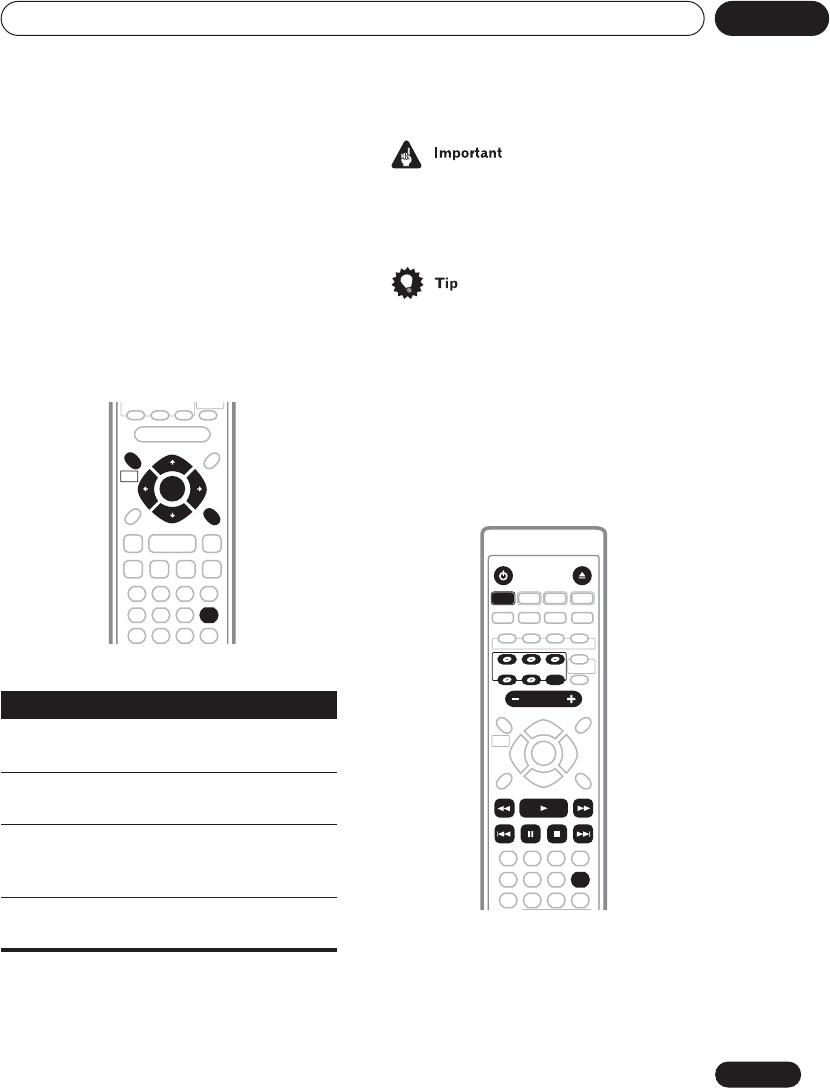
Getting started 04
33
En
Using the on-screen displays
For ease of use, this system makes extensive
use of graphical on-screen displays (OSDs).
You should get used to the way these work as
you’ll need to use them when setting up the
system, using some of the playback features,
such as program play, and when making more
advanced settings for audio and video.
All the screens are navigated in basically the
same way, using the cursor buttons to change
the highlighted item and pressing ENTER to
select it.
• Throughout this manual, ‘Select’ means
use the cursor buttons to highlight an item
on-screen, then press ENTER.
• The button guide at the bottom of every
OSD screen shows you which buttons
you’ll need to use for that screen.
Playing discs
The basic playback controls for playing DVD,
CD, SACD, Video CD and MP3 discs are
covered here. Further functions are detailed in
chapter 6.
1 If the system isn’t already on, press
STANDBY/ON to switch on.
If you’re playing a DVD or Video CD, also turn
on your TV and make sure that it is set to the
correct video input.
Button What it does
HOME
MENU Displays/exits the on-screen
display
Changes the highlighted menu
item
ENTER Selects the highlighted menu
item (both ENTER buttons work
in exactly the same way)
RETURN Returns to the main menu
without saving changes
HOME
MENU
RETURN
ENTER
ENTER
OPEN/CLOSE
STANDBY/ON
VOLUME
DVD/CD
ENTER
CD MODE
DISC SKIP
DISC 1 DISC 2
DISC 4 DISC 5
DISC 3
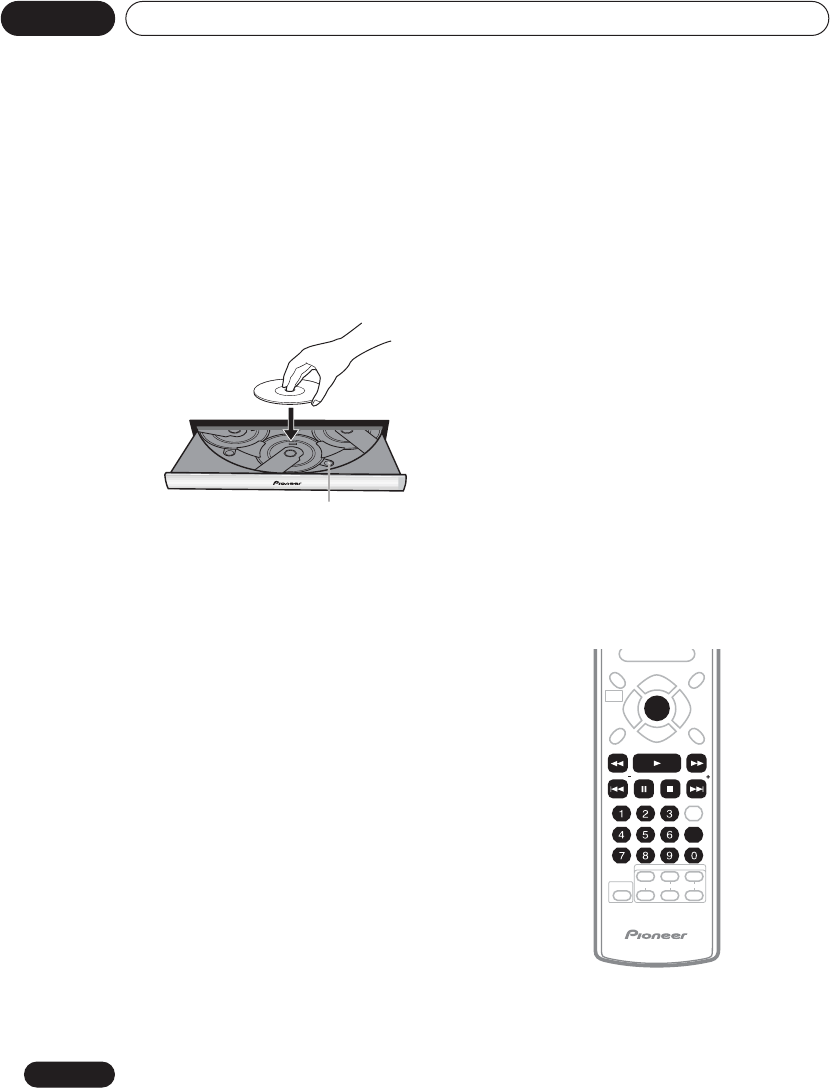
Getting started04
34
En
2 Press OPEN/CLOSE to open the disc
tray.
3 Load a disc.
Load a disc with the label side facing up in the
front-most disc space, using the disc tray
guide to align the disc. (If you’re loading a
double-sided DVD disc, load it with the side you
want to play face down.)
If you want to load more discs, press DISC SKIP
(remote or front panel) to rotate the disc tray.
You can load up to five discs at once.
• Do not place discs in the two partially
accessible disc spaces, as it easy to
misalign them. Use only the front-most
space.
•Do not load more than one disc in a space.
• Before loading or removing discs, always
wait for the disc mechanism to come to a
complete stop.
•Do not rotate the disc tray by hand. Always
use the DISC SKIP button.
• Sometimes, when the disc tray
mechanism is moving, the controls are
inoperative.
4 Press (remote) or (front panel) to
start playback of the disc loaded in the
front-most disc space.
Alternatively, use the DVD/CD or DISC buttons
on the remote, or the DIRECT PLAY buttons on
the front panel to start playback of other discs.
If you’re playing a DVD or Video CD, a menu
may appear. See DVD-Video disc menus on
page 37 and Video CD PBC menus on page 38
for how to navigate these.
If you’re playing an MP3 or JPEG disc, it may
take a few seconds before playback starts,
depending on the complexity of the file
structure on the disc.
If you loaded a CD/CD-R/RW containing
JPEGs, a slideshow will start. See Viewing JPEG
discs on page 60 for more on playing these
discs.
• See also Options on page 71 if the disc
contains both MP3 audio files and JPEG
picture files.
5 Use the VOLUME +/– button (or the
front panel VOLUME knob) to adjust the
volume.
Basic playback controls
The following table shows the basic controls on
the remote for playing discs. You can find other
playback features in Playing discs on page 49.
Disc number
FOLDER
ENTER
ENTER
FOLDER
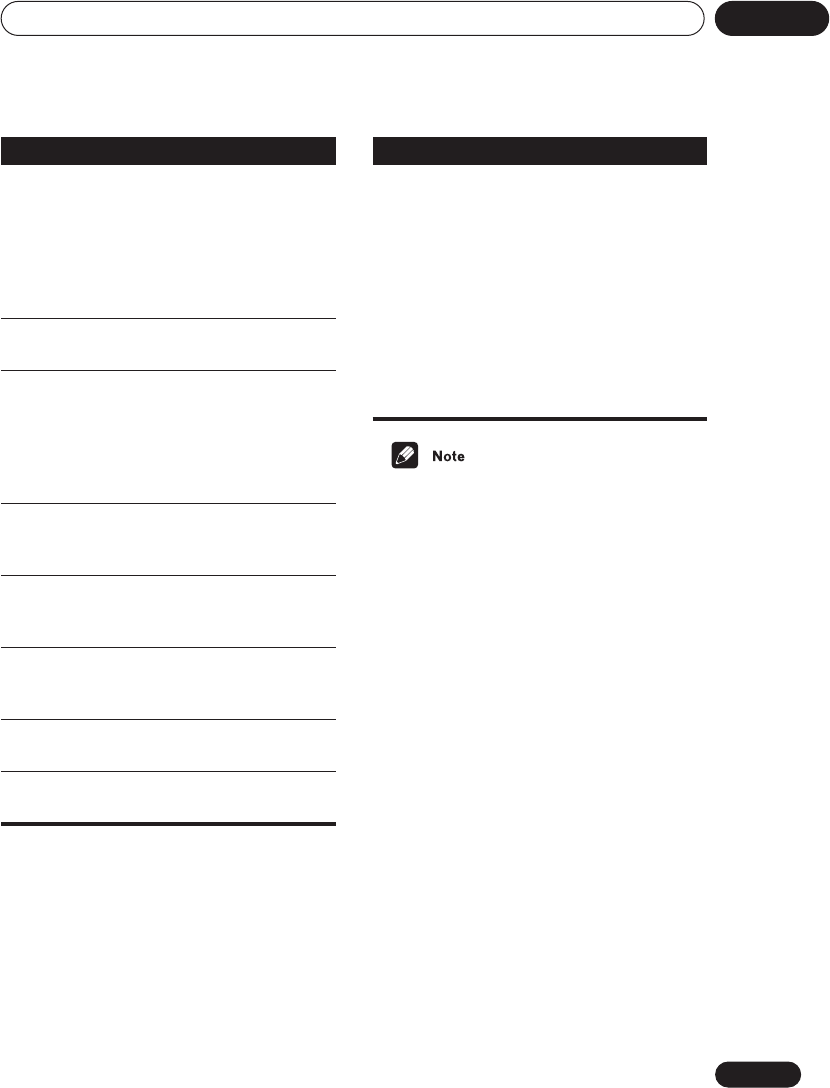
Getting started 04
35
En
• You may find with some DVD discs that
some playback controls don’t work in
certain parts of the disc. This is not a
malfunction.
Using the front panel controls
The OPEN/CLOSE and (stop) buttons on
the front panel work the same way as the
remote control equivalents.
The front panel scan and skip buttons (
and ) are combined. Press once for
chapter/track skip, or press and hold for
scanning.
Resume and Last Memory
When you stop playback of a DVD or Video CD
disc, Resume is shown in the display indi-
cating that you can resume playback again
from that point.
If the disc tray is not opened, the next time you
start playback the display shows Resume and
playback resumes from the resume point.
Button What it does
Starts playback.
DVD and Video CD: If the display
shows Resume or Last Mem
playback starts from the resume
or last memory point (see also
Resume and Last Memory
below.)
Pauses a disc that’s playing, or
restarts a paused disc.
Stops playback.
DVD and Video CD: The display
shows Resume. Press again
if you want to cancel the resume
function. (See also Resume and
Last Memory below.)
Press to start fast reverse
scanning. Press (play) to
resume normal playback.
Press to start fast forward
scanning. Press (play) to
resume normal playback.
Skips to the start of the current
track or chapter, then to
previous tracks/chapters.
Skips to the next track or
chapter.
FOLDER +/– Skips to the next/previous folder
when playing MP3 discs.
Numbers Use to enter a title/track num-
ber. Press ENTER to select (or
wait a few seconds).
• If the disc is stopped, play-
back starts from the selected
title (for DVD) or track number
(for CD/SACD/Video CD/MP3).
• If the disc is playing, playback
jumps to the start of the
selected chapter or track (within
the current group for DVD-
Audio).
Button What it does
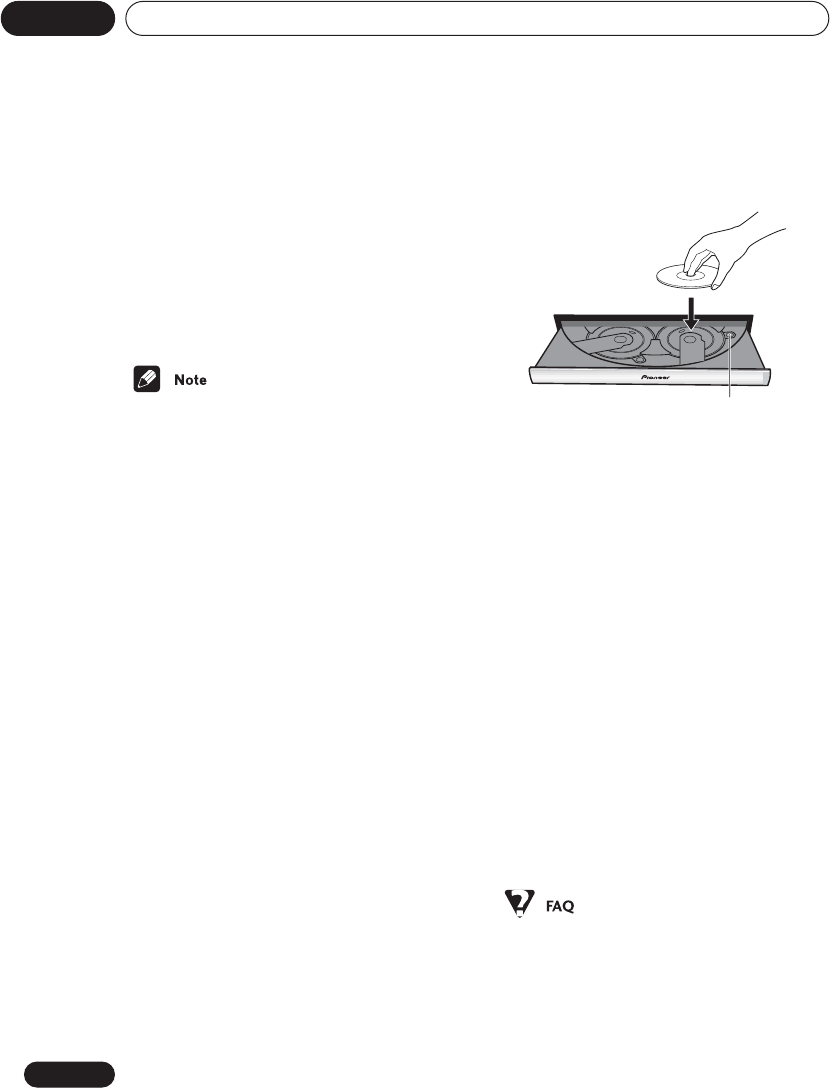
Getting started04
36
En
For DVD discs only: If you change discs using
the DISC SKIP, DISC or DIRECT PLAY buttons,
or take the disc out of the player, the play posi-
tion is stored in memory. When you load the
disc next time, the display shows Last Mem
and you can resume playback (this works for
up to five discs).
If you want to clear the resume/last memory
point, press (stop) while Resume or Last
Mem is displayed.
• When a Video CD is loaded, the Resume
point is lost if the system is switched off, or
switched to a function other than DVD/CD.
•For the Last Memory function to work, you
must press (stop) to stop playback
before opening the disc tray or changing
the disc.
• The Last Memory function doesn’t work
with VR format DVD-RW discs.
Changing discs
You can change any of the discs not in the play
position using the EXCHANGE button on the
front panel. Because the disc in the play
position is unaffected, you can use this button
to change discs even during playback.
1 Press EXCHANGE to open the disc tray.
• The EXCHANGE button only works when
there is at least one disc loaded.
2 Load a disc with the label side facing
up, using the disc tray guide to align the
disc.
•If you want to load more discs, press DISC
SKIP to rotate the disc tray two disc spaces.
• Before loading or removing discs, always
wait for the disc mechanism to come to a
complete stop.
• Load discs only in the two fully accessible
disc spaces. Do not try and load discs into
any of the other spaces; they may not load
correctly and cause the system to
malfunction.
•Do not rotate the disc tray by hand. Always
use the DISC SKIP button.
• Do not obstruct the movement of the disc
tray.
3Press EXCHANGE or OPEN/CLOSE to
close the disc tray.
• Always use the OPEN/CLOSE or
EXCHANGE button to close the disc tray
after exchanging discs. Never push the
disc tray shut by force.
• After I load a DVD disc, it ejects
automatically after a few seconds!
Disc number
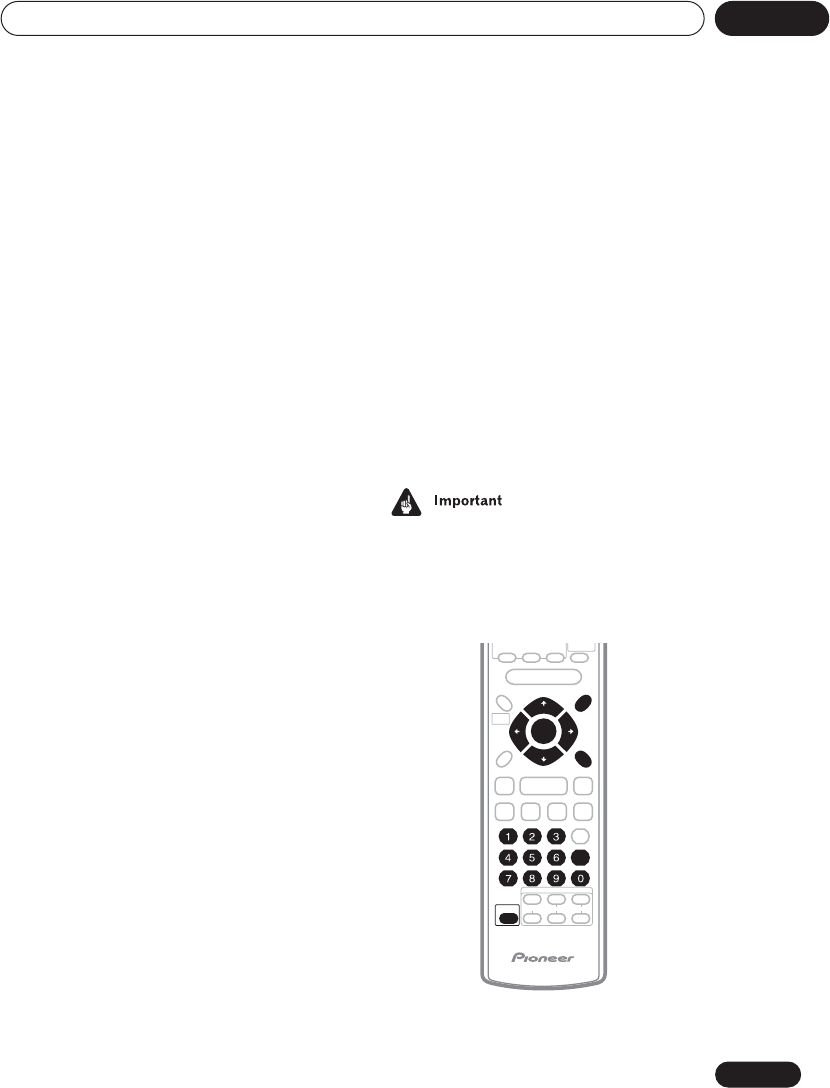
Getting started 04
37
En
Most likely, the disc is the wrong region for
your system. The region number should be
printed on the disc; check it against the
region number of the system (which you
can find on the rear panel). See also DVD
Video regions on page 76.
If the region number is OK, it may be that
the disc is damaged or dirty. Clean the disc
and look for signs of damage. See also
Using and taking care of discs on page 75.
If you’ve set the Parental Lock level for the
system to a level lower than the disc you are
trying to play, you’ll need to set it again to
watch the disc (see Parental Lock on
page 72).
• Why won’t the disc I loaded play?
First check that you loaded the disc the
right way up (label side up), and that it’s
clean and not damaged. See Using and
taking care of discs on page 75 for
information on cleaning discs.
If a disc loaded correctly won’t play, it’s
probably an incompatible format or disc
type, such as DVD-ROM. See Disc / content
format playback compatibility on page 9 for
more on disc compatibility.
•I have a widescreen TV so why are there
black bars at the top and bottom of the
screen when I play some discs?
Some movie formats are such that even
when played on a widescreen TV, black
bars are necessary at the top and bottom of
the screen. This is not a malfunction.
•I have a standard (4:3) TV and set the system
to show widescreen DVDs in pan & scan
format, so why do I still get black bars top
and bottom with some discs?
Some discs override the display
preferences of the system, so even if you
have 4:3 (Pan & Scan) selected, those
discs will still be shown in letterbox format.
This is not a malfunction.
•My DVD-Audio disc starts playing, but then
suddenly stops!
The disc may have been illegally copied.
DVD-Video disc menus
Many DVD-Video and DVD-Audio discs contain
menus from which you can select what you
want to watch. They may give access to addi-
tional features, such as subtitle and audio
language selection, or special features such as
slideshows. See the disc packaging for details.
Sometimes DVD-Video menus are displayed
automatically when you start playback; others
only appear when you press DVD MENU or
TOP MENU.
• Some DVD-Audio discs feature a ‘bonus
group’. To access this group you have to
input a password, which you can find on
the disc’s packaging. See page 91 for more
information.
TOP MENU
DVD MENU
RETURN
SHIFT
ENTER
ENTER
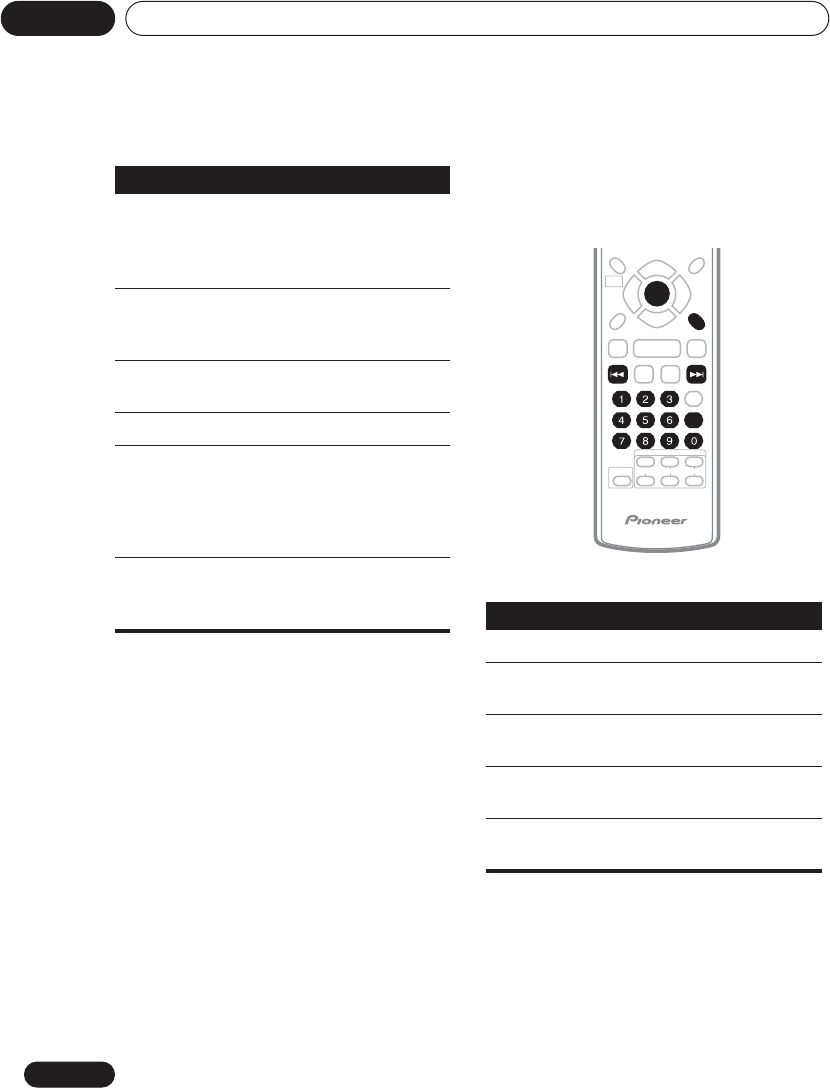
Getting started04
38
En
Video CD PBC menus
Some Video CDs have menus from which you
can choose what you want to watch. These are
called PBC (Playback control) menus.
You can play a PBC Video CD without having to
navigate the PBC menu by pressing (stop)
then starting playback using a number button
to select a track, rather than (play) (or
on the front panel).
Button What it does
TOP MENU
(SHIFT +
DVD
MENU)
Displays the ‘top menu’ of a DVD
disc—this varies with the disc.
DVD
MENU Displays a DVD disc menu—this
varies with the disc and may be
the same as the ‘top menu’.
Moves the cursor around the
screen.
ENTER Selects the current menu option.
RETURN Returns to the previously
displayed menu screen. On
some DVD-Audio discs featuring
browsable pictures, press to
display the browser screen.
Numbers Highlights a numbered menu
option (some discs only). Press
ENTER to select. Button What it does
RETURN Displays the PBC menu.
Numbers Selects a numbered menu
option.
Displays the previous menu page
(if there is one).
Displays the next menu page (if
there is one).
ENTER Press to select highlighted menu
option.
RETURN
ENTER
ENTER
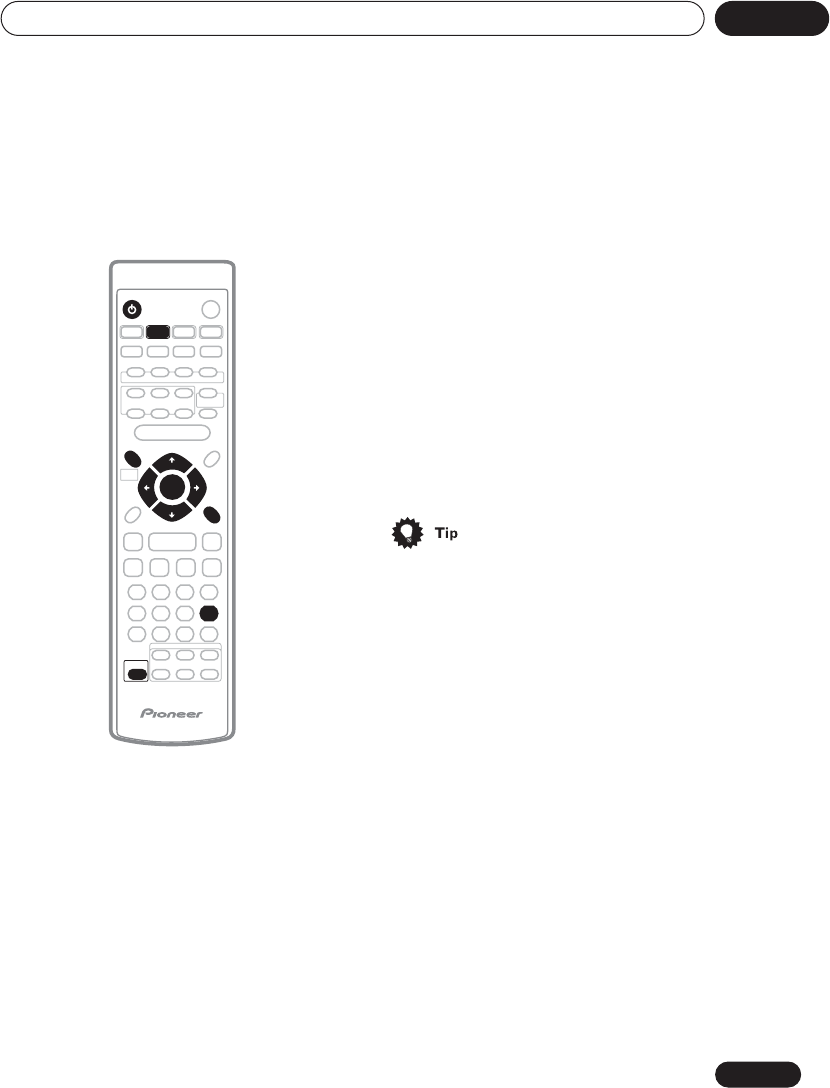
Getting started 04
39
En
Listening to the radio
The tuner can receive both FM and AM
broadcasts, and lets you memorize your
favorite stations so you don’t have to manually
tune in every time you want to listen.
1 If the system isn’t already on, press
STANDBY/ON to switch on.
2 Press TUNER to switch to the tuner,
then press repeatedly to select the AM or
FM band.
The display indicates the tuner band and the
frequency.
•If you’re using the front panel controls, the
TUNER button switches between FM, AM
and station presets (see Memorizing
stations on page 40).
3 Tune to a frequency.
There are three tuning modes—manual, auto,
and high-speed:
• Auto tuning: Press and hold TUNE +/–
until the frequency display starts to move,
then release. The tuner will stop on the next
station it finds. Repeat to search for other
stations.
•Manual tuning: Press TUNE +/–
repeatedly to change the displayed
frequency.
•High-speed tuning: Press and hold TUNE
+/– until the frequency display starts to
move rapidly. Keep the button held down
until you reach the frequency you want. If
necessary, fine tune the frequency using
the manual tuning method.
• You can use the and
buttons on the front panel instead of the
TUNE +/– buttons.
Improving poor FM reception
If you’re listening to an FM station in stereo but
the reception is weak, you can improve the
sound quality by switching to mono.
1Press SYSTEM SETUP (SHIFT + HOME
MENU).
2Use the / (cursor left/right) buttons
to choose ‘FM Mode ?’, then press ENTER.
3Use the / (cursor up/down) buttons
to select ‘FM Mono’ or ‘FM Auto’, then
press ENTER.
Select Auto in step 3 to switch back to auto-
stereo mode (the stereo indicator lights when
receiving a stereo broadcast).
ENTER
RETURN
STANDBY/ON
FM/AM
SYSTEM SETUP
SHIFT
TUNER
TUNE +
ST +ST –
TUNE –
ENTER
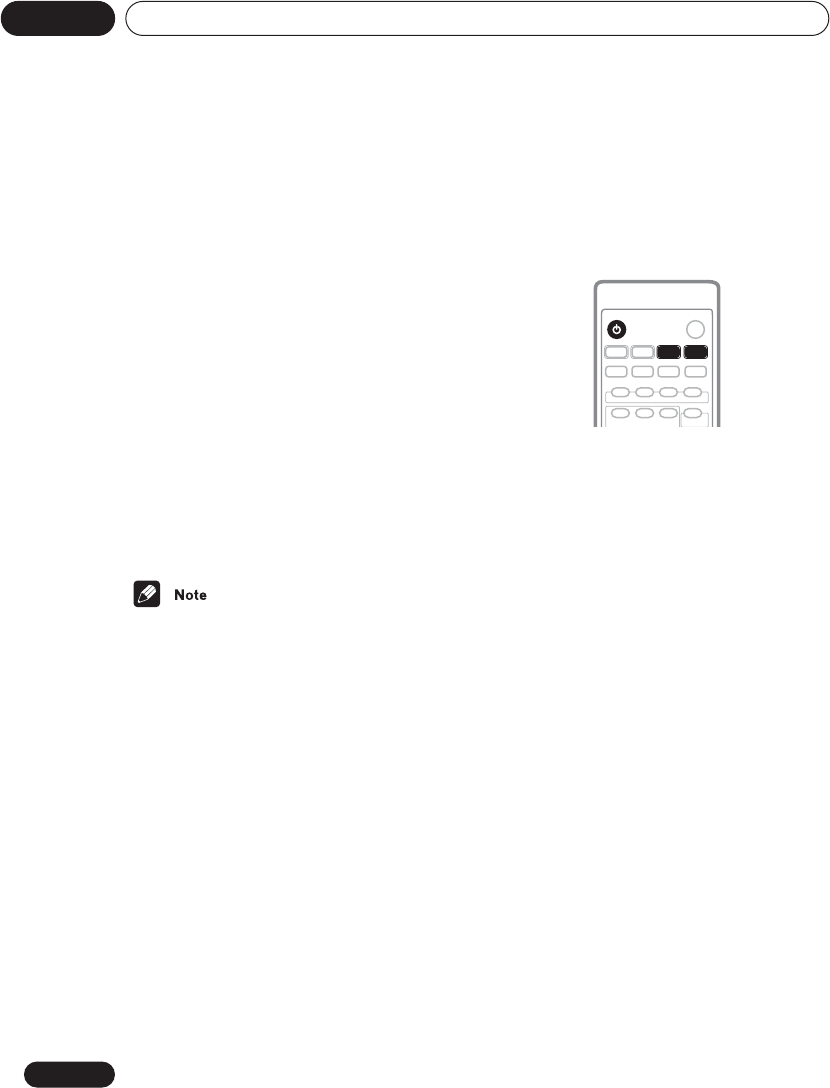
Getting started04
40
En
Memorizing stations
You can save up to 30 station presets so that
you always have easy access to your favorite
stations without having to tune in manually
each time.
1 Tune to an AM or FM radio station.
For the FM band, select mono or auto-stereo
reception as necessary. This setting is saved
along with the preset.
2Press SYSTEM SETUP (SHIFT + HOME
MENU).
3Use the / (cursor left/right) buttons
to choose ‘St. Memory?’ then press ENTER.
4Use the / (cursor up/down) buttons
to select the station preset you want.
There are 30 preset locations; each can store
one station preset.
5 Press ENTER to save the station preset.
•If the system is unplugged from the power
supply completely, saved stations will
remain for several days, after which you’ll
have to save them again.
Listening to station presets
1 Make sure the TUNER function is
selected.
2Use ST +/– or the number buttons to
select a station preset.
• If you are using the front panel controls,
press TUNER FM/AM/ST. until you’re in
station preset mode, then use the
and buttons to select a station
preset.
Listening to other sources
You can connect up to three external sources
(TV, satellite receiver, etc.) to this system,
including one digital source. See also Listening
to TV audio through this system on page 18 and
Connecting auxiliary components on page 81.
1 If the system isn’t already on, press
STANDBY/ON to switch on.
Also make sure that the external source (TV,
satellite receiver, etc.) is switched on.
2 Select the source you want to listen to.
•If you’re using the remote control, press TV
to select the TV input, or use the LINE (L1/
L2) button to select the LINE 1 or LINE 2
input.
• The TV/L1/L2 button on the front panel
switches between the three inputs.
3 If necessary, start playback of the
external source.
STANDBY/ON
L1/L2
TV LINE
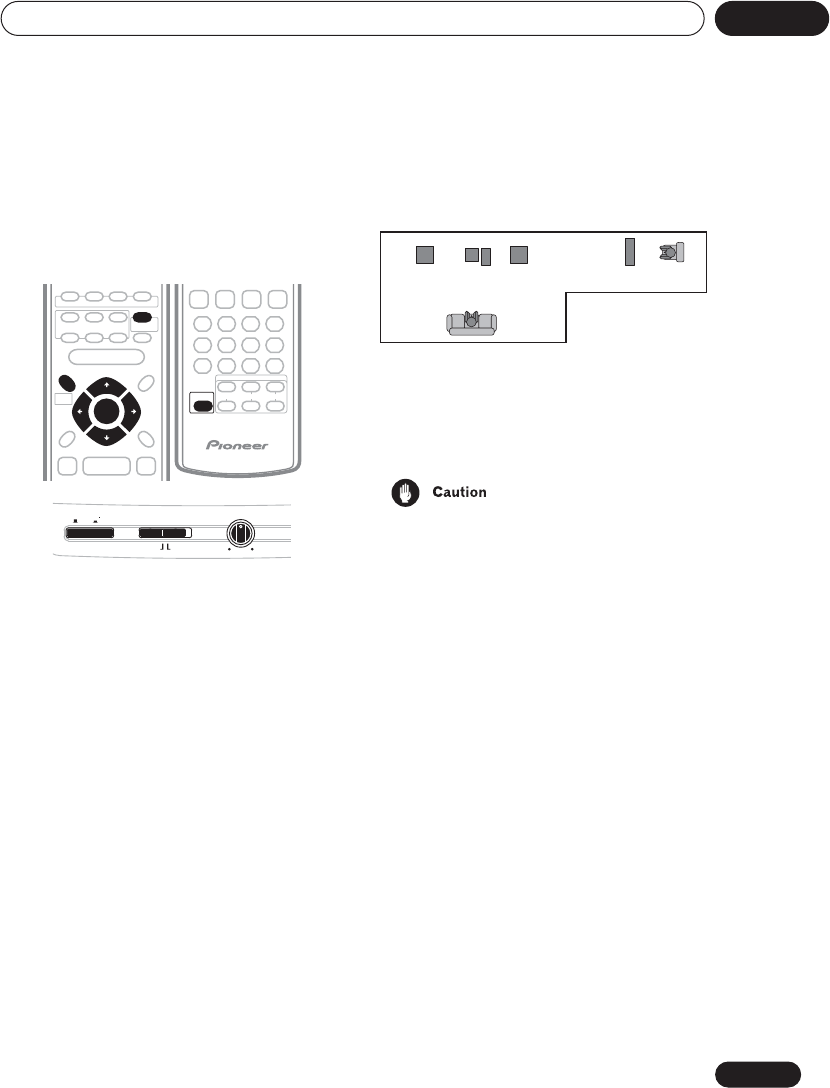
Getting started 04
41
En
Using the wireless speaker
system
The wireless speaker supplied with your
system can be used for multichannel sound
with your main setup, or as a second stereo
speaker system.
Illustration above shows the XW-HTD640
wireless speaker.
1Switch the wireless speaker off and the
main unit into standby.
2 Press SYSTEM SETUP.
3 If it’s not already selected, use /
(cursor left/right) to select ‘Wireless?’ then
press ENTER.
The current setting is shown in the display.
4 Use / (cursor up/down) to select
‘W.Surr.’ or ‘W.Stereo’.
•W.Surr. – Sounds going to the surround
left and right channels are heard through
the wireless speaker (see below for
placement options).
•W.Stereo – Any source playing through
the main system is heard in stereo through
the wireless speakers (multichannel
sources will be downmixed to stereo).
5 Press ENTER.
6 Set the WIRELESS MODE switch on the
wireless speaker to the same mode you
selected above.
•If the mode of the wireless speaker system
and the mode of the DVD receiver do not
match, loud noise may be output from the
wireless speaker system.
7 Switch the main unit and wireless
speaker back on.
If you selected W.Stereo, start playback and
adjust the STEREO MODE VOLUME control as
necessary.
If you selected W.Surr. continue to the next
step.
8 Press WIRELESS (SHIFT+ROOM SETUP)
repeatedly to select a wireless listening
mode.
Choose between the following options:
SYSTEM SETUP
ENTER
WIRELESS
SHIFT
W.SURROUND W.STEREO
STEREO MODE
VOLUME
MIN MAX
POWER
OFF ON
WIRELESS
MODE
Front left
Listening position (main room)
Listening position
(sub room)
Wireless
speaker
Center
Subwoofer
Front right
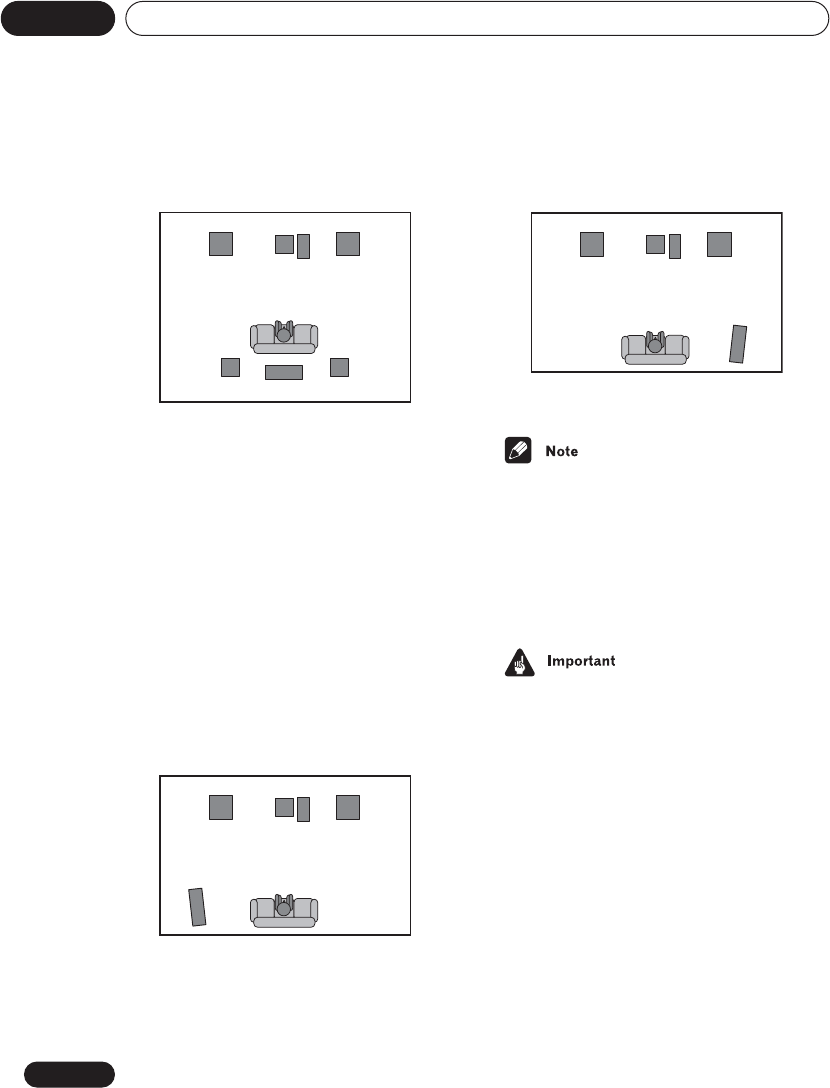
Getting started04
42
En
•Normal – Use for surround sound with the
wireless speaker placed behind the
listening position.
Note that the illustration above shows a
speaker setup including surround speakers,
which are not included with the HTD-641DV
model. Simply set up your speakers as
shown above, disregarding the surround
speakers in the diagram.
•Wide (default) – Use to create enveloping
surround sound with the wireless speaker
placed behind the listening position (see
illustration for Normal above).
The following options are possible if you are
using the HTD-641DV model (no surround
speakers connected).
•Left Side – Use for surround sound with
the wireless speaker placed to the left of
the listening position.
•Right Side – Use for surround sound with
the wireless speaker placed to the right of
the listening position.
9 Press ENTER.
• If you selected W.Stereo in step 4, the
WIRELESS button has no effect when the
system is switched on (W.Stereo flashes
in the display).
• The WIRELESS indicator on the front panel
display is only shown when W.Surr. is
selected .
• Even when not in use, the fan in the
wireless speaker will continue to operate.
Switching off the wireless speaker when
not in use will increase product life.
• Placing the transmitter and the wireless
speaker too close together will result in an
unstable signal. Make sure they are more
than 1m / 2.4 ft apart for the best reception.
• The radio waves sent from the transmitter
to the wireless speaker may reflect off any
number of surfaces in your listening area
(for example, walls or cabinets). If you are
experiencing poor reception due to this
phenomenon, try moving the position of
the wireless speaker for better reception.
Front left
Surround
left
Listening position
Wireless speaker
Center
Subwoofer
Front right
Surround
right
Front left
Listening position
Center
Subwoofer
Front right
Wireless
speaker
Front left
Listening position
Center
Subwoofer
Front right
Wireless
speaker
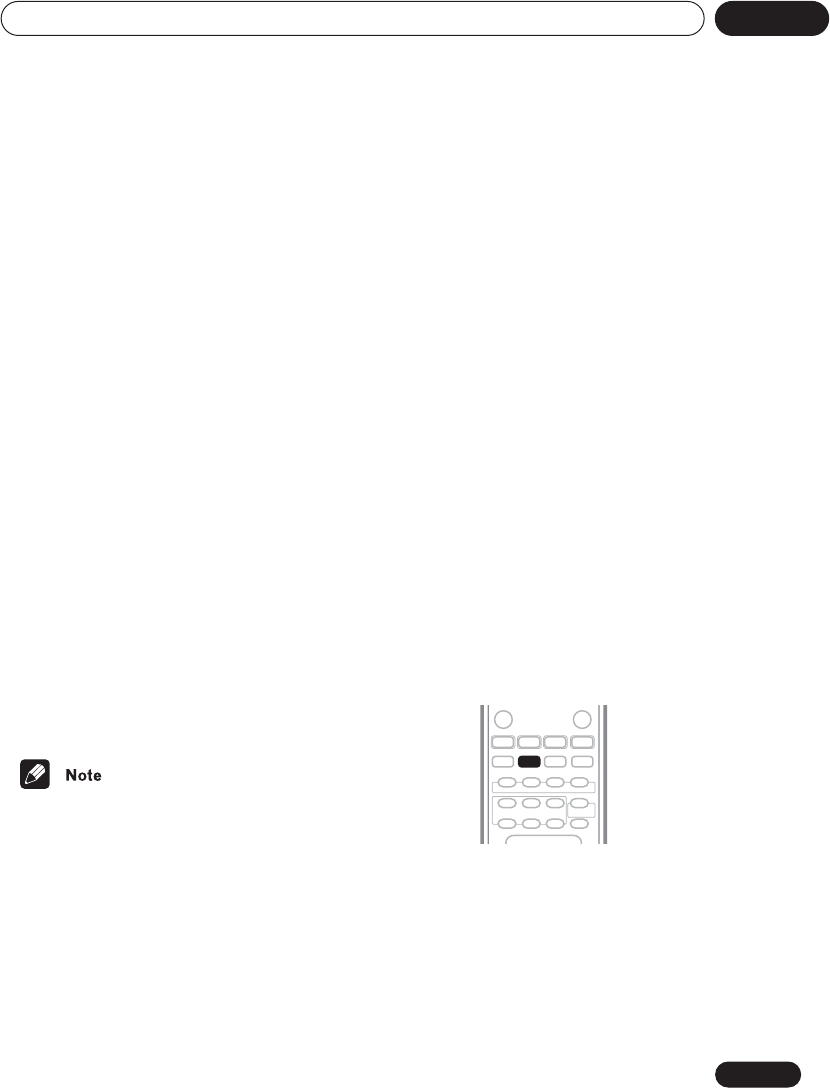
Listening to your system 05
43
En
Chapter 5
Listening to your system
About the listening modes
As explained in Placing the speakers on
page 13, there are two basic surround speaker
setup options available. Of course you can
select any of the listening modes regardless of
how you place your speakers, but you will
achieve the best surround effect by using the
listening modes in conjunction with your
speaker setup:
•Standard surround 5-spot setup – Use
the Standard (Listening in surround sound
on page 44) and Advanced (Using the
Advanced Surround effects on page 45)
surround listening modes with this setup.
•Front surround 3-spot setup – See Using
Front Surround on page 45 for the options
available with this speaker setup.
HTD-641DV only – This setup requires
surround speakers.
Make sure you have completed Using the
Room Setup on page 31. For a more detailed
surround sound setup, see Using the System
Setup menu on page 64.
• Certain features explained in this section
may not be possible depending on the
source (for example, 88.2 / 96 kHz sources),
or a conflicting system setting. See Error
Messages on page 87 for more on this.
• Except for mute, the tone controls (bass/
treble) and Quiet and Midnight listening,
the features in this section can’t be used
with DVD-Audio or Super Audio CD
sources.
• When using the wireless speaker system
for multichannel sound, it is
recommended that you do not use the 3-
spot setup (page 13). See Using the
wireless speaker system on page 41 for the
various options available with your wireless
speaker system.
•HTD-641DV only – If you choose not to
connect surround speakers, use the
Standard surround setup as explained in
Placing the speakers on page 13. Use the
Standard (Listening in surround sound on
page 44) and Advanced (Using the
Advanced Surround effects on page 45)
surround listening modes with this setup.
Auto listening mode
The Auto listening mode is the simplest way to
listen to any source as it was mastered: the
output from the speakers mirrors the channels
from the source material.
• Press SURROUND to select the ‘Auto’
listening mode.
If the source is Dolby Digital or DTS, the
2 DIGITAL or DTS indicator on the front panel
lights.
SURROUND
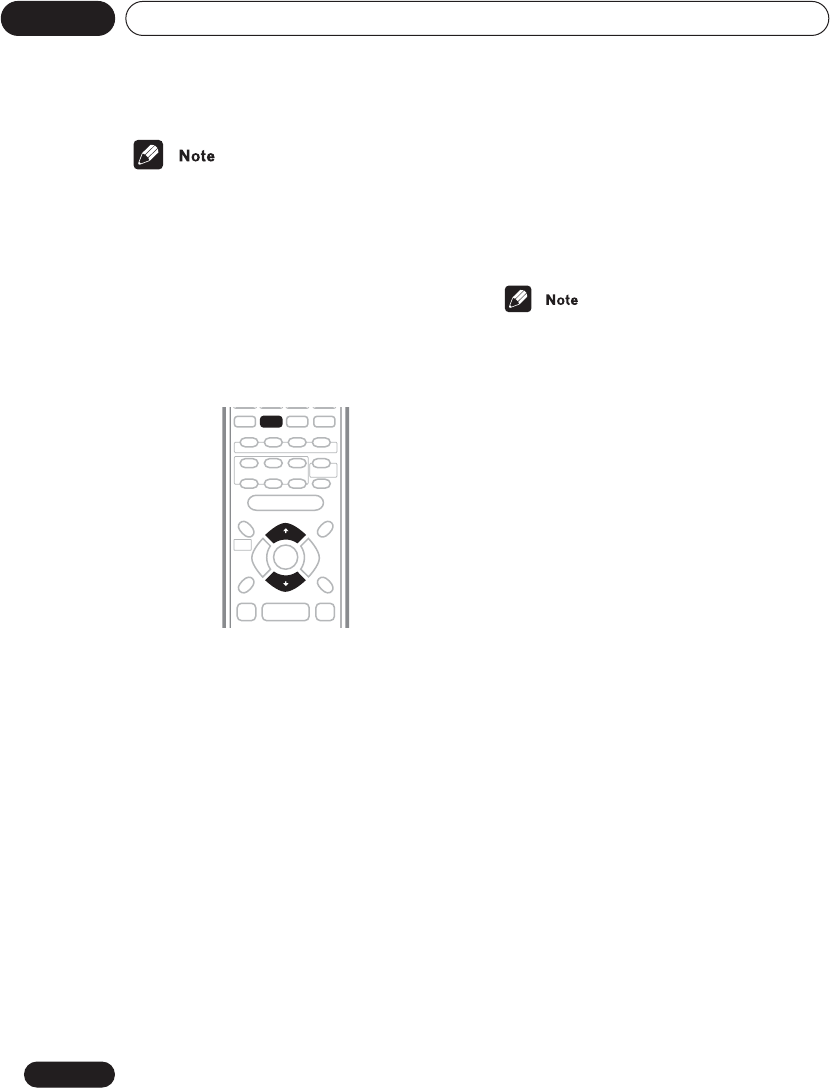
Listening to your system05
44
En
• Any previously active Dolby Pro Logic or
Advanced Surround mode is canceled
when Auto listening mode is selected.
Listening in surround sound
You can listen to any source—stereo or
multichannel, analog or digital—in surround
sound. Surround sound is generated from
stereo sources using one of the Dolby Pro
Logic decoding modes.
•Press SURROUND repeatedly to select a
listening mode (or press SURROUND then
use the / (cursor up/down) buttons).
The listening mode choices that appear in the
display will vary according to the type of source
that’s playing.
•Auto – See Auto listening mode above.
•Dolby Digital / DTS – Dolby Digital or DTS
decoding (depending on the source).
•Pro Logic – 4.1 channel surround sound
for use with any two-channel source
•PL II Movie – Pro Logic II 5.1 channel
surround sound, especially suited to movie
sources, for use with any two-channel
source
•PL II Music – Pro Logic II 5.1 channel
surround sound, especially suited to music
sources, for use with any two-channel
source (see also Dolby Pro Logic II Music
settings below)
•Stereo – See Listening in stereo below
• When listening in Dolby Digital / DTS
mode, two-channel material will
automatically be played in surround sound
using Dolby Pro Logic II decoding.
• Dolby Digital / DTS sources that use only
the center channel cannot be played back
in surround sound.
Dolby Pro Logic II Music settings
When listening in Dolby Pro Logic II Music
mode, there are three further parameters you
can adjust: Center Width, Dimension, and
Panorama.
1 With Dolby Pro Logic II Music mode
active, press SOUND MODE.
2Use the / (cursor left/right) buttons
to select ‘C Width’, ‘Dimen.’ or ‘Pnrm.’
•C Width (Center Width): Makes the center
channel wider (higher settings) or
narrower (lower settings)
•Dimen. (Dimension): Makes the sound
more distant (minus settings), or more
forward (positive settings)
•Pnrm. (Panorama): Creates more spacious
surround sound
3Use the / (cursor up/down) buttons
to adjust the setting.
Center Width is adjustable between 0 and 7;
Dimension between –3 and +3. Panorama is
On or Off.
4 Press ENTER to confirm.
SURROUND
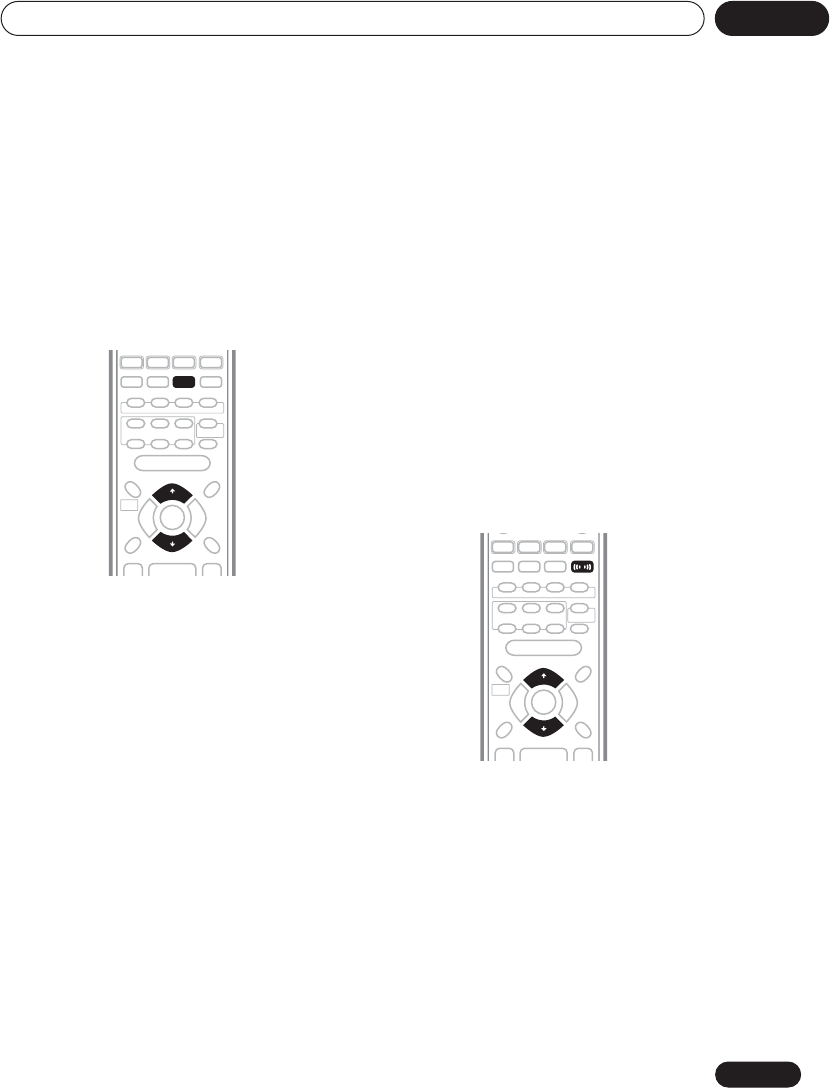
Listening to your system 05
45
En
Using the Advanced Surround
effects
Advanced Surround effects can be used with
multichannel or stereo sources for a variety of
additional surround sound effects. The 5-spot
setup described in Placing the speakers on
page 13 should be used with these effects.
For more options, see Adjusting the Advanced
and Front Surround effect level below.
•Press ADVANCED to select an Advanced
Surround mode (or press ADVANCED then
use the / (cursor up/down) buttons).
Press repeatedly to select from:
•Adv. Movie – Gives a movie theater-type
sound
•Adv. Music – Gives a concert hall-type
sound
•Expanded – Creates an extra wide
surround field
•TV Surr. – Designed for mono or stereo TV
broadcasts and other sources
•Sports – Designed for sports and other
programs based on commentary
•Game – Creates surround sound from
video game sources
•5ch Stereo – Designed to give powerful
surround sound to stereo music sources
Using Front Surround
Note that the HTD-641DV does not include
surround speakers, which are necessary to use
the Front surround modes. If connected, follow
the instructions for speaker orientation below.
The Front Surround modes are effective when
you are using the Front surround 3-spot
speaker setup as described in Placing the
speakers on page 13.
The surround speakers should be placed on
top of the front speakers (with the HTD-641DV,
place them on either side, as shown in Placing
the speakers on page 13) and oriented either
towards the walls, or straight ahead,
depending on which mode you are using (see
below).
For more options, see Adjusting the Advanced
and Front Surround effect level below.
• Press FRONT SURROUND to select an
Front Surround mode (or press FRONT
SURROUND then use the / buttons).
Press repeatedly to select from:
•Frt. Movie – The Front Surround Movie
mode emphasizes directionality, giving you
a realistic movie theater-type sound.
•Frt. Music – The Front Surround Music
mode provides greater breadth and depth
to music sources, enveloping you with a
concert hall-type sound.
ENTER
ADVANCED
FRONT
SURROUND
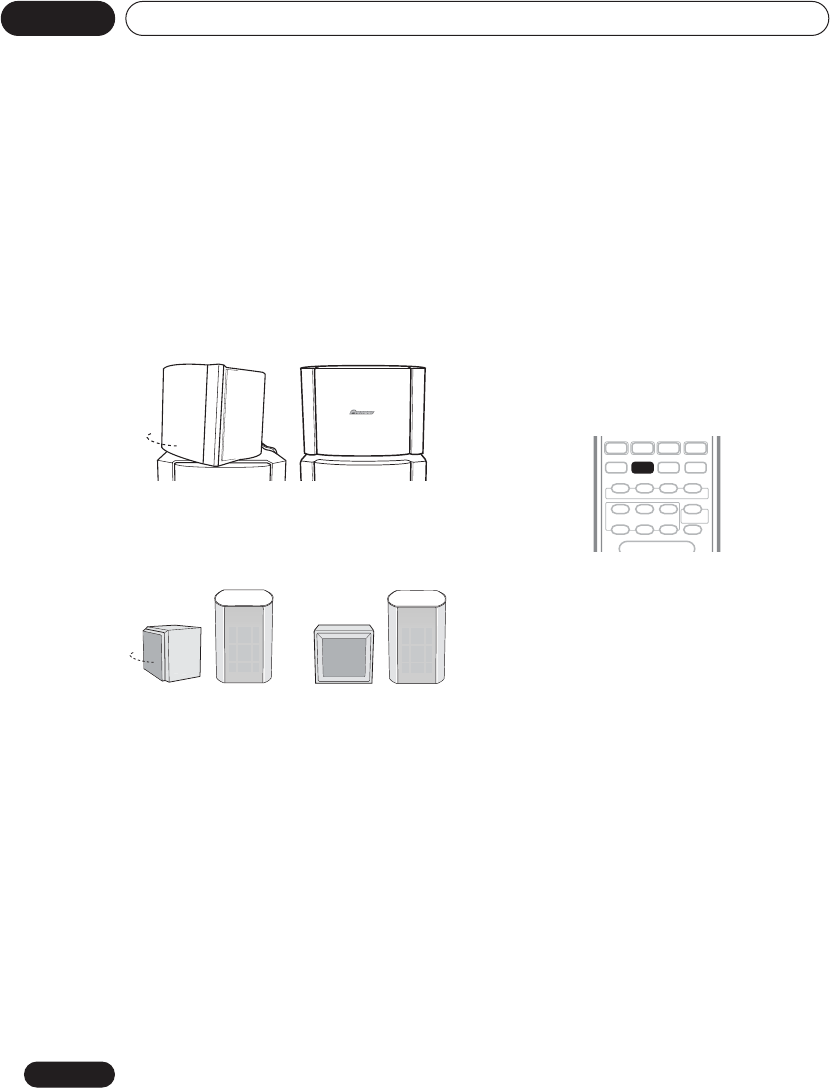
Listening to your system05
46
En
•ExtraPower – The Extra Power mode gives
additional energy and depth to a stereo
source by using the surround speakers in
addition to the front speakers.
If you have selected Frt. Movie or Frt. Music,
you will achieve best results by turning each
surround speaker about 60º towards the
closest wall. With ExtraPower, orient the
surround speakers in the same direction as the
front speakers (towards the listening position).
* Illustration shows the HTD-645DV
* Illustration shows the HTD-641DV
Adjusting the Advanced and Front
Surround effect level
You can emphasize or reduce the effect of the
Advanced and Front Surround modes as you
like. You can set the effect level for all modes
independently.
1 With one of the Advanced or Front
Surround modes active, press SOUND
MODE.
2Use the / (cursor left/right) buttons
to select ‘Effect’.
3Use the / (cursor up/down) buttons
to adjust the effect level.
The effect level can be adjusted from 10 (min)
to 90 (max).
4 Press ENTER to confirm.
Listening in stereo
You can listen to any source—stereo or
multichannel, analog or digital—in stereo.
When playing a multichannel source, stereo
sound is created by downmixing all channels
to the front left/right speakers and the
subwoofer.
• Press SURROUND repeatedly until
‘Stereo’ shows in the display.
Any active Advanced Surround or Front
Surround mode is canceled.
Listening with headphones
When headphones are connected, only the
Stereo (default) and Phones Surround (virtual
surround sound for headphones) modes are
available.
When you disconnect them it reverts to the
previous mode.
• With headphones connected, press
ADVANCED or FRONT SURROUND to select
‘Phones Surround’ or SURROUND to select
‘Stereo’.
Frt. Movie / Frt. Musi
c
60º
ExtraPower
60º
Frt. Movie / Frt. Music Extra Power
Front left
speaker
Surround
left speaker
Front left
speaker
Surround
left speaker
SURROUND
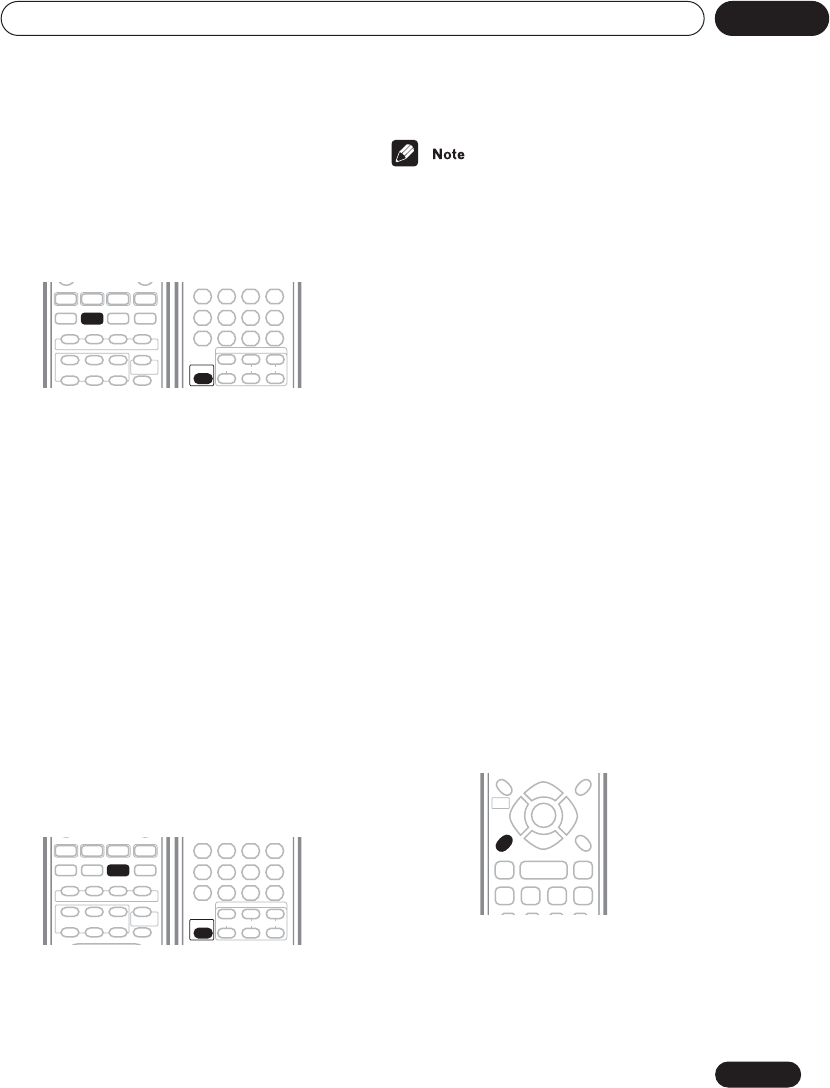
Listening to your system 05
47
En
Enhancing dialogue
• Default setting: Dialog Off
The Dialogue Enhancement feature is
designed to make the dialog stand out from
other background sounds in a TV or movie
soundtrack.
•Press DIALOGUE (SHIFT + SURROUND)
to select the amount dialog enhancement.
Press repeatedly to select from:
•Dialog Off – No dialog enhancement
•Dialog Mid – Moderate dialog
enhancement
•Dialog Max – Strong dialog enhancement
Listening with a virtual
surround back speaker
• Default setting: Vir. SB Off
The Virtual Surround Back feature can be used
when listening in surround sound (using the 5-
spot setup described in Placing the speakers on
page 13) to simulate an added surround back
channel. In a real theater the surround back
speaker would be directly behind you, creating
more cohesive and realistic surround sound.
•Press VIR. SB (SHIFT + ADVANCED)
repeatedly to switch between ‘Vir. SB On’
and ‘Vir. SB Off’.
•You can’t use Virtual Surround Back when
using the Stereo listening mode (or Auto
with stereo sources).
• If you are using the The Front surround 3-
spot setup (see Placing the speakers on
page 13), switch the Virtual Surround
Back feature off.
• If there is no surround channel, Virtual
Surround Back has no effect.
•You can’t use Virtual Surround Back when
you’ve selected the W.Surr wireless mode
(the current wireless listening mode
flashes in the display).
Using Quiet and Midnight
listening modes
• Default setting: Off
The Quiet listening feature reduces excessive
bass or treble in a sound source. You can use
this feature if the music is a little bit harsh and
you would like a smoother sound.
The Midnight listening feature allows you to
hear effective surround sound of movies at low
volume levels. The effect automatically adjusts
according to the volume at which you’re
listening.
• Press QUIET/MIDNIGHT repeatedly to
switch between ‘Quiet’, ‘Midnight’ and
‘Off’.
DIALOGUE
SHIFT
VIR. SB
SHIFT
QUIET/
MIDNIGHT
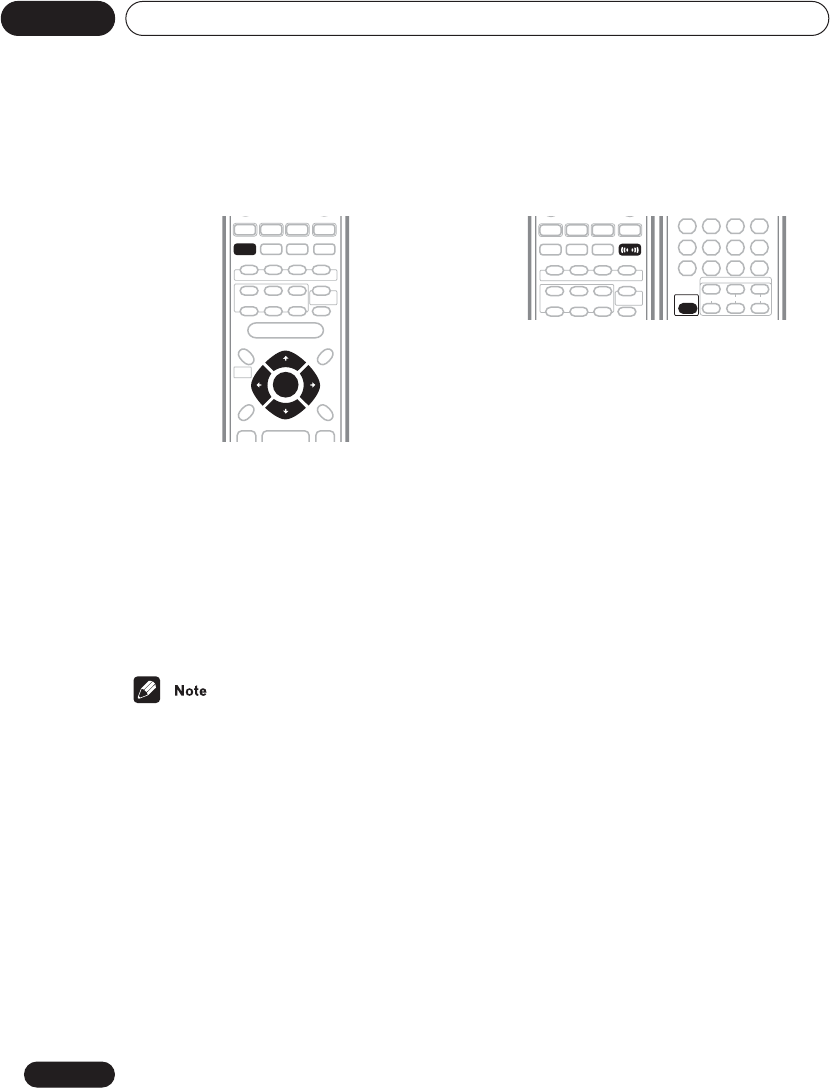
Listening to your system05
48
En
Adjusting the bass and treble
Use the bass and treble controls to adjust the
overall tone.
1Press SOUND MODE.
2Use the / (cursor left/right) buttons
to select ‘Bass’ or ‘Treble’.
3Use the / (cursor up/down) buttons
to adjust the sound.
The bass and treble can be adjusted from –3 to
+3.
4 Press ENTER to confirm.
•Bass and treble adjustment is not possible
when the Quiet or Midnight modes are
active.
Boosting the bass level
There are three bass modes you can use to
enhance the bass in a source.
• Press BASS MODE (SHIFT + FRONT
SURROUND) repeatedly to choose an
option that fits the source you’re listening
to.
•Music – Can be used with music to give a
deeper bass sound
•Cinema – Good for action movies or
movies with lots of sound effects
•P. Bass – Can be used with music sources
to bring the beat of the music (or
soundtrack) to the forefront
•Off – Switch off the bass boost if it causes
excessive bass (i.e. it sounds ‘boomy) in
the source
ENTER
SOUND
MODE
BASS MODE
SHIFT

Playing discs 06
49
En
Chapter 6
Playing discs
• Some DVD discs restrict the use of some
functions (random or repeat, for example).
This is not a malfunction.
• When playing Video CDs, some of the
functions are not available during PBC
playback. If you want to use them, start the
disc playing using a number button to
select a track.
• Many features are not available when
using unfinalized CD-R/RW discs.
Playing only CDs, SACDs and
MP3 discs (CD mode)
Using this feature you can play only the CDs,
SACDs and MP3 discs loaded in the disc tray—
automatically skipping over any DVDs and
Video CDs loaded. This may be useful if you
have a mixture of discs loaded but only want to
play music: you don't have to keep track of what
kind of disc is where in the disc tray.
1 Press CD MODE (SHIFT + DISC SKIP) to
switch CD mode on.
• The indicator on the front panel lights
when CD mode is on.
2 Press (play) to start playback.
The first CD loaded automatically starts to play.
Once all the CD/SACD/MP3 discs loaded have
played, playback automatically stops.
• To cancel the CD mode, press CD MODE
(SHIFT + DISC SKIP) again.
• If you open the disc tray and load a DVD,
Video CD or JPEG disc in the front-most
position then press (play) (on the front
panel), CD mode is canceled.
•You can't switch on CD mode while playing
a DVD or Video CD. Stop playback first.
• Although program play is not possible in
CD mode, it is possible to program a
playlist. When you start program play-back,
however, CD mode is canceled.
• Repeat and random play is possible in CD
mode (see Using repeat play on page 52
and Using random play on page 52).
Scanning discs
You can fast-scan discs forward or backward at
various different speeds.
1 During playback, press or to
start scanning.
• There is no sound while scanning DVDs
and Video CDs, and no subtitles while
scanning DVDs.
2 Press repeatedly to increase the
scanning speed.
• The scanning speed is shown on-screen.
3 To resume playback, press (play).
• When scanning a Video CD or a /MP3
track, playback automatically resumes at
the end or beginning of the track.
• Depending on the disc, normal playback
may automatically resume when a new
chapter is reached on a DVD disc.
Playing in slow motion
You can play DVDs and Video CDs at four
different forward slow motion speeds. DVD
discs can also be played at two reverse speeds.
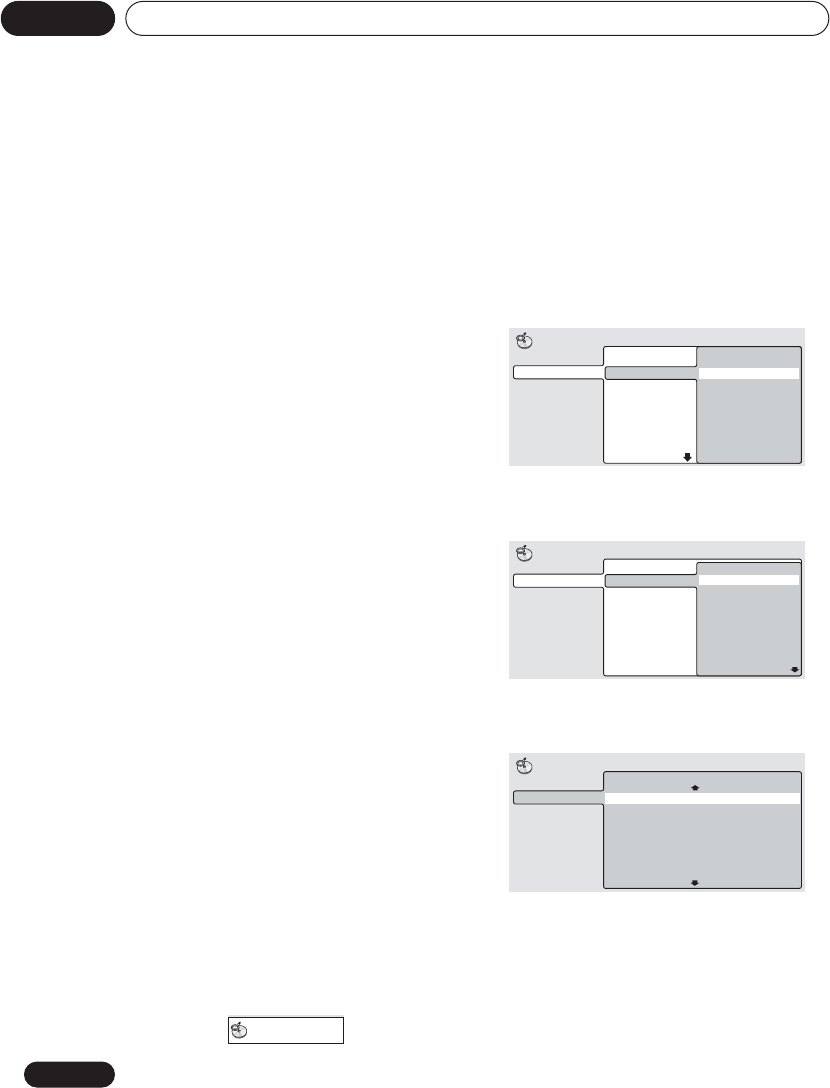
Playing discs06
50
En
1 During playback, press (pause).
2 Press and hold / or / until
slow motion playback starts.
• The slow motion speed is shown on-
screen.
• There is no sound during slow motion
playback.
3 Press repeatedly to change the slow
motion speed.
4 To resume normal playback, press
(play).
• Depending on the disc, normal playback
may automatically resume when a new
chapter is reached.
Frame advance/frame reverse
You can advance or back up DVD discs frame-
by-frame. With Video CDs you can only use
frame advance.
1 During playback, press (pause).
2 Press / or / to reverse or
advance a frame at a time.
3 To resume normal playback, press
(play).
• Depending on the disc, normal playback
may automatically resume when a new
chapter is reached.
Using the Disc Navigator to
browse the contents of a disc
Use the Disc Navigator to browse through the
contents of a disc to find the part you want to
play. You can use the Disc Navigator when a
disc is playing or stopped (a disc must be
loaded).
1 Press HOME MENU and select ‘Disc
Navigator’ from the on-screen display.
• With most discs, you can also press DVD
MENU to go directly to the Disc Navigator.
2 Select what you want to play.
Depending on the type of disc you have loaded,
the Disc Navigator looks slightly different.
The screen for DVD discs shows the titles on
the left and the chapters on the right. Select a
title, or a chapter within a title.
For DVD-Audio discs select a group, or a track
within a group.
For SACD discs select a track within the
current playback area.
For a VR format DVD-RW disc select between
the PlayList and Original areas of the disc, or
a title. Press (cursor right) to preview the
title.
• You can’t switch between Original and
PlayList during playback.
Disc Navigator
Title 1-10
Title 01
Title 02
Title 03
Title 04
Title 05
Title 06
Title 07
Title 08
DVD
Disc Navigator
Chapter 1-3
Chapter 001
Chapter 002
Chapter 003
Group 1-03
DVD-Audio
Disc Navigator
Track 1-14
Group 01
Group 02
Group 03
Track 01
Track 02
Track 03
Track 04
Track 05
Track 06
Track 07
Track 08
Track 1-09
Track 01
Track 02
Track 03
Track 04
Track 05
Track 06
Track 07
Track 08
2ch Area
Disc Navigator
Total Time 40.31
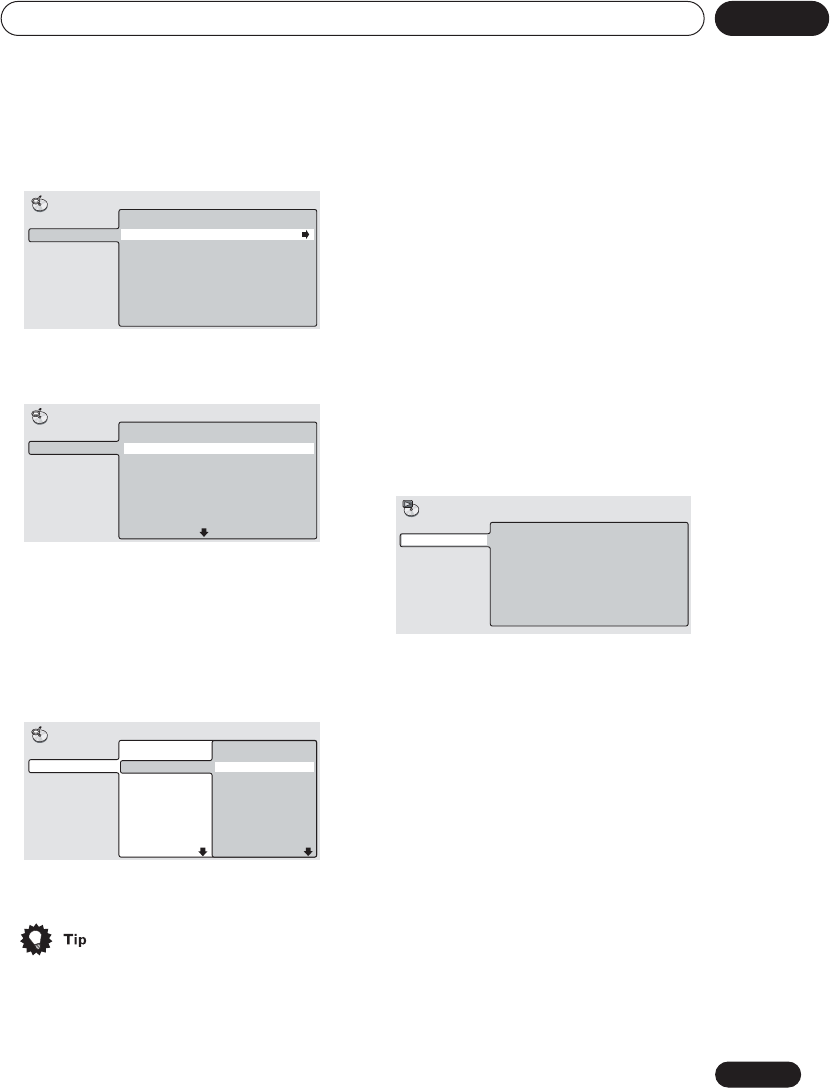
Playing discs 06
51
En
• Not all VR format DVD-RW discs have a
Playlist.
The screen for SACDs, CDs and Video CDs
shows a list of tracks.
The screen for MP3 discs shows the folder
names on the left and the track names on the
right (note that any folder and track names that
contain accented or non-roman characters,
will show up with generic names – F_033,
T_035, etc.).
Select a folder, or a track within a folder.
Playback starts after you press ENTER.
•Another way to find a particular place on a
disc is to use one of the search modes. See
Searching a disc on page 56.
• For DVD-Audio discs featuring browsable
pictures (page 91), press / / /
to view the previous/next picture.
Looping a section of a disc
The A-B Repeat function allows you to specify
two points (A and B) within a track (CD and
Video CD) or title (DVD) that form a loop which
is played over and over.
•You can’t use A-B Repeat with DVD-Audio,
SACD or MP3 discs.
1 During playback, press HOME MENU
and select ‘Play Mode’.
2 Select ‘A-B Repeat’ from the list of
functions on the left.
3 Press ENTER on ‘A(Start Point)’ to set
the loop start point.
4Press ENTER on ‘B(End Point)’ to set the
loop end point.
After pressing ENTER, playback jumps back to
the start point and plays the loop.
• The minimum loop time is 2 seconds.
5To resume normal playback, select ‘Off’
from the menu.
Title(1-03)
01. 3/31 FIRST LEAGUE
02. 4/28 SECOND LEAGUE
03. 4/29 FINAL ROUND
Original
Play List
Disc Navigator
DVD-RW
Track 1-10
Track 01
Track 02
Track 03
Track 04
Track 05
Track 06
Track 07
Track 08
CD
Disc Navigator
Folder 1-17
001. ACP
002. Nth Degree
003. Pfeuti
004. Live
005. Glitch music
006. CodHead
007. Thermo
008. Missing Man
MP3
Disc Navigator
Track 1-10
001. Gravity deluxe
002. Tesla's patent
003. Border dispute
004. Delayed by rain
005. Accident incident
006. Pigeon post
007. Outernational
008. Vacuum tube
A(Start Point)
B(End Point)
Off
A-B Repeat
Repeat
Random
Program
Search Mode
Play Mode
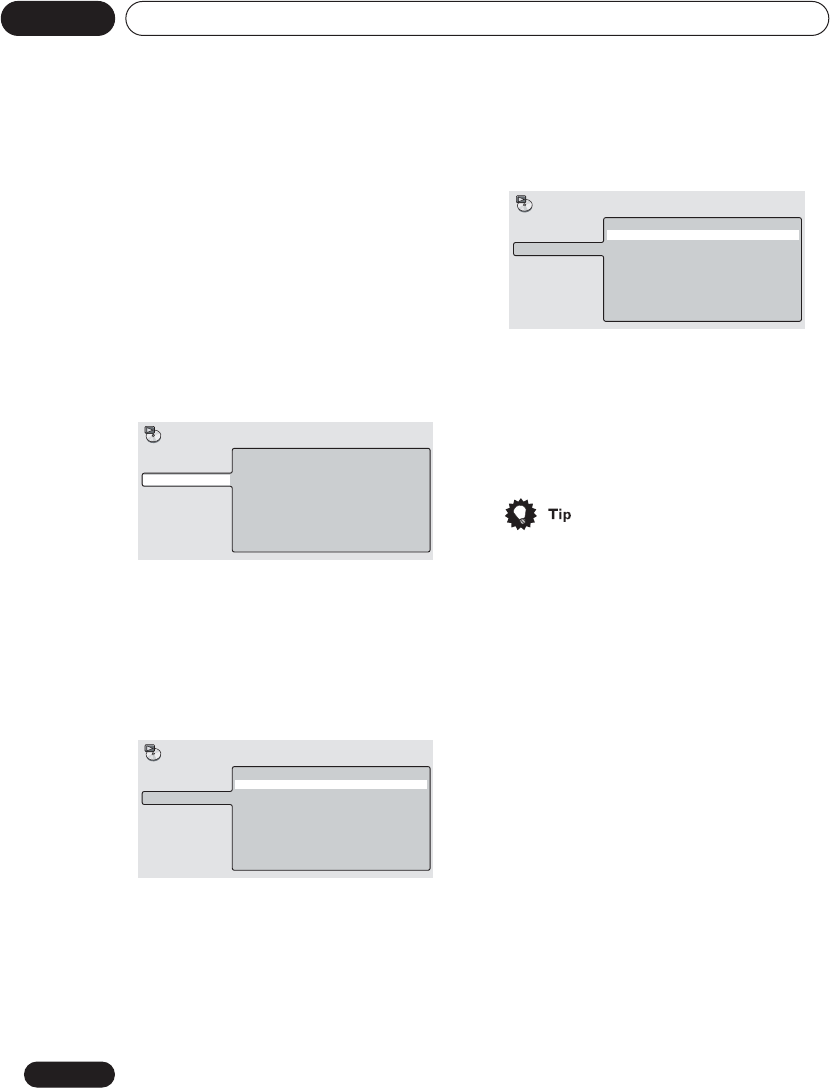
Playing discs06
52
En
Using repeat play
There are various repeat play options,
depending on the kind of disc loaded. It’s also
possible to use repeat play together with
program play to repeat the tracks/chapters in
the program list (see Creating and editing a
DVD program list on page 53 and Creating and
editing a non-DVD program list on page 54).
1 During playback, press HOME MENU
and select ‘Play Mode’.
2Select ‘Repeat’ from the list of functions
on the left.
3 Select a repeat play option.
If program play is active, select Program
Repeat to repeat the program list, or Repeat
Off to cancel.
•For DVD-Video and DVD-RW discs, select
Title Repeat or Chapter Repeat (or
Repeat Off).
For DVD-Audio discs, select Group Repeat or
Track Repeat (or Repeat Off).
•For SACDs, CDs and Video CDs, select All
Discs Repeat, Disc Repeat or Track
Repeat (or Repeat Off).
• For MP3 discs, select All Discs Repeat,
Disc Repeat, Folder Repeat or Track
Repeat (or Repeat Off).
• You can also use the REPEAT (SHIFT + 2)
button on the remote to select a repeat play
mode. The repeat mode is indicated in the
front panel display and on-screen. The
repeat modes available are the same as
when choosing from the Play Mode menu.
• If you’ve created a program list, Program
Repeat is also available.
• During random playback (see below),
Random Repeat is also available.
Using random play
Use the random play function to play titles or
chapters (DVD-Video), groups or tracks (DVD-
Audio), or tracks (CD, SACD, Video CD and
MP3 discs) in a random order.
You can set the random play option when a
disc is playing or stopped. However, you can't
use random play together with program play.
•You can’t use random play with VR format
DVD-RW discs, or while a DVD disc menu
is being displayed.
Title Repeat
Chapter Repeat
Repeat Off
A-B Repeat
Repeat
Random
Program
Search Mode
Play Mode
Title Repeat
Chapter Repeat
Repeat Off
A-B Repeat
Repeat
Random
Program
Search Mode
Play Mode
Group Repeat
Track Repeat
Repeat Off
A-B Repeat
Repeat
Random
Program
Search Mode
Play Mode
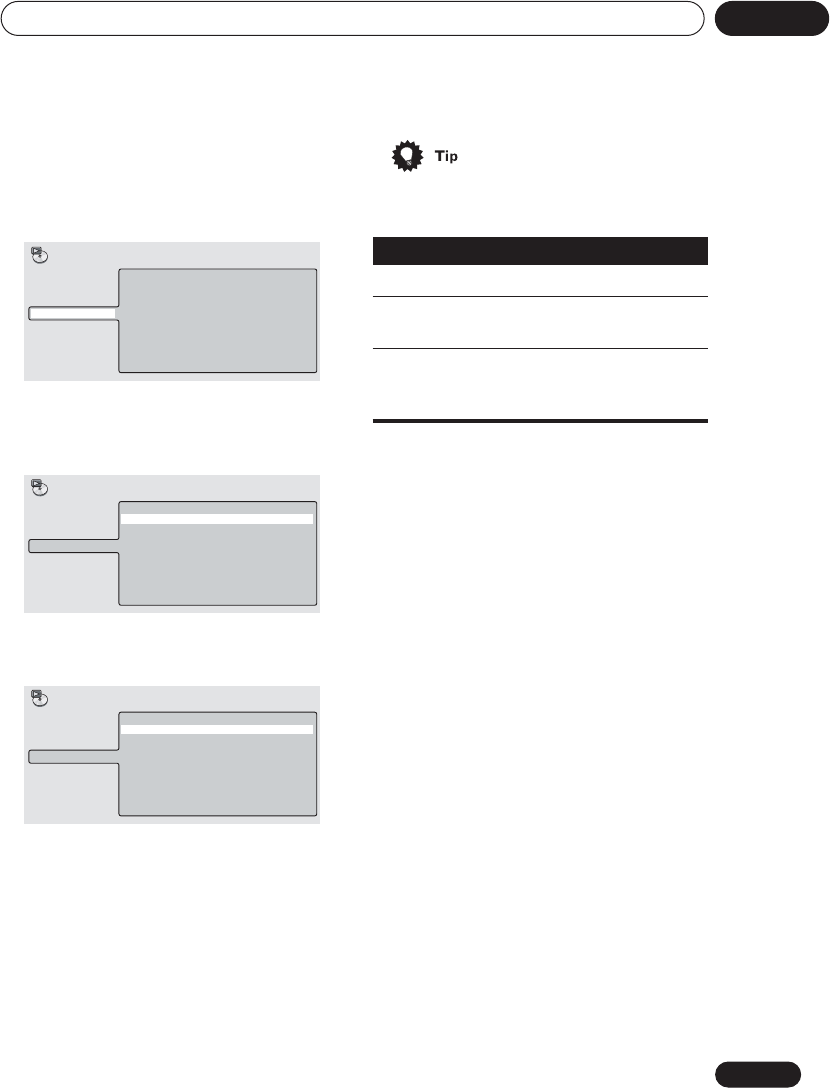
Playing discs 06
53
En
1 Press HOME MENU and select ‘Play
Mode’.
2 Select ‘Random’ from the list of
functions on the left.
3 Select a random play option.
•For DVD-Video discs, select Random Title
or Random Chapter (or Random Off)
For DVD-Audio discs, select Random Group
or Random Track, (or Random Off).
•For CDs, Video CDs and MP3 discs, select
Random All, Random Disc (or Random
Off).
• The Random All function ignores DVDs
loaded in the player.
• Use the following controls during random
play:
• You can also use the RANDOM (SHIFT +
3) button on the remote to select a random
play mode. The random mode is indicated
in the front panel display and on-screen.
The random modes available are the same
as when choosing from the Play Mode
menu. Press ENTER to start random play.
• To cancel random playback without
stopping playback, press CLEAR. The disc
will play to the end, then stop.
Creating and editing a DVD
program list
This feature lets you program the play order of
titles and chapters on the DVD disc currently in
the play position.
If you want to program the play order of CDs,
Video CDs or MP3 discs, see Creating and
editing a non-DVD program list on page 54.
•You can’t use Program play with VR format
DVD-RW discs, or while a DVD disc menu
is being displayed.
1 Make sure that the DVD disc you want
to make the program list for is in the play
position.
Use the DISC select buttons on the remote, or
the DIRECT PLAY buttons on the front panel to
select the disc.
Random Title
Random Chapter
Random Off
A-B Repeat
Repeat
Random
Program
Search Mode
Play Mode
Random Title
Random Chapter
Random Off
A-B Repeat
Repeat
Random
Program
Search Mode
Play Mode
Random Group
Random Track
Random Off
A-B Repeat
Repeat
Random
Program
Search Mode
Play Mode
Button What it does
Stop and cancel random play.
Selects another track/chapter at
random from those remaining.
Returns to the beginning of the
current track/chapter. You can't
go back further than this.
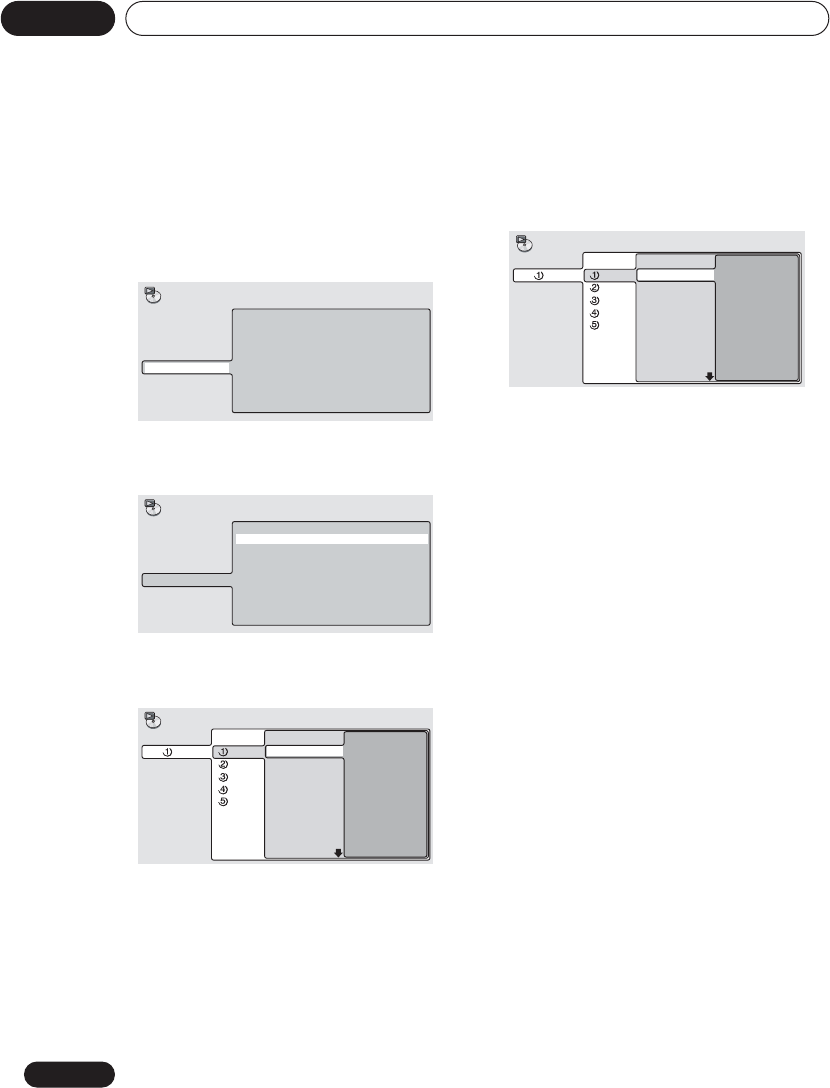
Playing discs06
54
En
2 Press HOME MENU and select ‘Play
Mode’.
• Alternatively, press PROGRAM (SHIFT +
1) and skip to step 5.
3 Select ‘Program’ from the list of
functions on the left.
4 Select ‘Create/Edit’ from the list of
program options.
5 Select a title or chapter for the first/
next step in the program list.
• When this screen first appears, the first
title on the disc is highlighted. From here
you can select a title, or a chapter within a
title.
• Some titles and/or chapters of DVD discs
may be grayed out, depending on the disc.
Grayed out titles/chapters can’t be added
to the program list.
6 Press ENTER to add the highlighted
item to the program list.
The program step number automatically
moves to the next position.
7Add further items to the program list in
the same way.
•A program list can contain up to 24 steps.
•To clear a step in the program list, move to
the Program Step column, highlight the
step to clear and press CLEAR.
•To insert a step in the program list, move to
the Program Step column and highlight
the step where you want a new step to
appear. After you select a title/chapter, all
the program steps will move down one to
make space for the new one.
8To play the program list, press (play).
•Program play remains active until you turn
off program play (see below), erase the
program list (see below), or switch off the
system.
Creating and editing a non-
DVD program list
This feature lets you program the play order of
folders and tracks on the CDs, Video CDs and
MP3 discs loaded.
If you want to program the play order of a DVD
disc, see Creating and editing a DVD program
list on page 53.
Create/Edit
Playback Start
Playback Stop
Program Delete
A-B Repeat
Repeat
Random
Program
Search Mode
Play Mode
Create/Edit
Playback Start
Playback Stop
Program Delete
A-B Repeat
Repeat
Random
Program
Search Mode
Play Mode
Program Step
01. -01
02.
03.
04.
05.
06.
07.
08.
Title 1-38
Title 01
Title 02
Title 03
Title 04
Title 05
Title 06
Title 07
Title 08
Chapter 1-4
Chapter 001
Chapter 002
Chapter 003
Chapter 004
Program
Disc
. DVD
. CD
. DVD
. ???
. ---
Program Step
01. -01
02.
03.
04.
05.
06.
07.
08.
Title 1-38
Title 01
Title 02
Title 03
Title 04
Title 05
Title 06
Title 07
Title 08
Chapter 1-4
Chapter 001
Chapter 002
Chapter 003
Chapter 004
Program
Disc
. DVD
. CD
. DVD
. ???
. ---
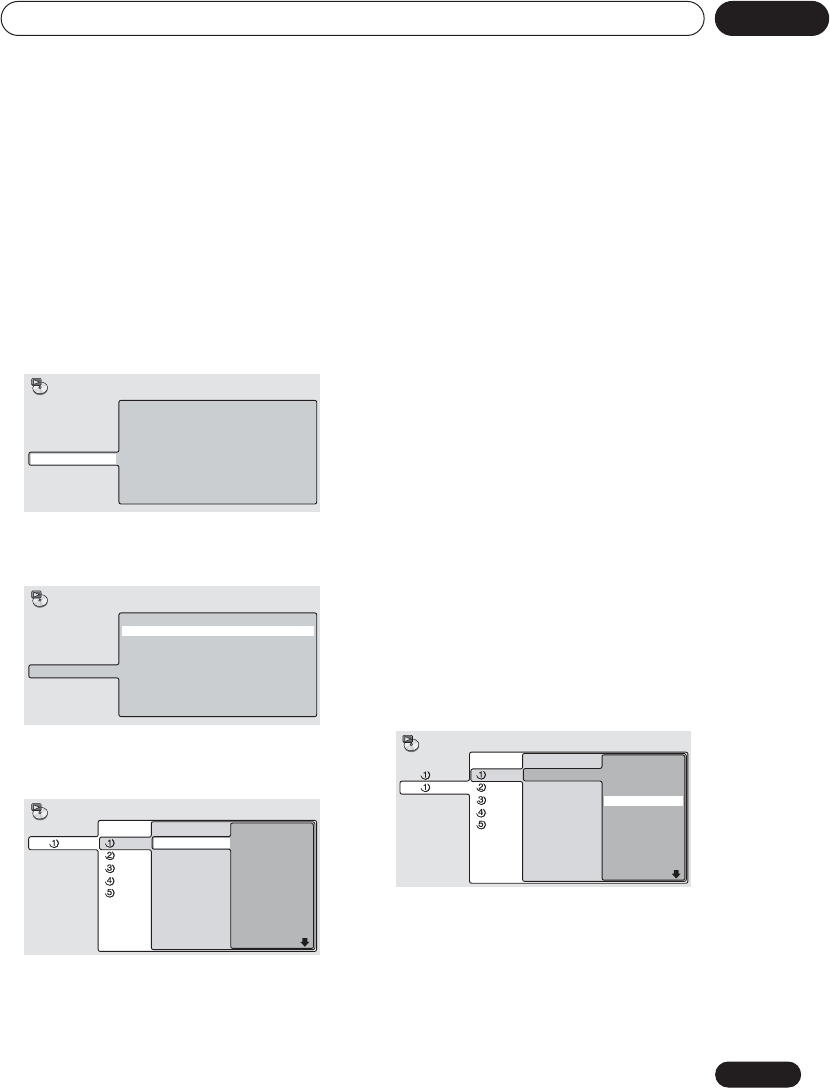
Playing discs 06
55
En
1Make sure that a non-DVD disc is in the
play position.
Use the DIRECT PLAY buttons on the front
panel to select a disc.
2 Press HOME MENU and select ‘Play
Mode’.
• Alternatively, press PROGRAM (SHIFT +
1) and skip to step 5.
3 Select ‘Program’ from the list of
functions on the left.
4 Select ‘Create/Edit’ from the list of
program options.
5Select a folder or track for the first/next
step in the program list.
• When this screen first appears, the first
folder or track of the disc in the play
position is highlighted. From here you can
select something on this disc, or move left
to the Disc column and select something
from one of the other discs loaded.
•With MP3 discs, you can select a folder, or
an individual track in a folder.
• With CDs and Video CDs, select a track.
• Any DVDs loaded are shown grayed out
and can’t be selected.
• If the system has not yet determined the
type of disc in a tray position, ‘???’ is
displayed as the disc type. If you select it,
‘??? 1-999’ is displayed in the middle and
right columns. You can add items to the
program list from this disc, although what
you select must actually exist on the disc
for it to play. Also, if the disc is a DVD,
program play will be canceled when it
comes to that disc in the program list
• If a tray position is empty, ‘– – –’ is
displayed.
6 Press ENTER to add the highlighted
item to the program list.
The program step number automatically
moves to the next position.
7Add further items to the program list in
the same way.
•A program list can contain up to 24 steps.
•To clear a step in the program list, move to
the Program Step column, highlight the
step to clear and press CLEAR.
Create/Edit
Playback Start
Playback Stop
Program Delete
A-B Repeat
Repeat
Random
Program
Search Mode
Play Mode
Create/Edit
Playback Start
Playback Stop
Program Delete
A-B Repeat
Repeat
Random
Program
Search Mode
Play Mode
Program Step
01. -01
02.
03.
04.
05.
06.
07.
08.
Folder 1-6
001. Electro A-M
002. Electro N-Z
003. Rock 1
004. Rock 2
005. Jazz
006. Classical
Track 1-10
001. Gravity Deluxe
002. Tesla's Patent
003. Border Dispute
004. Delayed by Rai
005. Pigeon Post
006. Outernational
007. Panic Button
008. Accident Incide
Program
Disc
. MP3
. CD
. DVD
. ???
. ---
Program Step
01. -001-003
02. -001-003
03.
04.
05.
06.
07.
08.
Folder 1-6
001. Electro A-M
002. Electro N-Z
003. Rock 1
004. Rock 2
005. Jazz
006. Classical
Track 1-10
001. Gravity Deluxe
002. Tesla's Patent
003. Border Dispute
004. Delayed by Rai
005. Pigeon Post
006. Outernational
007. Panic Button
008. Accident Incide
Program
Disc
. MP3
. CD
. DVD
. ???
. ---

Playing discs06
56
En
•To insert a step in the program list, move to
the Program Step column and highlight
the step where you want a new step to
appear. After you select a folder/track, all
the program steps will move down one to
make space for the new one.
8To play the program list, press (play).
•Program play remains active until you turn
off program play (see below), erase the
program list (see below), or switch off the
system.
•Use the following controls during program
play:
•The current playlist is erased if you change
the type of disc in the play position (DVD or
non-DVD) or select Program Delete from
the Play Mode menu.
•DVD playback follows commands recorded
on the disc. There may be cases where
program play is automatically canceled or
may not work. This is not a malfunction
•With Video CDs that feature PBC playback,
make sure that the disc is stopped before
you start making the program list.
Other functions available from the
program menu
There are a number of other options in the
program menu in addition to Create/Edit.
•Playback Start – Starts playback of a
saved program list
•Playback Stop – Turns off program play,
but does not erase the program list
•Program Delete – Erases the program list
and turns off program play
Searching a disc
You can search DVD-Video discs by title or
chapter number, or by time. DVD-Audio discs
can be searched by group or track number.
SACDs and CDs can be searched by track
number, and Video CDs by track number or
time. MP3 discs can be searched by folder or
track number.
1 Press HOME MENU and select ‘Play
Mode’.
2 Select ‘Search Mode’ from the list of
functions on the left.
The search options that appear depend on the
kind of disc loaded. The screen below shows
the DVD-Video search options.
3 Select a search mode.
• The disc must be playing in order to use
time search.
Button What it does
HOME
MENU Save the program list and exit
the program edit screen without
starting playback.
Skip to the next step in the
program list.
CLEAR Switch off program play. Press
while stopped to erase the
program list.
RETURN Exit the program edit screen
without saving any changes.
Title Search
Chapter Search
Time Search
A-B Repeat
Repeat
Random
Program
Search Mode
Play Mode
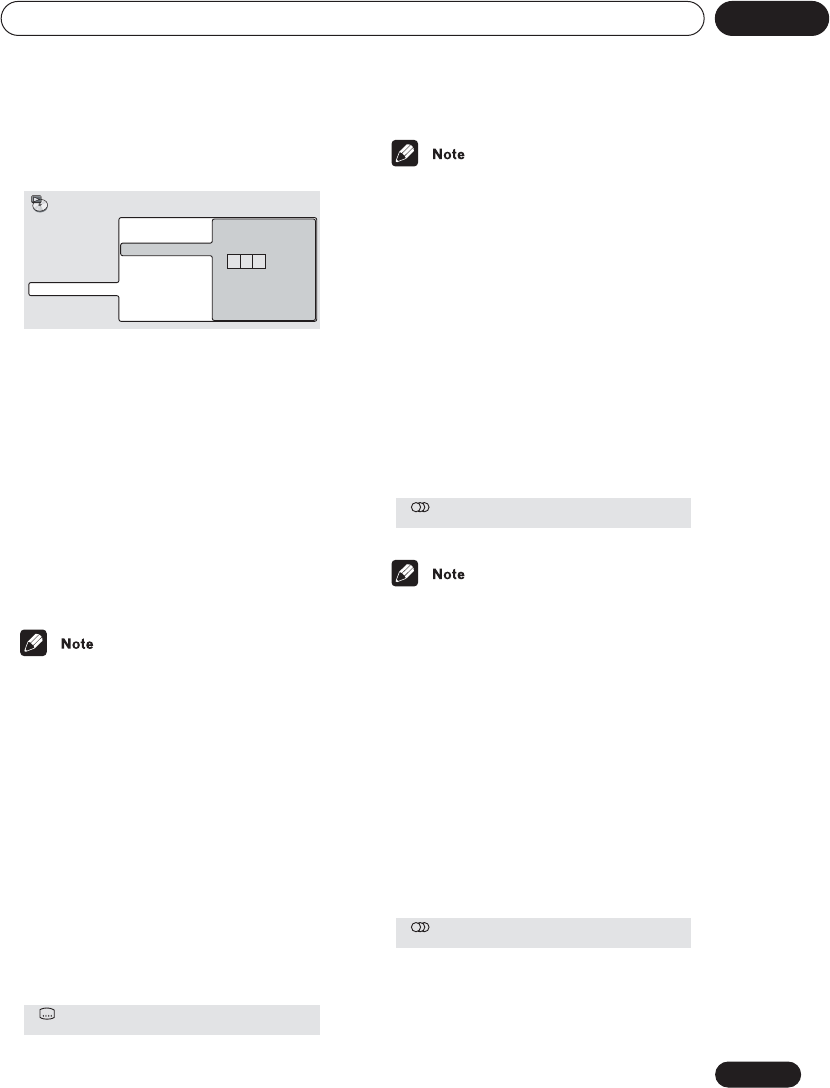
Playing discs 06
57
En
4Use the number buttons to enter a title,
chapter, folder or track number, or a time.
• For a time search, enter the number of
minutes and seconds into the currently
playing title (DVD-Video/DVD-RW) or track
(Video CD) you want playback to resume
from. For example, press 4, 5, 0, 0 to have
playback start from 45 minutes into the
disc. For 1 hour, 20 minutes and 30
seconds, press 8, 0, 3, 0.
• Some DVD-Audio discs feature pages of
browsable pictures. Enter the page
number you want.
5 Press ENTER to start playback.
• The disc must be playing in order to use
time search.
• You can only use time search with DVD-
Video and Video CD discs.
•With disc sets of SACDs, you may find that
some discs don’t begin at track 1.
Switching subtitles
Some DVD discs have subtitles in one or more
languages; the disc box will usually tell you
which subtitle languages are available. You
can switch subtitle language during playback.
• Press SUBTITLE repeatedly to select a
subtitle option.
• Some discs only allow you to change
subtitle language from the disc menu.
Press DVD MENU to access.
• To set subtitle preferences, see Language
settings on page 70.
Switching DVD audio
language
When playing a DVD disc recorded with dialog
in two or more languages, you can switch
audio language during playback.
• Press AUDIO repeatedly to select an
audio language option.
•Some discs only allow you to change audio
language from the disc menu. Press DVD
MENU to access.
• To set audio language preferences, see
Language settings on page 70.
Switching audio channels
when playing a Video CD
When playing a Video CD, you can switch
between stereo, just the left channel or just the
right channel.
• Press AUDIO repeatedly to select an
audio channel option.
0 0 1
Title Search
Chapter Search
Time Search
Input Chapter
A-B Repeat
Repeat
Random
Program
Search Mode
Play Mode
Subtitle English1/2
Current / Total
Audio French Dolby Digital 3/2.1CH1/2
Current /Total
Audio Stereo
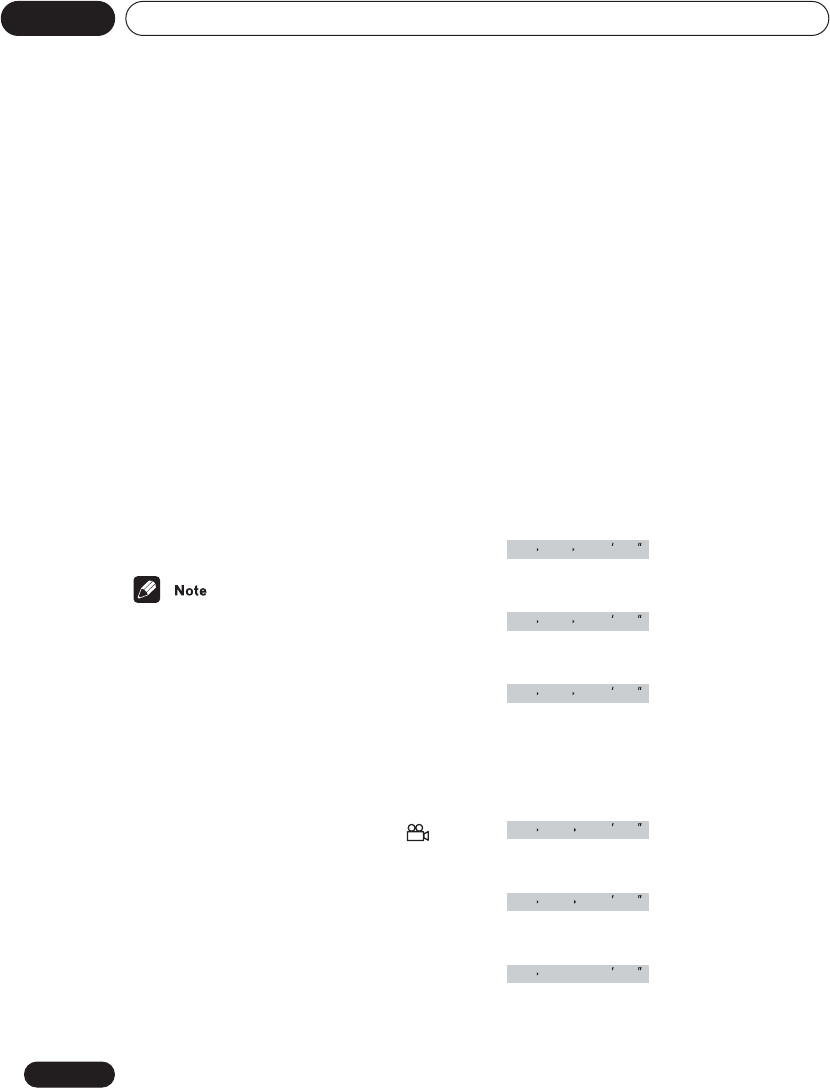
Playing discs06
58
En
Zooming the screen
Using the zoom feature you can magnify a part
of the screen by a factor of 2 or 4, while
watching a DVD-Video, DVD-Audio or Video
CD.
1During playback, use the ZOOM button
to select the zoom factor (Normal, 2x or
4x).
• Since DVD-Video, DVD-Audio and Video
CD has a fixed resolution, picture quality
will deteriorate, especially at 4x zoom. This
is not a malfunction.
2 Use the cursor buttons to change the
zoomed area.
You can change the zoom factor and the
zoomed area freely during playback.
• If the navigation square at the top of the
screen disappears, press ZOOM again to
display it.
• If you are displaying subtitles, these will
disappear when the screen is zoomed.
They will reappear when you return the
screen to normal.
Switching camera angles
Some DVD-Video discs feature scenes shot
from two or more angles—check the disc box
for details.
When a multi-angle scene is playing, a
icon appears on screen and in the front panel
display to let you know that other angles are
available (this can be switched off if you
prefer—see Display settings on page 70).
• During playback (or when paused),
press ANGLE to switch angle.
Displaying disc information
OSD disc information
Various track, chapter and title information
can be displayed on-screen while a disc is
playing.
• To show/switch/hide the information
displayed, press DISPLAY (SHIFT + 8)
repeatedly.
• When a disc is playing, the information
appears at the top of the screen.
Front panel display information
Limited disc information also appears in the
front panel display. Press DISPLAY (SHIFT +
8) to change the displayed information.
• DVD / DVD-RW displays
Disc no.
Chapter no.
Elapsed title time
Disc no.
Title no.
Remaining title time
Disc no.
Chapter no.
Remaining chapter
time
•SACD, CD and Video CD displays
Disc no.
Track no.
Elapsed track time
Disc no.
Track no.
Remaining track time
Disc no.
Remaining disc time
22 849
2T 110700
22 042
14 116
14 320
1Dsc 53 15

Playing discs 06
59
En
• MP3 disc displays
Disc no.
Track no.
Elapsed track time
Disc no.
Track name
Disc no.
Folder name
• JPEG disc displays
Disc no.
File name
Disc no.
Folder name
• DVD Audio displays
Disc no.
Track no.
Elapsed track time
Disc no.
Track no.
Remaining track time
Disc no.
Group no.
Remaining group time
42 035
4EVERYBOD
4BEST_OF_
2TIGER_01
2ZOO_TRIP
22 849
2T 110700
1630 21

Viewing JPEG discs07
60
En
Chapter 7
Viewing JPEG discs
Playing a JPEG slideshow
After loading a CD/CD-R/RW containing JPEG
pictures, press (play) to start a slideshow
from the first folder/picture on the disc. The
pictures in each folder are displayed in
alphabetical order.
Pictures are automatically adjusted so that
they fill as much of the screen as possible (if
the aspect ratio of the picture is different to
your TV screen you may notice black bars at the
sides, or at the top and bottom of the screen).
While the slideshow is running:
• The (pause), ANGLE and ZOOM buttons
do not work while the display shows
LOADING.
•The time it takes for a file to load increases
with large file sizes.
• Up to 999 files are viewable on a disc. If
there are more files than this on a disc, only
the first 999 files are viewable.
•If you want to play the MP3 tracks on a disc
that also contains JPEG picture files, you
should first set the Photoviewer option to
Off. See Options on page 71.
Using the JPEG Disc Navigator
and Photo Browser
Use the JPEG Disc Navigator to find a
particular folder or picture by filename on the
disc in the play position; use the Photo
Browser to find a picture within a folder by
thumbnail image.
1 Press DVD MENU to display the Disc
Navigator screen.
The left column shows the folders on the disc,
the right column shows the files in a folder.
Button What it does
Pauses the slideshow; press
again to restart.
Displays the previous picture.
Use with SHIFT to jump to the
first file in the previous folder.
Displays the next picture.
Use with SHIFT to jump to the
first file in the next folder.
ANGLE Pauses the slideshow and
rotates the currently displayed
picture 90º clockwise. Press
(play) to restart slideshow).
ZOOM Pauses the slideshow and zooms
the screen (see below). Press
(play) to restart slideshow).
DVD
MENU Displays the Disc Navigator
screen (see below).
FOLDER +/
FOLDER – Skips to the next/previous folder
when playing a JPEG disc.
Folder 1-2
001. F_001
002. F_002
JPEG
Disc Navigator
File 1-40
001. FL000001
002. FL000002
003. FL000003
004. FL000004
005. FL000005
006. FL000006
007. FL000007
008. FL000008
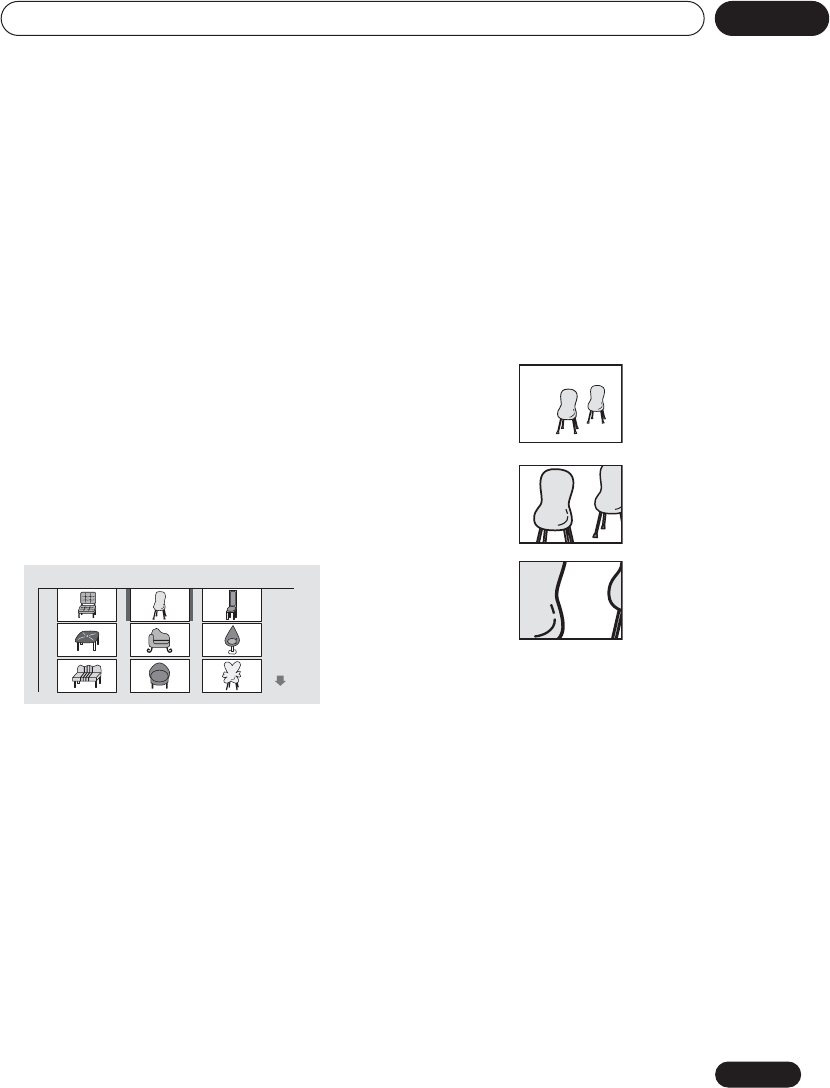
Viewing JPEG discs 07
61
En
2 Use the cursor buttons (///) to
navigate.
When a file is highlighted, a thumbnail image
is displayed.
•When a folder is highlighted you can press
ENTER to open the Photo Browser screen
for that folder. See below for more on using
the Photo Browser.
3 To resume the slideshow from the
highlighted file, press ENTER.
Using the Photo Browser
The Photo Browser displays nine thumbnail
images at a time from the current folder.
1 From the Disc Navigator screen,
highlight a folder to display then press
ENTER.
The Photo Browser screen opens with the first
nine pictures displayed as thumbnails.
2 Use the cursor buttons (///) to
highlight a thumbnail picture.
•Use the track skip buttons ( and ) to
see the previous / next page of thumbnails.
Keep the button pressed if you want to skip
several pages; release when you reach the
page you want.
• To return to the Disc Navigator screen,
press RETURN.
3 Press ENTER to display the selected
thumbnail full size on screen.
The slideshow resumes from the selected
picture.
Zooming the screen
Using the zoom feature you can magnify a part
of the screen by a factor of 2 or 4, while viewing
pictures from a JPEG disc.
1 During slideshow playback, use the
ZOOM button to select the zoom factor.
• Normal
•2x
•4x
• The slideshow is paused when the screen
is zoomed.
• Since JPEG pictures have a fixed
resolution, picture quality may deteriorate,
especially at 4x zoom. This is not a
malfunction.
2 Use the cursor buttons (///) to
change the zoomed area.
You can change the zoom factor and the
zoomed area freely.
3 To resume the slideshow, press
(play).
Photo Browser 2 / 40 Live at Soft
Normal
Zoom 2x
Zoom 4x
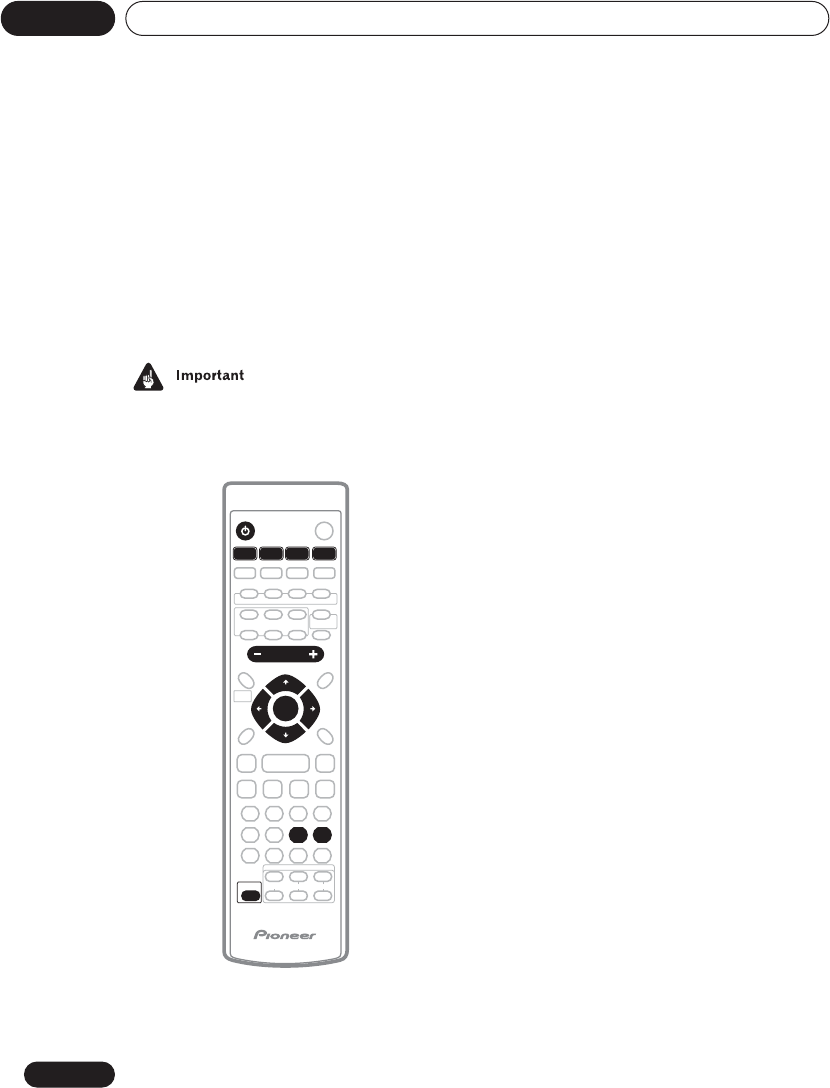
Using the timer08
62
En
Chapter 8
Using the timer
Setting the wake-up timer
Use the wake-up timer to set the system to
switch on at any time and start playing
whatever source you want.
• The clock must be set to the correct time
for the wake-up timer to work properly (see
Setting the clock on page 31).
1 Select the source you want played.
For example, press TUNER (TUNER FM/AM/
ST. on the front panel) to select the radio as
your source.
2 Prepare the source.
For example, tune in the radio station you want
to wake up to.
3 Set the volume.
4Press TIMER (SHIFT + 6) twice to reach
the timer menu.
5Use the / (cursor left/right) buttons
to select ‘Wake-Up?’ then press ENTER.
6Use the / (cursor left/right) buttons
to select ‘Timer Edit?’ then press ENTER.
7 Set the switch-on time.
Use the / (cursor up/down) buttons to set
the hour, then press ENTER. Set the minute in
the same way, pressing ENTER when you’re
done.
8 Set the switch-off time.
Use the / (cursor up/down) buttons to set
the hour, then press ENTER. Set the minute in
the same way, pressing ENTER when you’re
done.
After pressing ENTER this last time, the wake-
up indicator lights, and the switch-on, switch-
off times, the function (DVD/CD, etc.) and
volume are confirmed in the display.
9 Switch the system into standby mode.
The wake-up timer will not work if the system is
left on!
STANDBY/ON
L1/L2FM/AM
SHIFT
VOLUME
DVD/CD
ENTER
ENTER
TUNER TV LINE
TIMER
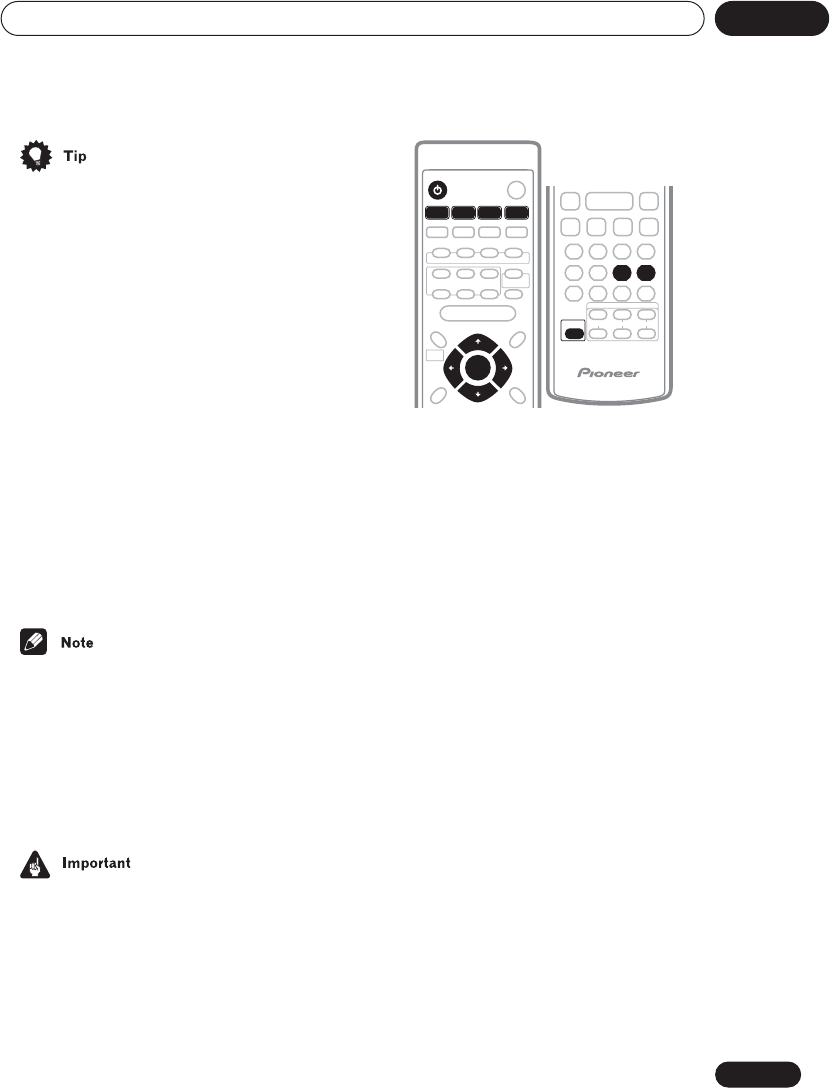
Using the timer 08
63
En
• You can check the timer settings in
standby by pressing TIMER (SHIFT + 6)
twice. (Press TIMER (SHIFT + 6) once to
display the current time.)
Turning the wake-up timer on/off
If the wake-up timer is on, it will switch on the
system everyday at the time you have set.
1Press TIMER (SHIFT + 6) twice to reach
the timer menu.
2Use the / (cursor left/right) buttons
to select ‘Wake-Up?’ then press ENTER.
3Use the / (cursor left/right) buttons
to select ‘Timer On?’ or ‘Timer Off?’.
•You must have the timer set (see above) to
select On. The wake-up timer switches on
and off according to your previous settings.
4Press ENTER.
• The wake-up timer will automatically be
canceled if the clock is reset.
Setting the sleep timer
The sleep timer switches off the system after a
specified time so you can fall asleep without
worrying about it.
•If you set the sleep timer while the wake-up
timer is active, the earlier switch off time
takes priority.
1Press TIMER (SHIFT + 6) twice to reach
the timer menu.
2Use the / (cursor left/right) buttons
to select ‘Sleep?’ then press ENTER.
3Use the / (cursor up/down) buttons
to select a switch-off time then press
ENTER.
Choose between the following options:
•Sleep Auto – Available only in CD mode;
the system switches off automatically after
the currently playing disc has finished (not
possible during repeat play).
•Sleep 90 – System switches off after 90
minutes
•Sleep 60 – System switches off after an
hour
•Sleep 30 – System switches off after 30
minutes
•Off – cancels the sleep timer
4 To check how much time is left, repeat
steps 1 and 2.
The remaining time is displayed momentarily.
• The front panel display dims when the
sleep timer is active.
STANDBY/ON
L1/L2FM/AM
DVD/CD
ENTER
TUNER TV LINE
SHIFT
ENTER
TIMER
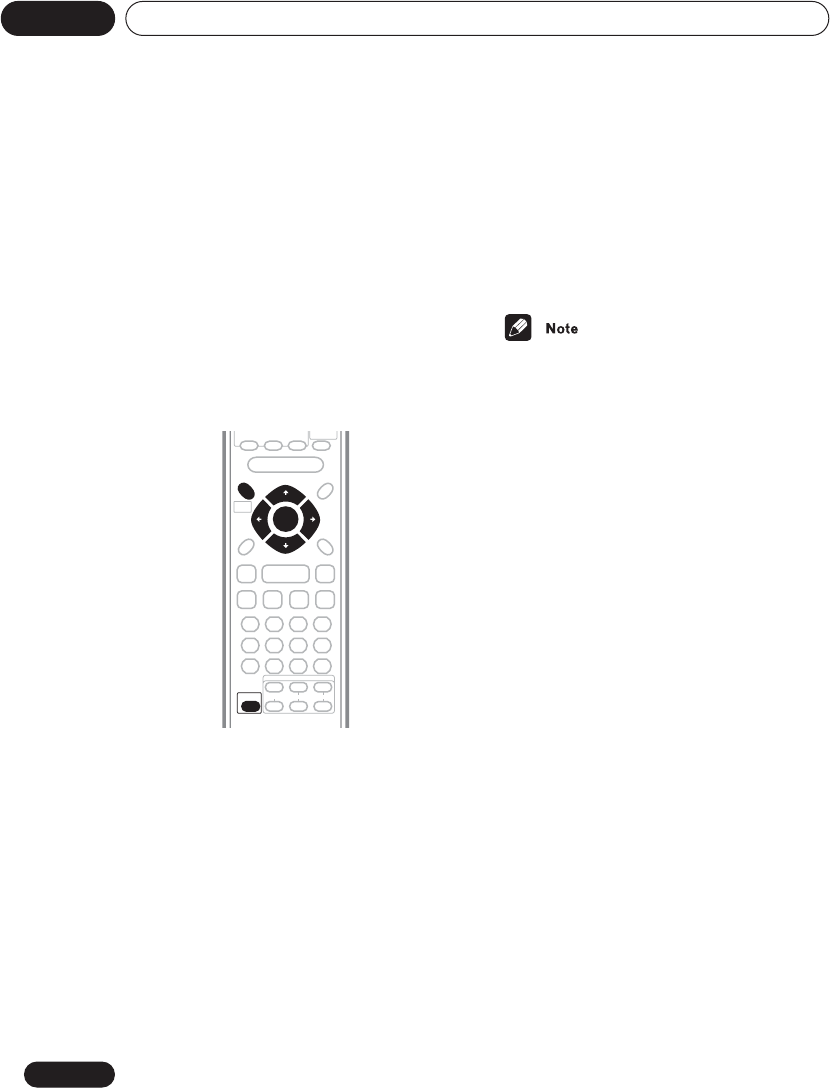
Surround sound and other settings09
64
En
Chapter 9
Surround sound and other settings
Using the System Setup menu
All the available settings in the setup menu are
listed in Surround and sound setup options and
SR+ control options for Pioneer plasma displays
below. See the notes in each section for
additional information about the settings.
Follow the steps below to customize the
settings in the System Setup menu.
1Press SYSTEM SETUP (SHIFT + HOME
MENU).
2Use the / (cursor left/right) buttons
to choose the setting you want to adjust.
The current setting is shown for each option as
you cycle through the display. See below for a
full list and description of each.
3Use the / (cursor up/down) buttons
to adjust the setting.
4 Repeat steps 2 and 3 to make other
settings.
5 When you’re done, press ENTER to
leave the System Setup menu.
• The System Setup menu is exited
automatically after 5 minutes of inactivity.
• You can’t make these settings with the
Recording Mode (page 81) switched on.
Surround and sound setup options
The Room Setup feature (page 31) is designed
to give you a basic surround sound setup,
however you can make more detailed settings
that may improve the surround sound in your
listening room. Note that the first setting in
each section is the default.
Front speakers distance setting
Specifies the distance from your listening
position to the front speakers:
•Front 1 ft. ~ Front 30 ft. – Distance can
be set in increments of 1 ft. The default is
10 ft.
Center speaker distance setting
Specifies the distance from your listening
position to the center speaker:
•Center 1 ft. ~ Center 30 ft. – Distance
can be set in increments of 1 ft. The default
is 10 ft.
Surround speakers distance setting
Specifies the distance from your listening
position to the surround speakers:
•Surr. 1 ft. ~ Surr. 30 ft. – Distance can be
set in increments of 1 ft. The default is 10 ft.
SHIFT
ENTER
SYSTEM SETUP

Surround sound and other settings 09
65
En
Dynamic Range Control
Specifies the amount of dynamic range
adjustment to Dolby Digital or DTS
soundtracks:
•DRC Off – No dynamic range adjustment
(use when listening at higher volume)
•DRC Mid. – Mid setting
•DRC High – Dynamic range is reduced
(loud sounds are reduced in volume while
quieter sounds are increased)
• This setting works only with Dolby Digital
and some DTS soundtracks. For other
sources you can create a similar effect
using the Midnight mode (see Using Quiet
and Midnight listening modes on page 47).
Dual mono setting
Specifies how dual mono encoded Dolby
Digital or DTS soundtracks should be played.
You can also use this setting to switch the
audio channel on DVD-RW discs recorded with
two separate soundtracks.
•L-Ch1 R-Ch2 – Both channels are played
through the front speakers
•Ch1 Mono – Only channel 1 is played
•Ch2 Mono – Only channel 2 is played
•On the Ch1 Mono and Ch2 Mono settings
the sound comes only from the center
speaker (or from the front speakers if
listening in STEREO mode).
• This setting works only with dual mono
encoded Dolby Digital or DTS soundtracks.
See the disc packaging for channel
information.
LFE attenuator setting
Dolby Digital and DTS audio sources include
ultra-low bass tones. Set the LFE attenuator as
needed to prevent the ultra-low bass from
distorting the sound.
•LFE ATT 0 – The LFE channel is played with
no attenuation
•LFE ATT 10 – LFE channel is attenuated by
10dB
•LFE Off – LFE channel is not played
SR+ control options for Pioneer
plasma displays
Make the following settings if you have
connected a Pioneer plasma display to this
unit using an SR+ cable (not supplied).
Note that in the function settings below, the
number of video inputs may change depending
on your display. See also Using this unit with a
Pioneer plasma display on page 18.
Control mode setting
•SR+ Off – Switches SR+ off (this unit and
the plasma display work independently)
•SR+ On – Switches SR+ on (this unit
sends control signals to the plasma
display)
The following settings are only available if the
Control mode setting (above) is switched on.
Volume control setting
•Vol C.Off – This unit does not control the
volume of the plasma display
•Vol C.On – When this unit is switched to
an input that used the plasma display
(DVD, for example), the volume on the
plasma display is muted so only sound
from this unit is heard.
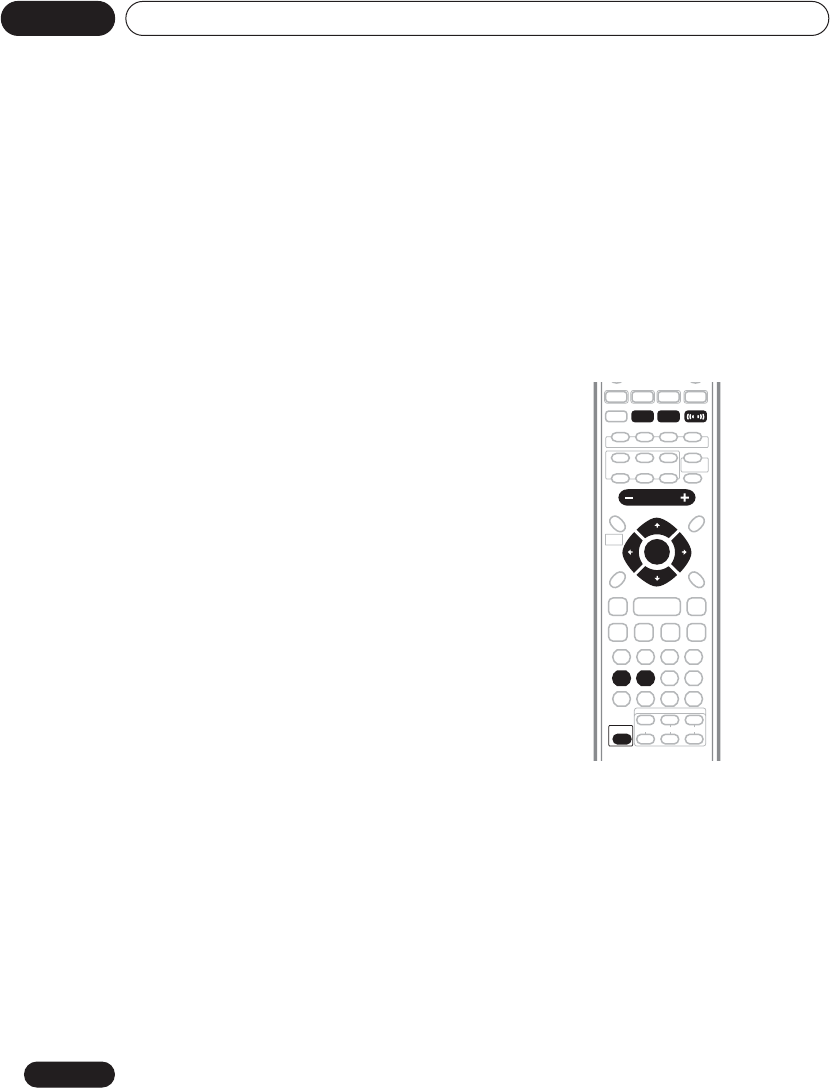
Surround sound and other settings09
66
En
Function setting for DVD input
•DVD -> OFF/PDP1–5/PDPTV – Matches
the DVD function of this unit with a
numbered video input on the plasma
display. For example, DVD -> PDP2
matches the DVD input with video input 2
on the plasma display.
Function setting for TV input
•TV -> OFF/PDP1–5/PDPTV – Matches the
TV function of this unit with a numbered
video input on the plasma display. For
example, TV -> PDP1 matches the TV
input with video input 1 on the plasma
display.
Function setting for L1 input
•LINE1 -> OFF/PDP1–5/PDPTV – Matches
the LINE (L1) function of this unit with a
numbered video input on the plasma
display. For example, LINE1 -> PDP3
matches the LINE1 input with video input 3
on the plasma display.
Function setting for L2 input
•LINE2 -> OFF/PDP1–5/PDPTV – Matches
the LINE (L2) function of this unit with a
numbered video input on the plasma
display. For example, LINE2 -> PDP3
matches the LINE2 input with video input 3
on the plasma display.
Setting the channel levels
You can set the relative channel levels from
your main listening position for all of the
listening modes independently. However, the
SURROUND modes are divided into two
independent groups: multichannel listening
modes and stereo listening modes only.
If you used the Room Setup feature (page 31),
the channel levels for each listening mode will
already be set. However, you can still fine-tune
the levels here if you need to.
1 Select a listening mode.
Press SURROUND, ADVANCED or FRONT
SURROUND repeatedly to select the listening
mode you want.
2Press TEST TONE (SHIFT + 4) to hear the
test tone.
The test tone is output in the following order
(from the speakers active in the current
listening mode):
•L – Front left speaker
•C – Center speaker
•R – Front right speaker
SHIFT
VOLUME
ENTER
SURROUND ADVANCED
TEST TONE CH LEVEL
FRONT
SURROUND

Surround sound and other settings 09
67
En
•RS – Right surround speaker
•LS – Left surround speaker
•SW – Subwoofer
3 Use the VOLUME +/– button to adjust
the volume to an appropriate level.
Turn down the volume to 40 or less to ensure
you have adequate headroom.
4Use the / (cursor up/down) buttons
to adjust the speaker levels in turn.
You should hear the test tone at the same
volume from each speaker when seated in the
main listening position. The channel level
range is ± 10 dB.
5When you’re done, press ENTER to exit
test tone setup.
•The speaker volume can be adjusted while
listening to any sound source you want by
pressing CH LEVEL (SHIFT + 5) and then
using the / (cursor up/down) buttons
to adjust the channel levels. After you’re
finished with one channel, use the /
(cursor left/right) buttons to move to the
next.
•When the Auto listening mode is selected,
using the test tone method will adjust
levels for multichannel sources only. Use
CH LEVEL (SHIFT + 5) and the /
(cursor up/down) buttons (see tip above) to
set levels for the Auto listening mode with
two channel sources.
• Since the subwoofer produces ultra-low
frequencies its sound may seem quieter
than it actually is.
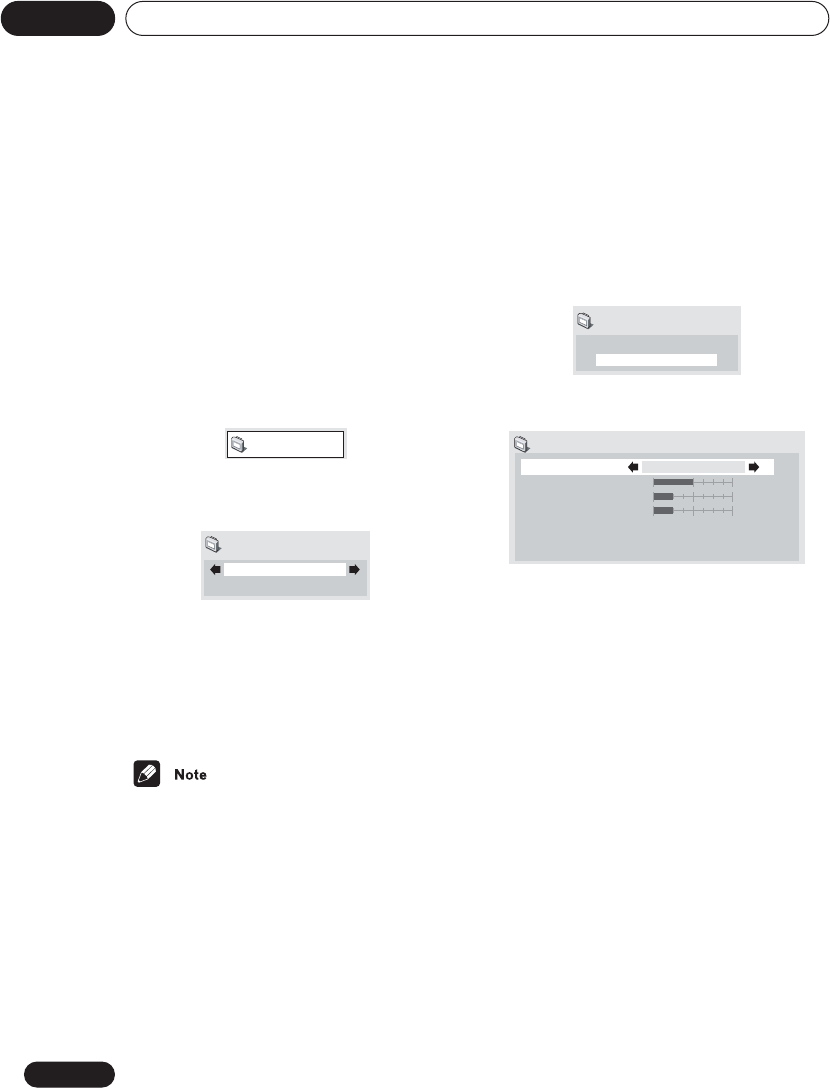
Video Adjust menu10
68
En
Chapter 10
Video Adjust menu
Video Adjust
• Default setting: Standard
From the Video Adjust screen you can select
the standard video presentation or define
presets of your own.
1 Press HOME MENU and select ‘Video
Adjust’ from the on-screen display.
2Use the / (cursor left/right) buttons
to select a preset.
• Standard
•Memory1–2 – Use for saving your own
presets (see below)
3 Press ENTER to make the setting and
exit the Video Adjust screen.
•Depending on the disc and the TV/monitor,
you may not see the effect clearly.
Creating your own presets
You can create up to two presets of your own.
1 Select one of the Memory presets (see
above).
2 Press (cursor down) to select
‘Detailed Settings’ then press ENTER.
3 Adjust the picture quality settings.
•Use the / (cursor up/down) buttons to
select a setting.
•Use the / (cursor left/right) buttons to
adjust the current setting.
• Press DISPLAY (SHIFT + 8) to switch
between full and single view.
•You can switch between preset numbers in
the Recall Settings menu item.
You can adjust any or all of the following
picture quality settings:
•Contrast – Adjusts the contrast between
light and dark.
•Brightness – Adjusts the overall
brightness.
•Chroma Level – Adjusts how saturated
colors appear.
4Press ENTER to save the preset and exit
the Video Adjust screen.
Video Adjust
Standard
Video Adjust
Memory1
Detailed Settings
Video Adjust
Recall Settings
Contrast
Brightness
Chroma Level
Memory1
Memory1
min max
min max
min max

Initial Settings menu 11
69
En
Chapter 11
Initial Settings menu
Using the Initial Settings menu
The Initial Settings menu gives you complete
control in setting up your DVD system,
including video output settings and parental
lock settings, among others.
If an option is grayed out it means that it
cannot be changed at the current time. This is
usually because a disc is playing. Stop the
disc, then change the setting.
1 Press HOME MENU and select ‘Initial
Settings’ from the on-screen display.
2 Use the cursor buttons and ENTER to
select the setting and option you want to
set.
All the settings and options are explained on
the following pages.
• In the table below, the default setting is
shown in bold: other settings are shown in
italics.
•Some settings, such as TV Screen, Audio
Language, Subtitle Language and Auto
Disc Menu may be overridden by the DVD
disc. Often these settings can also be
made from the DVD disc menu.
Video Output settings
Initial Settings
Setting Option What it means
TV Screen
(See also Screen sizes
and disc formats on
page 88.)
4:3 (Letter Box) Set if you have a conventional 4:3 TV. Widescreen movies are
shown with black bars top and bottom.
4:3 (Pan & Scan) Set if you have a conventional 4:3 TV. Widescreen movies are
shown with the sides cropped so that the image fills the screen.
16:9 (Wide) Set if you have a widescreen TV.
Component Out
(See also Connecting
using the component
video output on
page 17.)
Interlace Set if your TV is not compatible with progressive scan video.
Progressive Set if your TV is compatible with progressive scan video (see
your TV’s instruction manual for details). Press ENTER once
more to confirm (or RETURN to cancel).
Note that progressive scan video is only output from the
component video jacks and that there is no output from the
composite and S-video jacks when this setting is selected.

Initial Settings menu11
70
En
Language settings
Display settings
S-Video Out
(See also Connecting
using the S-video output
on page 16.)
S2 Standard setting.
S1 If you find that the picture is stretched or distorted on the
default S2 setting, try changing it to this setting.
Setting Option What it means
Audio Language English If there is an English soundtrack on the disc then it will be
played.
Languages as displayed If there is the language selected on the disc, then it will be
played.
Other Language Select to choose a language other than the ones displayed (see
Selecting languages using the language code list on page 88).
Subtitle Language English If there is are English subtitles on the disc then they will be
displayed.
Languages as displayed If there is the subtitle language selected on the disc, then it will
be displayed.
Other Language Select to choose a language other than the ones displayed (see
Selecting languages using the language code list on page 88).
DVD Menu Lan-
guage w/Subtitle Lang. DVD disc menus will be displayed in the same language as
your selected subtitle language, if possible.
Languages as displayed DVD disc menus will be displayed in the selected language, if
possible.
Other Language Select to choose a language other than the ones displayed (see
Selecting languages using the language code list on page 88).
Subtitle Display On Subtitles are displayed according to your selected subtitle
language (see above).
Off Subtitles are always off by default when you play a DVD disc
(note that some discs override this setting).
Setting Option What it means
OSD Language English On-screen displays of the player are in English.
Languages as displayed On-screen displays are shown in the language selected.
Setting Option What it means

Initial Settings menu 11
71
En
Options
On Screen Display On Operation displays (Play, Resume, Scan, and so on) are
shown on-screen.
Off Operation displays are not shown.
Angle Indicator On A camera icon is displayed on-screen during multi-angle
scenes on a DVD disc.
Off No multi-angle indication is shown.
Setting Option What it means
Parental Lock See below See Parental Lock below.
Bonus Group See below See Bonus Group below.
Auto Disc Menu On The disc menu (Top menu) is automatically displayed after
loading.
Off The disc menu (Top menu) is not displayed after loading.
Group Playback
(For DVD-Audio discs
separated into groups)
Single Playback stops after the selected group is finished playing
(track skip / and scan buttons / can’t be
used). See Searching a disc on page 56 to select a group.
All Plays all groups on a DVD-Audio disc consecutively (if no
group is selected).
DVD Playback
Mode DVD-Audio Normal audio playback of DVD-Audio discs.
DVD-Video Only DVD-Video content (if available) on DVD-Audio discs
will be played.
SACD Playback
(If you select an area
that isn’t on the disc, a
different area will play.)
Multi-ch Area The multichannel audio area of SACDs will be played.
2-ch Area The stereo audio area of SACDs will be played.
CD Area The standard CD area of hybrid SACDs will be played.
Photo Viewer
Setting does not take
effect until the next disc
is loaded (or the current
disc is reloaded).
On Only the JPEG files are shown on discs that contains both
MP3 audio files and JPEG picture files.
Off MP3 audio file playback is possible.
Setting Option What it means
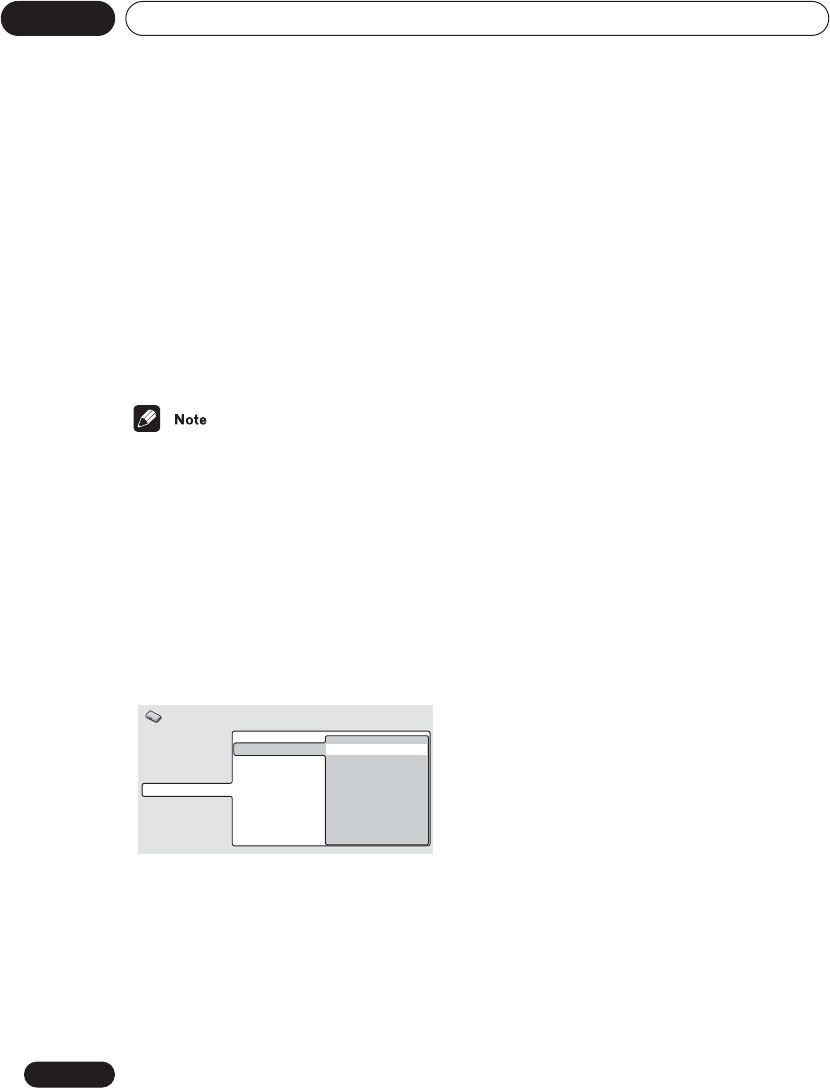
Initial Settings menu11
72
En
Parental Lock
•Default level: Off; Default password: none;
Default Country code: us (2119)
To give you some control over what your
children watch on your DVD player, some DVD-
Video discs feature a Parental Lock level. If
your player is set to a lower level than the disc,
the disc won’t play.
Some discs also support the Country Code
feature. The player does not play certain
scenes on these discs, depending on the
Country Code you set.
• Not all discs use Parental Lock, and will
play without requiring the password first.
• If you forget your password, you’ll need to
reset the player to register a new password.
(see Resetting the system on page 75)
Registering a new password
You must register a password before you can
change the Parental Lock level or enter a
Country code.
1 Select ‘Password’.
2 Use the number buttons to enter a 4-
digit password.
The numbers you enter show up as asterisks
(*) on-screen.
3 Press ENTER to register the password.
You will return to the Options menu screen.
Changing your password
To change your password, confirm your
existing password then enter a new one.
1 Select ‘Password Change’.
2 Use the number buttons to enter your
existing password, then press ENTER.
3Enter a new password and press ENTER.
This registers the new password and you will
return to the Options menu screen.
Setting/changing the Parental Lock
1 Select ‘Level Change’.
2 Use number buttons to enter your
password, then press ENTER.
3 Select a new level and press ENTER.
• Press (cursor left) repeatedly to lock
more levels (more discs will require the
password); press (cursor right) to
unlock levels. You can’t lock level 1.
This sets the new level and you will return to the
Options menu screen.
Setting/changing the Country code
You can find the Country code list on page 89.
1 Select ‘Country Code’.
2 Use number buttons to enter your
password, then press ENTER.
3Select a Country code and press ENTER.
There are two ways you can do this:
•Select by code letter: Use / (cursor up/
down) to change the Country code.
• Select by code number: Press (cursor
right) then use the number buttons to enter
the 4-digit Country code.
The new Country code is set and you will return
to the Options menu screen. Note that the new
Country code doesn’t take effect until the next
disc is loaded (or the current disc is reloaded).
Video Output
Language
Display
Options
Parental Lock
Bonus Group
Auto Disc Menu
Group Playback
DVD Playback Mode
SACD Playback
PhotoViewer
Password
Level Change
Country Code
Initial Settings
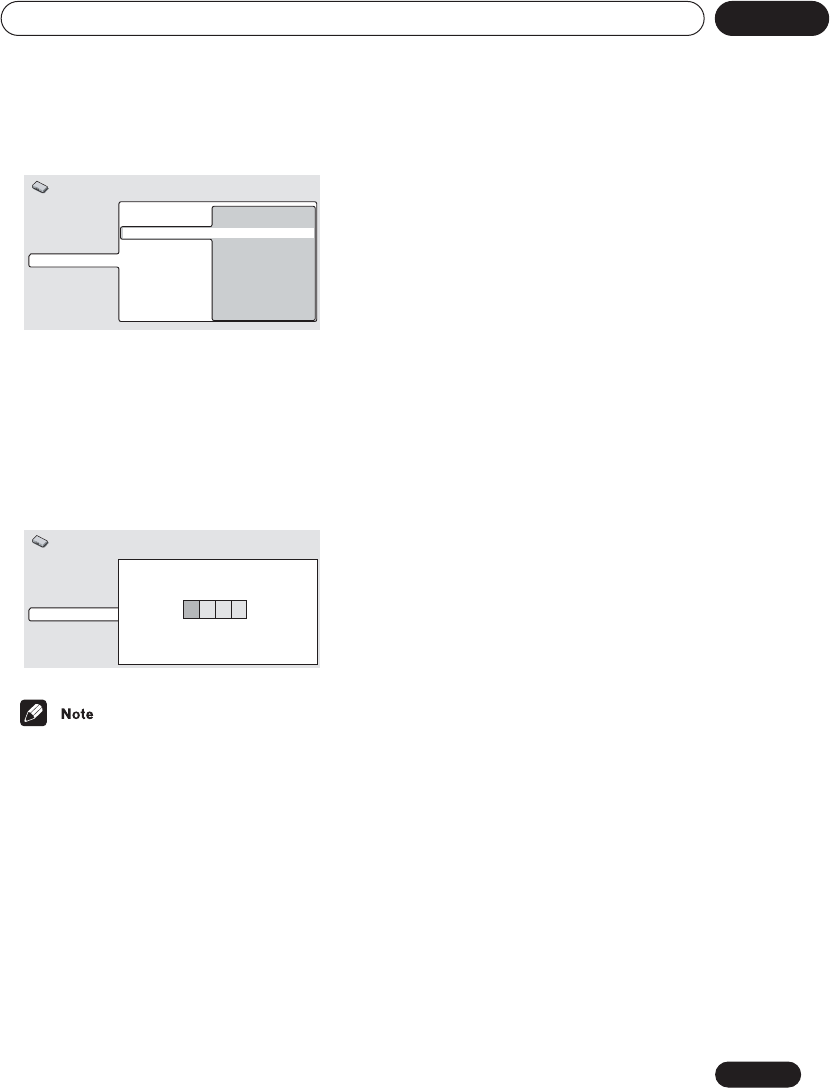
Initial Settings menu 11
73
En
Bonus Group
Some DVD-Audio discs have an extra ‘bonus’
group that requires a 4-digit key number to
access. See the disc packaging for details and
the key number.
When you play a DVD-Audio disc that has a
bonus group, the key number input screen
appears automatically. Select Bonus Group to
access the same screen.
• If you eject the disc, change the input
function, switch the power off, or unplug
the system, you will need to re-enter the key
number.
Video Output
Language
Display
Options
Parental Lock
Bonus Group
Auto Disc Menu
Group Playback
DVD Playback Mode
SACD Playback
PhotoViewer
Initial Settings
Video Output
Language
Display
Options
Bonus Group : Key Number Input
Initial Settings
2***
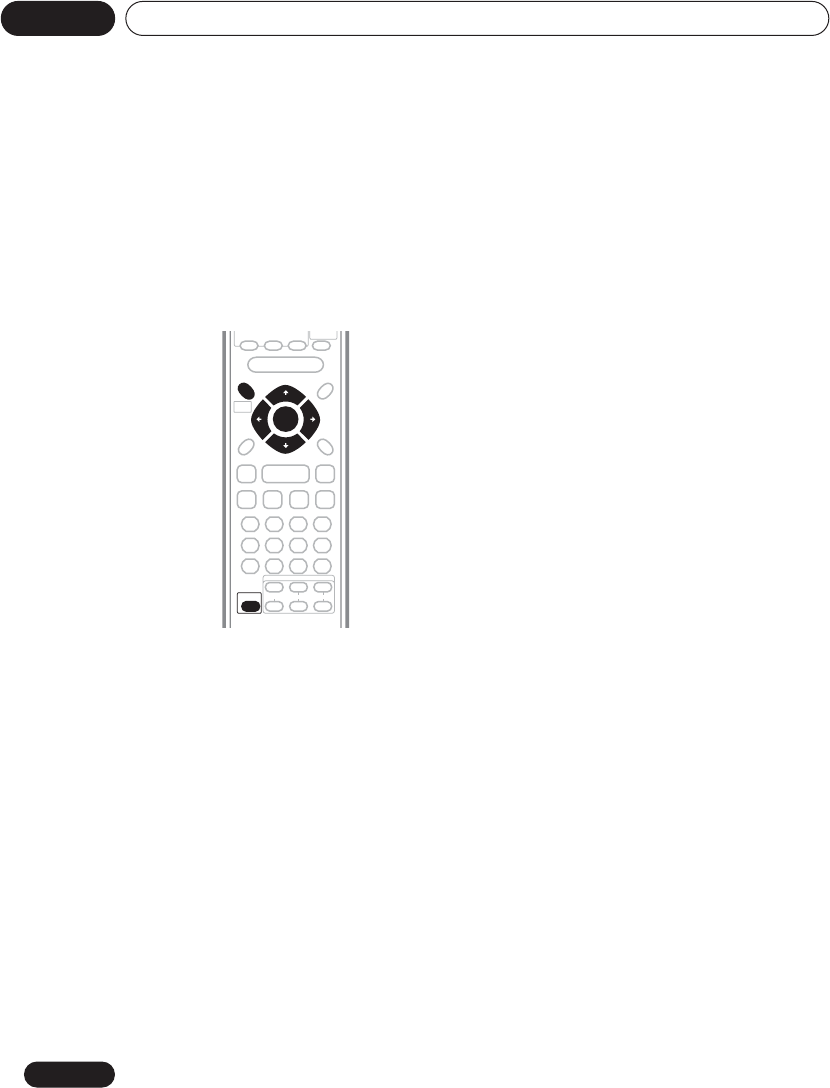
Additional information12
74
En
Chapter 12
Additional information
Optional system settings
These settings are accessed by using the
System Setup menu while in standby.
1 Switch the system into standby.
2Press SYSTEM SETUP (SHIFT + HOME
MENU).
3Use the / (cursor left/right) buttons
to choose the setting you want to adjust
then press ENTER.
The current setting is shown for each option as
you cycle through the display. See below for a
full list and description of each.
4Use the / (cursor up/down) buttons
to adjust the setting.
5 Repeat steps 2 and 3 to make other
settings.
6 Press ENTER to confirm.
System Setup menu options in standby
Below are all the available settings in the setup
menu. The first setting in each section is the
default. See also the notes in each section for
additional information about the settings.
Wireless speaker setting
See Using the wireless speaker system on
page 41.
Child lock setting
The Child Lock feature is useful when you’ve
set the wake-up timer and don’t want the
system switched on before it activates.
•Lock On – Makes the front panel buttons
and controls inoperative.
•Lock Off – Restores regular use of the
front panel buttons and controls.
Clock format setting
Specifies how the clock is displayed:
•12-Hour – Sets the clock to show in 12-
hour format in the display.
•24-Hour – Sets the clock to show in 24-
hour format in the display.
TV attenuator setting
If the source connected to the TV analog input
is producing distortion through the speakers,
the attenuator will reduce the signal level.
•ATT 6dB – Reduces the signal level by 6dB.
•ATT 10dB – Reduces the signal level by
10dB.
•ATT Off – No attenuation
SHIFT
ENTER
SYSTEM SETUP
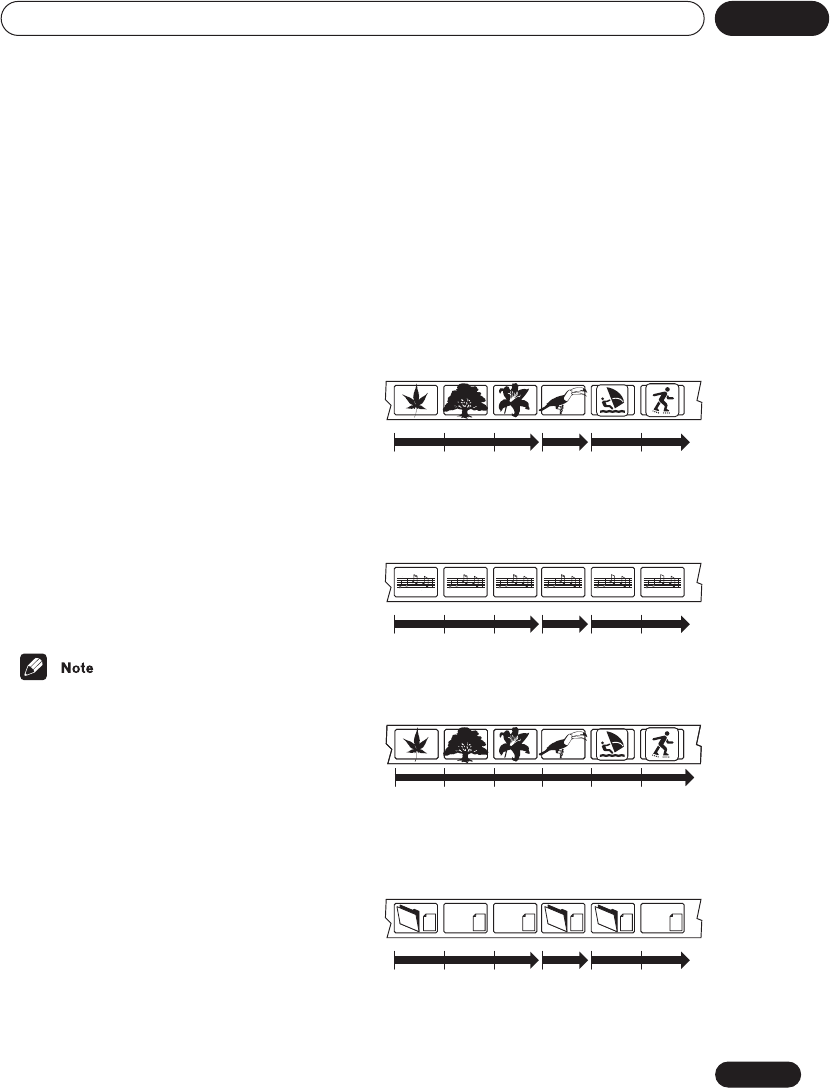
Additional information 12
75
En
Line attenuator setting
If the source connected to the LINE analog
input is distorting, the attenuator can reduce
the signal level.
•ATT 6dB – Reduces the signal level by 6dB.
•ATT 10dB – Reduces the signal level by
10dB.
•ATT Off – No attenuation
Frequency step setting
If you find that you can’t tune into stations
successfully, the frequency step may not be
suitable for your country/region.
• FM 50. AM 9
• FM 100. AM 10
System demo setting
Switches the automatic demo feature on or off
(this starts when the system is plugged in for
the first time):
•Demo On – Switches the demo feature on.
•Demo Off – Switches the demo feature off.
• After setting the clock, the demo mode
switches off automatically. However, if you
unplug the system from the wall outlet, the
demo mode will revert to Demo On (and
the clock will be reset).
Resetting the system
Use this procedure to reset all system settings
to the factory default.
1 Switch the system into standby.
2Press and hold the front panel (stop)
button for about 8 seconds until the
display shows ‘Mem.Clr.?’.
3 Press the front panel button.
All the system’s settings are now reset, and
you should see the ‘Let’s Get Started’ screen.
Using and taking care of discs
Titles, chapters and tracks
DVD-Video discs are generally divided into one
or more titles. Titles may be further subdivided
into chapters.
DVD-Audio discs are divided into one or more
groups that can each contain a number of
tracks.
CDs, SACDs and Video CDs are divided into
tracks.
CD-ROMs contain folders and files. MP3 files
are referred to as tracks. Folders may contain
further folders.
Title 1 Title 2 Title 3
Chapter 1 Chapter 2 Chapter 3 Chapter 1 Chapter 1 Chapter 2
Group 1 Group 2 Group 3
Track 1 Track 2 Track 3 Track 1 Track 1 Track 2
Track 1 Track 2 Track 3 Track 4 Track 5 Track 6
Folder A Folder B Folder C
Track 1 Track 2 Track 3 Track 1 File 1 File 2
.mp3
.mp3
.mp3
.mp3
.jpg
.jpg
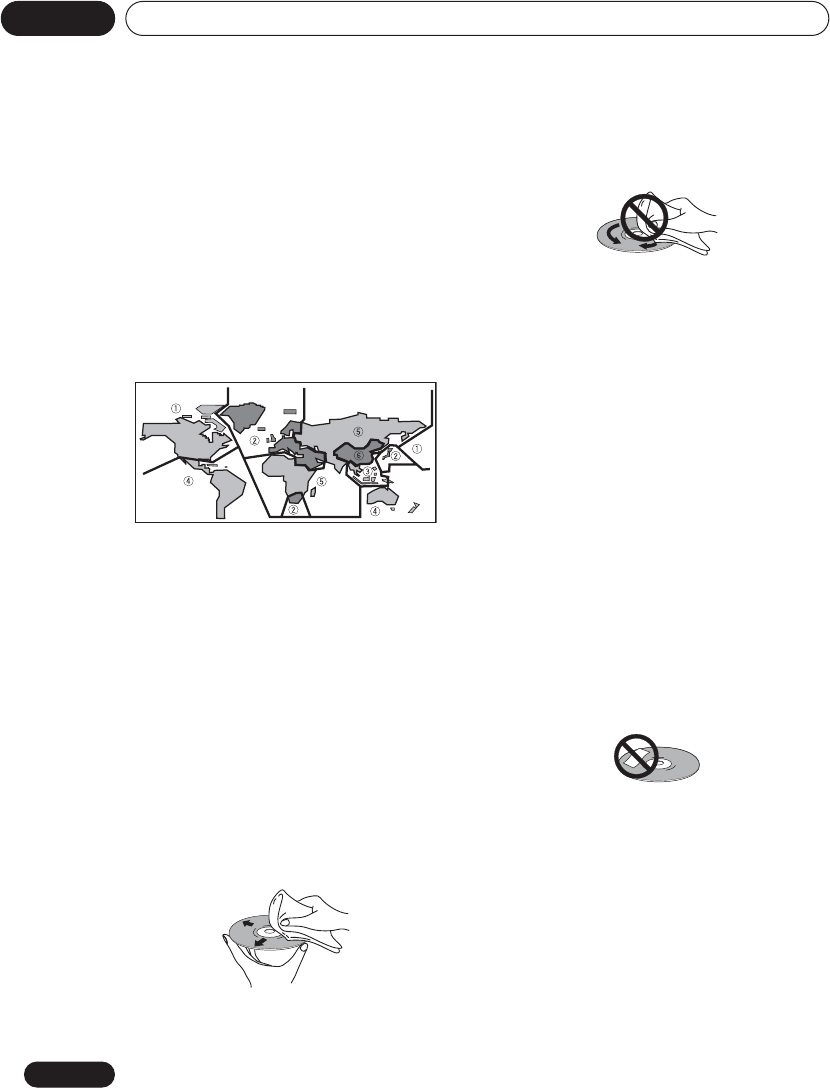
Additional information12
76
En
DVD Video regions
All DVD Video discs carry a region mark on the
case somewhere that indicates which
region(s) of the world the disc is compatible
with. Your DVD system also has a region mark,
which you can find on the rear panel. Discs
from incompatible regions will not play in this
system. Discs marked ALL will play in any
system.
The diagram below shows the various DVD
regions of the world.
Handling discs
When holding discs of any type, take care not
to leave fingerprints, dirt or scratches on the
disc surface. Hold the disc by its edge or by the
center hole and edge.
Damaged or dirty discs can affect playback
performance. Take care also not to scratch the
label side of the disc. Although not as fragile as
the recorded side, scratches can still result in
a disc becoming unusable.
Should a disc become marked with
fingerprints, dust, etc., clean using a soft, dry
cloth, wiping the disc lightly from the center to
the outside edge as shown in the diagram
below.
Wipe lightly from the center of the disc using
straight strokes.
Don’t wipe the disc surface using circular
strokes.
If necessary, use a cloth soaked in alcohol, or a
commercially available CD/DVD cleaning kit to
clean a disc more thoroughly. Never use
benzine, thinner or other cleaning agents,
including products designed for cleaning vinyl
records.
Storing discs
Although CDs and DVD discs are more durable
than vinyl records, you should still take care to
handle and store discs correctly. When you're
not using a disc, return it to its case and store
upright. Avoid leaving discs in excessively cold,
humid, or hot environments (including under
direct sunlight).
Don't glue paper or put stickers onto the disc,
or use a pencil, ball-point pen or other sharp-
tipped writing instrument. These could all
damage the disc.
For more detailed care information see the
instructions that come with discs.
Do not load more than one disc into the player
at a time.

Additional information 12
77
En
Discs to avoid
Discs spin at high speed inside the player. If
you can see that a disc is cracked, chipped,
warped, or otherwise damaged, don't risk
using it—you could end up damaging the
player.
This system is designed for use with
conventional, fully circular discs only. Use of
shaped discs is not recommended for this
product. Pioneer disclaims all liability arising
in connection with the use of shaped discs.
Proper installation and
maintenance of this system
Hints on installation
We want you to enjoy using this system for
years to come, so please bear in mind the
following points when choosing a suitable
location for it:
Do...
Use in a well-ventilated room.
Place on a solid, flat, level surface, such as
a table, shelf or stereo rack.
Don’t...
Use in a place exposed to high
temperatures or humidity, including near
radiators and other heat-generating
appliances.
Place on a window sill or other place where
the system will be exposed to direct
sunlight.
Use in an excessively dusty or damp
environment.
Place directly on top of an amplifier, or
other component in your stereo system
that becomes hot in use.
Use near a television or monitor as you may
experience interference—especially if the
television uses an indoor antenna.
Use in a kitchen or other room where the
system may be exposed to smoke or steam.
Use on a thick rug or carpet, or cover with
cloth—this may prevent proper cooling of
the system unit.
Place on an unstable surface, or one that is
not large enough to support all four of the
system unit’s feet.
Cleaning the pickup lens
The DVD player’s lens should not become dirty
in normal use, but if for some reason it should
malfunction due to dust or dirt, consult your
nearest Pioneer authorized service center.
Although lens cleaners are commercially
available, we do not recommend using them
since some may damage the lens.
Problems with condensation
Condensation may form inside the system unit
if it is brought into a warm room from outside,
or if the temperature of the room rises quickly.
Although the condensation won’t damage the
system, it may temporarily impair its
performance. For this reason you should leave
it to adjust to the warmer temperature for
about an hour before switching on and using.
Moving the system unit
If you need to move the main unit, first remove
all discs, then press STANDBY/ON on the
front panel to turn the system off. Wait for
Good Bye to disappear from the display, then
unplug the power cord. Never lift or move the
system during playback—discs rotate at a high
speed and may be damaged.
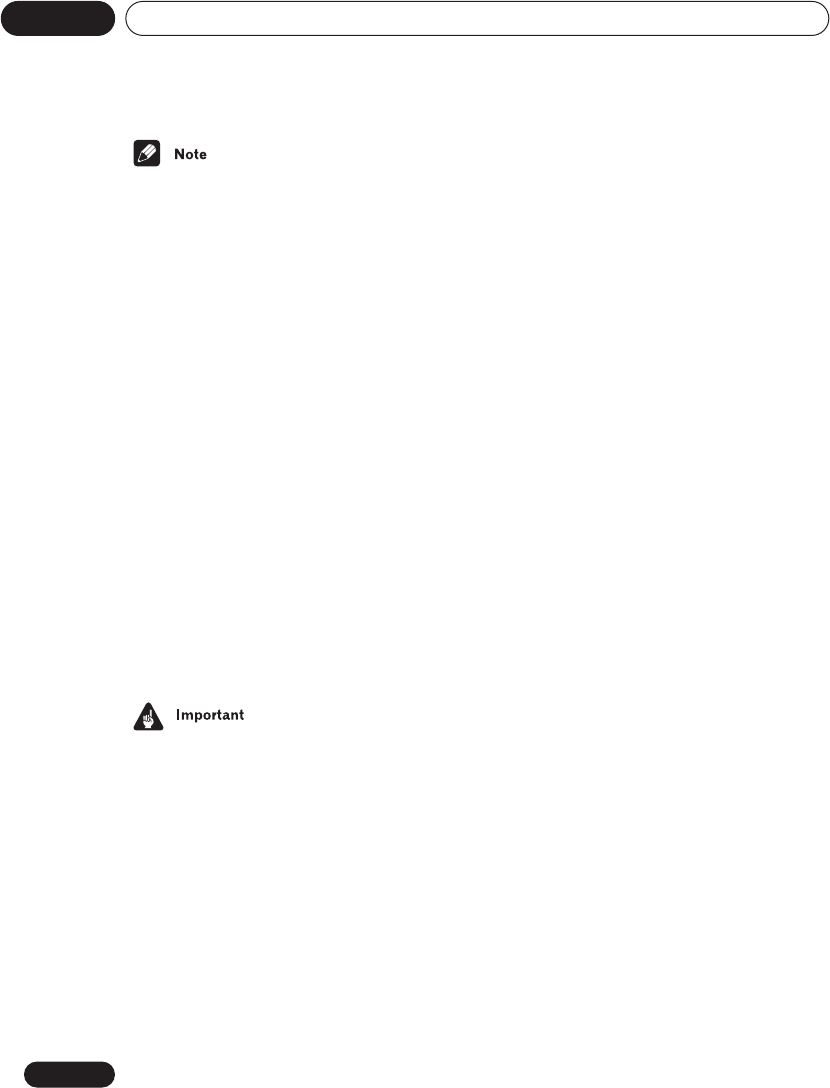
Additional information12
78
En
• Unplugging the system before Good Bye
disappears from the display may cause the
system to return to the factory settings.
Power cord caution
Handle the power cord by the plug part. Do not
pull out the plug by tugging the cord, and never
touch the power cord when your hands are
wet, as this could cause a short circuit or
electric shock. Do not place the system unit, a
piece of furniture, or other object on the power
cord or pinch the cord in any other way. Never
make a knot in the cord or tie it with other
cords. The power cord should be routed so that
they are not likely to be stepped on. A damaged
power cord can cause a fire or give you an
electric shock. Check the power cord once in a
while. If you find it damaged, ask your nearest
Pioneer authorized service center or your
dealer for a replacement.
Wireless speaker system
maintenance and precautions
• Even when not in use, the fan in the
wireless speaker will continue to operate.
Switching off the wireless speaker when
not in use will increase product life.
Cleaning the exterior
Use a polishing cloth or dry cloth to wipe off
dust and dirt. If the surfaces are very dirty, wipe
with a soft cloth dipped in some neutral
cleanser diluted five or six times with water and
wrung out well, then wipe again with a dry
cloth.
Do not use furniture wax or cleaners. Never
use thinners, benzine or insecticide sprays or
other chemicals on or near this unit since they
will corrode the surface.
If you use a chemical-impregnated cleaning
cloth, read the instructions carefully before
use. These cloths may leave smear marks on
half-mirror finish surfaces; if this happens,
finish with a dry cloth.
Make sure to unplug the unit when cleaning.
AC adapter and power cord caution
• Do not leave the power cord near heating
equipment. The coating of the cord may melt,
which could lead to fire and/or electrocution.
• Make sure to grasp the body of the AC
adaptor when removing it from the power
outlet. If you pull the power cord, it may
become damaged which could lead to fire and/
or electrocution.
• Do not attempt to plug in or remove the AC
adaptor with wet hands. This may result in
electrocution.
• Insert the prongs of the AC adaptor all the
way into the power outlet. If the connection is
incomplete, heat may be generated which
could lead to fire. Furthermore, contact with
the connected prongs of the adaptor may
result in electrocution.
• Do not insert the AC adaptor into a power
outlet where the connection remains loose
despite inserting the prongs all the way into the
outlet. Heat may be generated which could
lead to fire. Consult with the retailer or an
electrician regarding replacement of the power
outlet.
Moving the wireless speaker
If you need to move the wireless speaker, first
press POWER on the top panel to turn the unit
off, then unplug the power cord.

Additional information 12
79
En
Radio wave reflections
The radio waves received by the receiver
include the radio wave coming directly from
the transmitter (direct wave) and waves
coming from various directions due to
reflections by walls, furniture and building
(reflected waves). The reflected waves (due to
obstacles and reflecting objects) further
produce a variety of reflected waves as well as
variation in reception condition depending on
locations. If the audio cannot be received
properly due to this phenomenon, try moving
the location of the wireless speaker a little. Also
note that audio may be interrupted due to the
reflected waves when a person crosses or
approaches the space between the transmitter
and wireless speaker.
Radio wave caution
This wireless speaker system uses a 2.4GHz
radio wave frequency, which is a band used by
other wireless systems (see list below). To
prevent noise or interrupted communication,
do not use this system nearby such devices, or
make sure these devices are switched off
during use. You can also try switching the
channel on the transmitter (see Transmitter on
page 16) for better reception.
• Cordless phones
• Wireless broadband routers
• Wireless AV equipment
• Microwave-based health aids
• Microwave ovens
• Wireless controllers for game systems
• Bluetooth equipment
• Some baby monitors
Other, less common, equipment that may
operate on the same frequency:
• Anti-theft systems
• Warehouse logistic management systems
• Amateur radio stations (HAM)
• Discrimination systems for train or
emergency vehicles
• If there is something obstructing the path
between the transmitter and the wireless
speaker (such as a metal door, concrete
wall, or insulation containing tinfoil), you
may need to change the location of your
system to prevent signal noise and
interruptions.
• If the transmitter is used near A/V
equipment with an antenna input terminal,
such as a TV, VCR, BS tuner or CS tuner,
you may experience noise interference on a
TV near the transmitter. In such cases,
place the transmitter at a larger distance
from the antenna input terminal of the A/V
equipment.
Scope of operation
Use of this equipment is limited to home use.
(Transmission distances may be reduced
depending on communication environments.)
In the following locations, poor condition or
inability to receive radio waves may cause the
audio to be interrupted or stopped:
•In reinforced concrete buildings or homes
made of metallic structural members.
• Near large metallic furniture.
• In a crowd of people or near a building or
obstacle.
•If you live in a heavily populated residential
area (apartment, townhouse, etc.) and if
your neighbor's microwave is placed near
your system, you may experience radio
wave interference or no sound from the
speaker. If this occurs, move your unit to a
different place. When the microwave is not
in use, there will be no radio wave
interference.
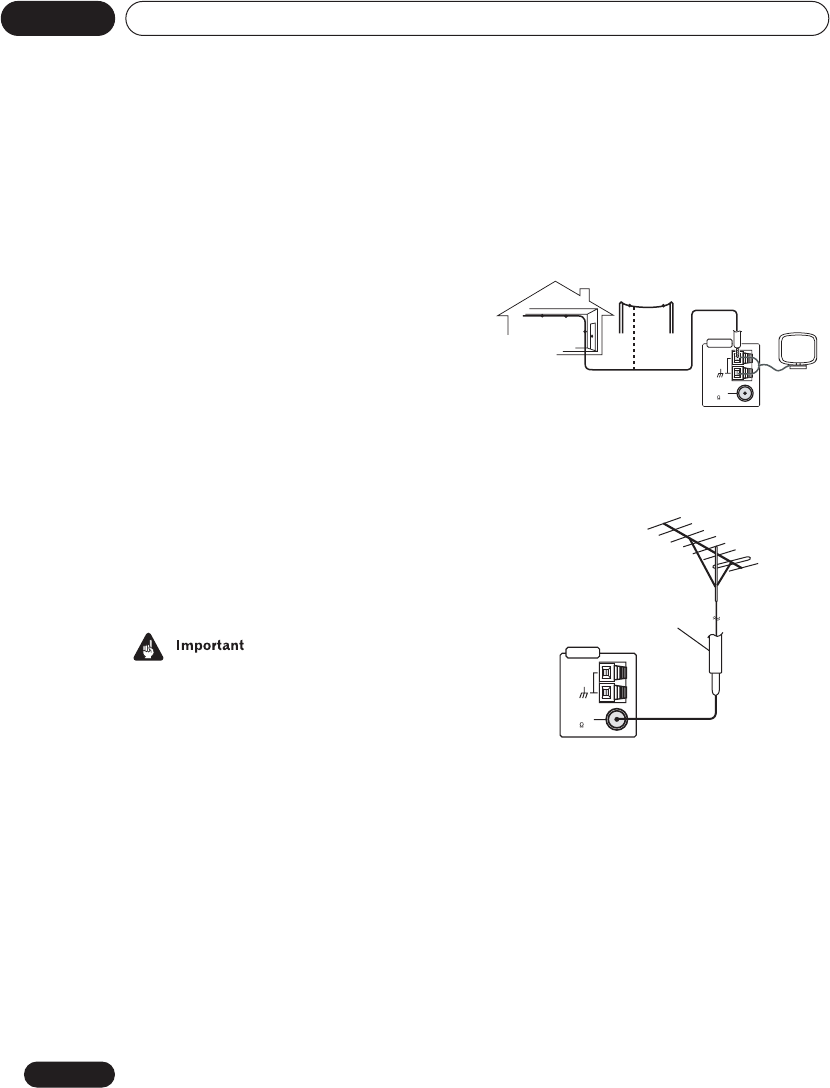
Additional information12
80
En
For safety in operation
Do not use the system in the proximity of
electronic equipment that requires high-
accuracy control or handling of very low-level
signals, such as:
• Hearing aids, cardiac pacemakers, other
electrical medical equipment, fire alarms,
automatic doors, and other automated
control equipment.
The system may affect the electronic
equipment, causing malfunction or accident.
• If you use a pacemaker or other electrical
medical equipment, consult the
manufacturer or dealer to check the effects
of radio waves on it.
Do not use the system in places where its use
is prohibited, for example near aircraft
equipment and in hospitals.
The system may affect electronic equipment or
electrical medical equipment, causing an
accident. Follow the instructions given by the
aircraft company or medical institution.
• We do not assume any liability for the
damages incurred due to improper use of
the product by the user or third party,
malfunction during use, other troubles or
use of the product, unless indemnity for
damages is admitted by the law.
Static electricity
Static electricity or other external influence
may cause malfunctioning of this unit. In this
case, unplugging the power cord and then re-
plugging it in will usually reset the unit for
proper operation. If this does not correct the
problem, please consult your nearest Pioneer
service center.
Connecting external antennas
External AM antenna
Use 5–6 meters (15–18 feet) of vinyl-insulated
wire and set up either indoors or outdoors.
Leave the AM loop antenna connected.
External FM antenna
Use 75Ω coaxial cable to hook up an external
FM antenna.
ANT ENNA
AM LOOP
ANT ENNA
FM
UNBAL
75
Outdoor antenna
15–18 ft. / 5–6m
Indoor
antenna
(vinyl-coated
wire)
ANTENNA
AM LOOP
ANTENNA
FM
UNBAL
75
75Ω coaxial cable

Additional information 12
81
En
Connecting auxiliary components
This system has both stereo analog inputs and
outputs, as well as a coaxial digital input. Use
these to connect external components, such
as your VCR, MD or CD-R recorder.
•Connect the LINE 1 (IN) jacks to the
analog outputs of an external playback
component.
These include components such as a VCR or
cassette deck. Connect using RCA pin-plug
stereo cables.
•Connect the LINE 1 (OUT) jacks to the
analog inputs of an external recording
component.
These include components such as a cassette
deck, VCR, MD or another recorder with analog
inputs. Connect using RCA pin-plug stereo
cables.
•Connect the COAX IN (LINE 2) jack on
the rear panel to the coaxial digital output
of an external playback component.
These include digital components such as an
MD player, digital satellite, or a game system.
Connect using a coaxial digital cable (not
supplied).
• If you find that the LINE 1 audio is
distorting when played through this
system, you can set the input attenuator to
reduce the input signal level. See Optional
system settings on page 74 to do this.
Recording mode
The Recording mode allows you to make
surround-compatible analog recordings from
the LINE 1 (OUT) jacks. Dolby multichannel
sources will be downmixed to stereo for
improved playback with systems that can
provide matrix-decoding (like Dolby Pro Logic).
1Press SOUND MODE.
2Use the Use the / (cursor left/right)
buttons to select ‘Rec Mode?’.
3Press ENTER.
4Use the / (cursor up/down) buttons
to select ‘R.Mode On’ or ‘R.Mode Off’.
•R.Mode On – A surround-compatible
downmix (left-total/right-total, or Lt/Rt) of
Dolby multichannel sources is output,
(suitable for Dolby Surround Pro Logic or
other matrix decoding).
•R.Mode Off – A simple stereo downmix
(left-only/right-only, or Lo/Ro) is output
(suitable for playback on a two-channel
stereo system or on headphones).
AUDIO
ANT ENNA
AM LOOP
ANT ENNA
FM
UNBAL
75
LINE 1
LINE 2
TV
OUT IN IN
L
R
L
R
COAXIAL IN
Tape deck, etc.
AUDIO
OUTPUT
AUDIO
INPUT
COAXIAL IN
LINE 2

Additional information12
82
En
• When Recording mode is on, most
surround sound-related functions cannot
be used. The display will briefly blink
RecMode On if you try and use a
prohibited function while Recording mode
is on.
• When Recording mode is off, the audio
from the analog output may be interrupted,
depending on the operation.
• The Recording mode automatically
switches off if you change the input
function (DVD/CD, TUNER, etc.) or switch
the power off.
• When Recording mode is on, a stereo
downmix of multichannel DVD-Audio and
SACD sources is output from both the
speakers and the analog audio jacks.
However, note that with some
multichannel DVD-Audio sources, only the
front right and left channels are output
from the analog jacks. When switched off.
the multichannel source is played through
the speakers, but only the front right and
left channels are output from the analog
audio jacks.
•When Recording mode is on, you won’t be
able to hear the subwoofer channel with
SACD sources.

Additional information 12
83
En
Troubleshooting
Incorrect operations are often mistaken for trouble and malfunctions. If you think that there is
something wrong with this component, check the points below. Sometimes the trouble may lie in
another component. Investigate the other components and electrical appliances being used. If the
trouble cannot be rectified even after exercising the checks listed below, ask your nearest Pioneer
authorized service center or your dealer to carry out repair work.
• If the system is not operating normally due to external effects such as static electricity,
disconnect the power plug from the outlet and insert again to resume normal operation.
• If you are experiencing problems with the wireless speaker system, make sure to bring both
the transmitter and wireless speaker in for repair so that they can be tested properly.
General
Problem Remedy
The power does not turn
on. • Connect the power plug to the wall outlet.
• Disconnect the power plug from the outlet, and insert again.
• Make sure there are no loose strands of speaker wire touching the rear
panel. This could cause the system to shut off automatically.
No sound is output when
a function is selected. • If you’re using the line input, make sure the component is connected
correctly (see Connecting auxiliary components on page 81).
• Press MUTE on the remote control to turn muting off.
• Adjust the VOLUME.
No image is output when
playing discs. • Make sure the TV is connected correctly (see Connecting to your TV on
page 16).
• Reset the video output to interlace (see Watching progressive scan video
from the component video outputs on page 17).
No sound from surround
or center speakers. • Refer to Setting the channel levels on page 66 to check speaker levels.
• Check that you haven’t selected the STEREO sound mode (see Listening
in stereo on page 46).
• Make sure the speakers are connected properly (see Connecting the
speakers and wireless speaker system on page 11).
Can’t operate the remote
control. • Replace the batteries (see Putting the batteries in the remote control on
page 9).
• Operate within 23 ft. / 7 m, 30° of the remote sensor on the front panel
(see Using the remote control on page 9).
• Remove any obstacles or operate from another position.
• Avoid exposing the remote sensor on the front panel to direct light.
• You won’t be able to use the remote sensor of this unit with the
CONTROL IN jack of this unit connected to the CONTROL OUT jack of
your plasma display. You can use the remote sensor of the plasma display
(even in standby) as long as the power isn’t switched off.

Additional information12
84
En
DVD/CD/Video CD player
Sound Demo shows in
the display and the unit
can’t be controlled.
• Press and hold (stop) on the front panel for about five seconds. The
disc tray ejects automatically to indicate the Sound Demo mode is
disabled.
Timer indicator is
blinking and the system
will not switch on.
• Unplug the system, then plug back in. Wait for one minute then switch
on.
• Make sure the fan at the rear of the system unit is not being blocked.
• Check that the speakers are connected correctly.
• Make sure the voltage of the mains power source is correct for the
model.
• If the problem persists, take it to your nearest Pioneer
authorized service center or your dealer for servicing.
Problem Remedy
Problem Remedy
The disc is ejected
automatically after
loading.
• Clean the disc.
• Align the disc properly in the disc guide.
• If the region number on a DVD-video disc does not match the number on
the system unit, the disc cannot be used (see DVD Video regions on
page 76).
• The system Parental Lock level is set to a level lower than the disc you
are trying to play. See Parental Lock on page 72 to change it.
• Allow time for any condensation inside the system unit to evaporate.
Avoid using the system near an air-conditioning unit.
Playback is not possible. • If the disc is loaded upside down, reload the disc with the label side face
up.
Picture playback stops
and the operation
buttons cannot be used.
• Press (stop), then (play) to start playback again.
• Switch the power off once, then on again using the front panel
STANDBY/ON button.
Settings are canceled. • When the power is cut due to power failure or by unplugging the power
cord, settings will be canceled.
No picture/No color. • Check that connections are correct and that plugs are inserted fully.
• Check the instruction manual of the TV/monitor to make sure the TV/
monitor settings are incorrect.
Screen is stretched or
aspect does not change. • The TV Screen setting is incorrect. Set the TV Screen option to match the
TV/monitor you're using (see Video Output settings on page 69).
CD won’t play. • Set the PhotoViewer menu option in the Initial Settings menu to Off to
be able to play some copy-protected CDs. See Options on page 71.

Additional information 12
85
En
MP3/JPEG discs
Tuner
When recorded on a VCR
or passed through an AV
selector, there is
disturbance in the
playback picture.
• This system uses copy-protection technology which may prevent
recording or cause picture problems when connected through a VCR or AV
selector. This is not a malfunction.
Picture disturbance
during playback or dark. • This system is compatible with Macro-Vision System copy guard. Some
discs include a copy prevention signal, and when this type of disc is played
back, stripes etc., may appear on some sections of the picture depending
on the TV. This is not a malfunction.
• Discs respond differently to particular system functions. This may result
in the screen becoming black for a brief instant or shaking slightly when
the function is executed. These problems are largely due to differences
between discs and disc content and are not malfunctions of this system.
DVD-Audio
playback
stops
.
• The disc may have been illegally copied.
Noticeable difference in
DVD and CD volume. • DVDs and CDs use different recording methods. This is not a
malfunction.
Problem Remedy
Problem Remedy
CD-ROM disc is not
recognized by the system. • Make sure that the CD-ROM was recorded using the ISO 9660 disc
format. See Disc / content format playback compatibility on page 9 for other
disc compatibility information.
Files don’t show up in the
Disc Navigator/Photo
Browser.
• The files on the disc must be named with the correct file extension: .mp3
for MP3 files; .jpg for JPEG files (upper or lower-case is OK). See Disc /
content format playback compatibility on page 9 for other disc compatibility
information.
Can play JPEG files, but
not MP3 files on the
same disc (or vice versa).
• Set the PhotoViewer menu option in the Initial Settings menu to Off to
be able to access the MP3 files. Set to On to be able to play the JPEG files.
See Options on page 71.
Problem Remedy
Auto tuning does not pick
up some stations. • The radio signal is weak. Auto tuning will only detect radio stations with a
good signal. For more sensitive tuning, connect an outdoor antenna.
Sound is mono only. • The tuner may be set to FM mono (see Improving poor FM reception on
page 39).

Additional information12
86
En
Wireless speaker system
Considerable noise in
radio broadcasts. • Tune into the correct frequency.
• Connect the antenna (see Connecting the supplied antennas on page 20
and Connecting external antennas on page 80).
• Fully extend the FM wire antenna, position for best reception, and secure
to a wall.
• Connect an outdoor FM antenna (see Connecting external antennas on
page 80).
• Adjust the direction and position for best reception.
• Connect an additional internal or external AM antenna (see AM loop
antenna on page 20 and Connecting external antennas on page 80).
• Turn off any other equipment that may be causing the noise or move it
away from the system unit.
• The tuning interval is incorrect for your country or region. Try switching
the tuning interval (frequency step) (see Frequency step setting on
page 75).
Problem Remedy
Problem Remedy
Audio cannot be received. • The radio wave reception is variable depending on locations due to
the effects of obstacles and reflecting objects. Try changing the
location of the wireless speaker system a little.
• The transmitter and wireless speaker are designed and sold as a pair,
and they identify each other in communication. This means that
communication is not available between a separately purchased
transmitter and wireless speaker.
Audio is interrupted. • This system uses high frequency radio waves that have properties
similar to light, such as linearity, reflection, refraction, diffraction, and
interference. Therefore, placement of the system can result in weak
radio waves and/or interruption.
• The distance between the transmitter and wireless speaker may be
too large. Use the wireless speaker within the reach of the radio waves
(within 10m) from the transmitter.
• The system is being used in a location with radio wave interference or
electrical noise. If so, the unit may need to be relocated.
Audio is suddenly
interrupted. • There may be radio communication equipment using the same
frequency band (2.4 GHz) as this system, such as a Bluetooth device,
radio LAN device or microwave oven, operating nearby.
No sound from the wireless
speaker. • If you selected W.Stereo, the volume on the wireless speaker may be
turned down too low.

Additional information 12
87
En
Error Messages
Horizontal stripe noise
interference on a TV set near
the transmitter.
• If there a piece of A/V equipment with an antenna near the
transmitter, move the transmitter away from the antenna input terminal
of the AV equipment.
When the system is switched
on, or during operation:
HTD-645DV – The
POWER
indicator goes out.
HTD-641DV – The POWER
button pops up.
• It is likely that the system is malfunctioning. Ask your nearest Pioneer
authorized service center or your dealer to carry out repair work.
Problem Remedy
Message Description
Child Lock • This message appears when the front panel buttons are pressed when
the child lock feature is active. See Child lock setting on page 74 for more
on switching on/off the child lock.
Rec Mode On • Blinks rapidly for 2 seconds when an operation is prohibited because
the Recording Mode is on (see Recording mode on page 81).
Phones In • Blinks rapidly for 2 seconds when an operation is prohibited because
headphones are connected.
DVD-AUDIO • Blinks rapidly for 2 seconds when an operation is prohibited because
the source is DVD-Audio.
SACD • Blinks rapidly for 2 seconds when an operation is prohibited because
the source is a Super Audio CD.
96k Stereo • Blinks rapidly for 2 seconds when an operation is prohibited because
the source is digital 88.2 or 96kHz PCM.
No Surr. SP • Blinks rapidly for 2 seconds when an operation is prohibited because
there is no surround speaker output.
Normal / Wide / Left Side/
Right Side / W. Stereo • Blinks rapidly for 2 seconds when an operation is prohibited due to the
wireless speaker setting.
Muting • Blinks rapidly for 2 seconds when an operation is prohibited because
the sound is muted (press the MUTE button to turn the sound on).
Exit • Appears briefly when a menu is automatically exited after a set period of
inactivity.
SR+ Error • Appears when there is a communication problem between the unit and
the plasma display. Check all connections and retry.
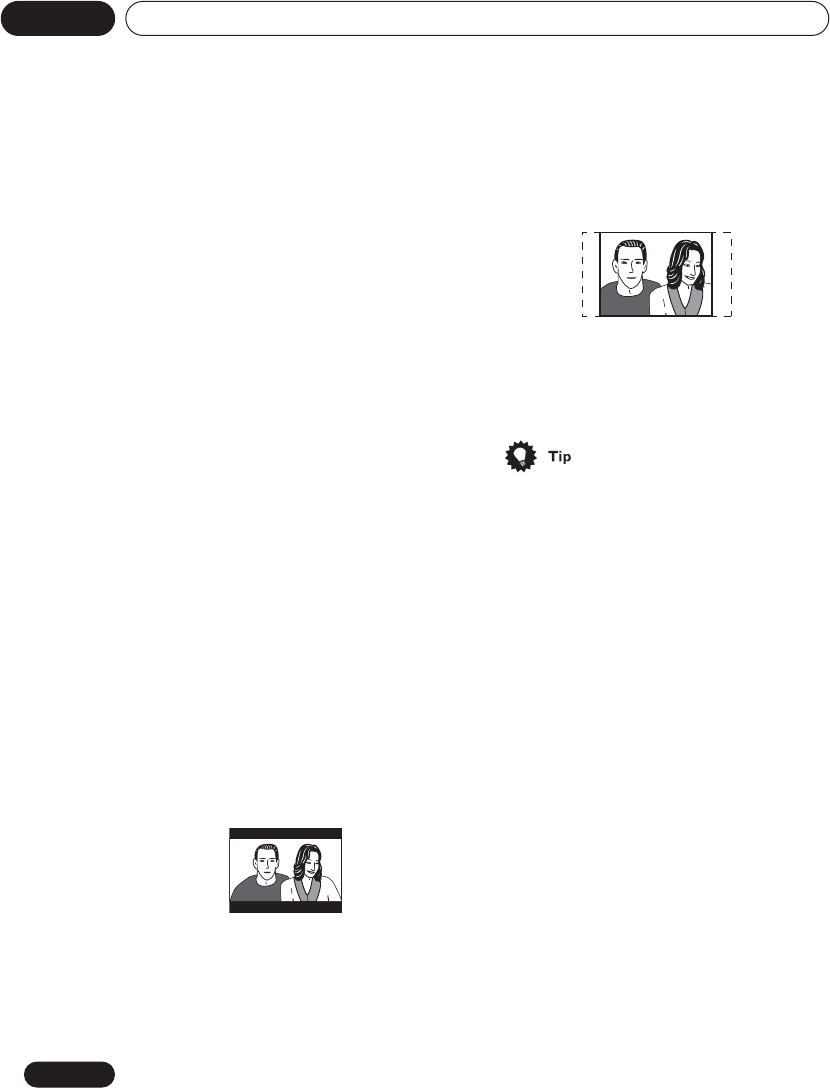
Additional information12
88
En
Screen sizes and disc formats
DVD-Video discs come in several different
screen aspects, ranging from TV programs,
which are generally 4:3, to CinemaScope
widescreen movies, with an aspect ratio of up
to about 7:3.
Televisions also come in different aspect
ratios; ‘standard’ 4:3 and widescreen 16:9.
Widescreen TV users
If you have a widescreen TV, the TV Screen
setting (page 69) of this system should be set
to 16:9 (Wide).
When you watch discs recorded in 4:3 format,
you can use the TV controls to select how the
picture is presented. Your TV may offer various
zoom and stretch options; see the instructions
that came with your TV for details.
Please note that some movie aspect ratios are
wider than 16:9, so even though you have a
widescreen TV, these discs will still play in a
‘letterbox’ style with black bars at the top and
bottom of the screen.
Standard TV users
If you have a standard TV, the TV Screen setting
(page 69) of this system should be set to 4:3
(Letter Box) or 4:3 (Pan&Scan), depending on
which you prefer.
Set to 4:3 (Letter Box), widescreen discs are
shown with black bars top and bottom.
Set to 4:3 (Pan&Scan), widescreen discs are
shown with the left and right sides cropped.
Although the picture looks larger, you don’t
actually see the whole picture.
Please note that many widescreen discs
override the system’s settings so that the disc
is shown in letterbox format regardless of the
setting.
• Using the 16:9 (Wide) setting with a
standard 4:3 TV, or either of the 4:3 settings
with a widescreen TV, will result in a
distorted picture.
Selecting languages using the
language code list
Some of the language options allow you to set
your preferred language from any of the 136
languages listed in the Language code list on
page 89.
1 Select ‘Other Language’.
2Use the / (cursor left/right) buttons
to select either a code letter or a code
number.
3Use the / (cursor up/down) buttons
to select a code letter or a code number.
See Language code list on page 89 for a
complete list of languages and codes.

Additional information 12
89
En
Language code list
Language (Language code letter), Language code
Country code list
Country, Country code, Country code letter
Japanese (ja), 1001
English (en), 0514
French (fr), 0618
German (de), 0405
Italian (it), 0920
Spanish (es), 0519
Dutch (nl), 1412
Russian (ru), 1821
Chinese (zh), 2608
Korean (ko), 1115
Greek (el), 0512
Afar (aa), 0101
Abkhazian (ab), 0102
Afrikaans (af), 0106
Amharic (am), 0113
Arabic (ar), 0118
Assamese (as), 0119
Aymara (ay), 0125
Azerbaijani (az), 0126
Bashkir (ba), 0201
Byelorussian (be), 0205
Bulgarian (bg), 0207
Bihari (bh), 0208
Bislama (bi), 0209
Bengali (bn), 0214
Tibetan (bo), 0215
Breton (br), 0218
Catalan (ca), 0301
Corsican (co), 0315
Czech (cs), 0319
Welsh (cy), 0325
Danish (da), 0401
Bhutani (dz), 0426
Esperanto (eo), 0515
Estonian (et), 0520
Basque (eu), 0521
Persian (fa), 0601
Finnish (fi), 0609
Fiji (fj), 0610
Faroese (fo), 0615
Frisian (fy), 0625
Irish (ga), 0701
Scots-Gaelic (gd), 0704
Galician (gl), 0712
Guarani (gn), 0714
Gujarati (gu), 0721
Hausa (ha), 0801
Hindi (hi), 0809
Croatian (hr), 0818
Hungarian (hu), 0821
Armenian (hy), 0825
Interlingua (ia), 0901
Interlingue (ie), 0905
Inupiak (ik), 0911
Indonesian (in), 0914
Icelandic (is), 0919
Hebrew (iw), 0923
Yiddish (ji), 1009
Javanese (jw), 1023
Georgian (ka), 1101
Kazakh (kk), 1111
Greenlandic (kl), 1112
Cambodian (km), 1113
Kannada (kn), 1114
Kashmiri (ks), 1119
Kurdish (ku), 1121
Kirghiz (ky), 1125
Latin (la), 1201
Lingala (ln), 1214
Laothian (lo), 1215
Lithuanian (lt), 1220
Latvian (lv), 1222
Malagasy (mg), 1307
Maori (mi), 1309
Macedonian (mk), 1311
Malayalam (ml), 1312
Mongolian (mn), 1314
Moldavian (mo), 1315
Marathi (mr), 1318
Malay (ms), 1319
Maltese (mt), 1320
Burmese (my), 1325
Nauru (na), 1401
Nepali (ne), 1405
Norwegian (no), 1415
Occitan (oc), 1503
Oromo (om), 1513
Oriya (or), 1518
Panjabi (pa), 1601
Polish (pl), 1612
Pashto, Pushto (ps), 1619
Portuguese (pt), 1620
Quechua (qu), 1721
Rhaeto-Romance (rm), 1813
Kirundi (rn), 1814
Romanian (ro), 1815
Kinyarwanda (rw), 1823
Sanskrit (sa), 1901
Sindhi (sd), 1904
Sangho (sg), 1907
Serbo-Croatian (sh), 1908
Sinhalese (si), 1909
Slovak (sk), 1911
Slovenian (sl), 1912
Samoan (sm), 1913
Shona (sn), 1914
Somali (so), 1915
Albanian (sq), 1917
Serbian (sr), 1918
Siswati (ss), 1919
Sesotho (st), 1920
Sundanese (su), 1921
Swedish (sv), 1922
Swahili (sw), 1923
Tamil (ta), 2001
Telugu (te), 2005
Tajik (tg), 2007
Thai (th), 2008
Tigrinya (ti), 2009
Turkmen (tk), 2011
Tagalog (tl), 2012
Setswana (tn), 2014
Tonga (to), 2015
Turkish (tr), 2018
Tsonga (ts), 2019
Tatar (tt), 2020
Twi (tw), 2023
Ukrainian (uk), 2111
Urdu (ur), 2118
Uzbek (uz), 2126
Vietnamese (vi), 2209
Volapük (vo), 2215
Wolof (wo), 2315
Xhosa (xh), 2408
Yoruba (yo), 2515
Zulu (zu), 2621
Argentina, 0118, ar
Australia, 0121, au
Austria, 0120, at
Belgium, 0205, be
Brazil, 0218, br
Canada, 0301, ca
Chile, 0312, cl
China, 0314, cn
Denmark, 0411, dk
Finland, 0609, fi
France, 0618, fr
Germany, 0405, de
Hong Kong, 0811, hk
India, 0914, in
Indonesia, 0904, id
Italy, 0920, it
Japan, 1016, jp
Korea, Republic of, 1118, kr
Malaysia, 1325, my
Mexico, 1324, mx
Netherlands, 1412, nl
New Zealand, 1426, nz
Norway, 1415, no
Pakistan, 1611, pk
Philippines, 1608, ph
Portugal, 1620, pt
Russian Federation, 1821, ru
Singapore, 1907, sg
Spain, 0519, es
Switzerland, 0308, ch
Sweden, 1905, se
Taiwan, 2023, tw
Thailand, 2008, th
United Kingdom, 0702, gb
United States of America, 2119, us

Additional information12
90
En
Preset code list
Please note that there are cases where only certain functions may be controllable after assigning
the proper preset code, or the codes for the manufacturer in the list will not work for the model
that you are using.
ACURA 644
ADMIRAL 631
AIWA 660
AKAI 632, 635, 642
AKURA 641
ALBA 607, 639, 641, 644
AMSTRAD 642, 644, 647
ANITECH 644
ASA 645
ASUKA 641
AUDIOGONIC 607, 636
BASIC LINE 641, 644
BAUR 631, 607, 642
BEKO 638
BEON 607
BLAUPUNKT 631
BLUE SKY 641
BLUE STAR 618
BPL 618
BRANDT 636
BTC 641
BUSH 607, 641, 642, 644, 647,
656
CASCADE 644
CATHAY 607
CENTURION 607
CGB 642
CIMLINE 644
CLARIVOX 607
CLATRONIC 638
CONDOR 638
CONTEC 644
CROSLEY 632
CROWN 638, 644
CRYSTAL 642
CYBERTRON 641
DAEWOO 607, 644, 656
DAINICHI 641
DANSAI 607
DAYTON 644
DECCA 607, 648
DIXI 607, 644
DUMONT 653
ELIN 607
ELITE 641
ELTA 644
EMERSON 642
ERRES 607
FERGUSON 607, 636, 651
FINLANDIA 635, 643, 655
FINLUX 632, 607, 645, 648,
653, 654, 655
FIRSTLINE 640, 644
FISHER 632, 635, 638, 645
FORMENTI 632, 607, 642
FRONTECH 631, 642, 646
FRONTECH/PROTECH 632
FUJITSU 648, 629
FUNAI 640, 646, 658
GBC 632, 642
GE 601, 608, 607, 610, 617, 602,
628, 618
GEC 607, 634, 648
GELOSO 632, 644
GENEXXA 631, 641
GOLDSTAR 610, 623, 621, 602,
607, 650
GOODMANS 607, 639, 647, 648,
656
GORENJE 638
GPM 641
GRAETZ 631, 642
GRANADA 607, 635, 642, 643,
648
GRADIENTE 630, 657
GRANDIN 618
GRUNDIG 631, 653
HANSEATIC 607, 642
HCM 618, 644
HINARI 607, 641, 644
HISAWA 618
HITACHI 631, 633, 634, 636, 642,
643, 654, 606, 610, 624, 625, 618
HUANYU 656
HYPSON 607, 618, 646
ICE 646, 647
IMPERIAL 638, 642
INDIANA 607
INGELEN 631
INTERFUNK 631, 632, 607, 642
INTERVISION 646, 649
ISUKAI 641
ITC 642
ITT 631, 632, 642
JEC 605
JVC 613, 623
KAISUI 618, 641, 644
KAPSCH 631
KENDO 642
KENNEDY 632, 642
KORPEL 607
KOYODA 644
LEYCO 607, 640, 646, 648
LIESENK&TTER 607
LOEWE 607
LUXOR 632, 642, 643
M-ELECTRONIC 631, 644, 645,
654, 655, 656, 607, 636, 651
MAGNADYNE 632, 649
MAGNAFON 649
MAGNAVOX 607, 610, 603, 612,
629
MANESTH 639, 646
MARANTZ 607
MARK 607
MATSUI 607, 639, 640, 642, 644,
647, 648
MEDIATOR 607
MEMOREX 644
METZ 631
MINERVA 631, 653
MITSUBISHI 609, 610, 602, 621,
631
MULTITECH 644, 649
NEC 659
NECKERMANN 631, 607
NEI 607, 642
NIKKAI 605, 607, 641, 646, 648
NOBLIKO 649
NOKIA 632, 642, 652
NORDMENDE 632, 636, 651,
652
OCEANIC 631, 632, 642
ORION 632, 607, 639, 640
OSAKI 641, 646, 648
OSO 641
OSUME 648
OTTO VERSAND 631, 632, 607,
642
PALLADIUM 638
PANAMA 646
PANASONIC 631, 607, 608,642,
622
PATHO CINEMA 642
PAUSA 644
PHILCO 632, 642
PHILIPS 631, 607, 634, 656
PHOENIX 632
PHONOLA 607
PROFEX 642, 644
PROTECH 607, 642, 644, 646,
649
QUELLE 631, 632, 607, 642, 645,
653
R-LINE 607
RADIOLA 607
RADIOSHACK 610, 623, 621,
602
RBM 653
RCA 601, 610, 615, 616, 617, 618,
661, 662, 609
REDIFFUSION 632, 642
REX 631, 646
ROADSTAR 641, 644, 646
SABA 631, 636, 642, 651
SAISHO 639, 644, 646
SALORA 631, 632, 642, 643
SAMBERS 649
SAMSUNG 607, 638, 644, 646
SANYO 635, 645, 648, 621, 614
SBR 607, 634
SCHAUB LORENZ 642
SCHNEIDER 607, 641, 647
SEG 642, 646
MCMICHAEL 634
SEI 632, 640, 649
SELECO 631, 642
SHARP 602, 619, 627
SIAREM 632, 649
SIEMENS 631
SINUDYNE 632, 639, 640, 649
SKANTIC 643
SOLAVOX 631
SONOKO 607, 644
SONOLOR 631, 635
SONTEC 607
SONY 604
SOUNDWAVE 607
STANDARD 641, 644
STERN 631
SUSUMU 641
SYSLINE 607
TANDY 631, 641, 648
TASHIKO 634
TATUNG 607, 648
TEC 642
TELEAVIA 636
TELEFUNKEN 636, 637, 652
TELETECH 644
TENSAI 640, 641
THOMSON 636, 651, 652, 663
THORN 631, 607, 642, 645, 648
TOMASHI 618
TOSHIBA 605, 602, 626, 621, 653
TOWADA 642
ULTRAVOX 632, 642, 649
UNIVERSUM 631, 607, 638, 642,
645, 646, 654, 655
VESTEL 607
VICTOR 613
VOXSON 631
WALTHAM 643
WATSON 607
WATT RADIO 632, 642, 649
WHITE
WESTINGHOUSE 607
YOKO 607, 642, 646
ZENITH 603, 620
PIONEER 600, 631, 632, 607,
636, 642, 651
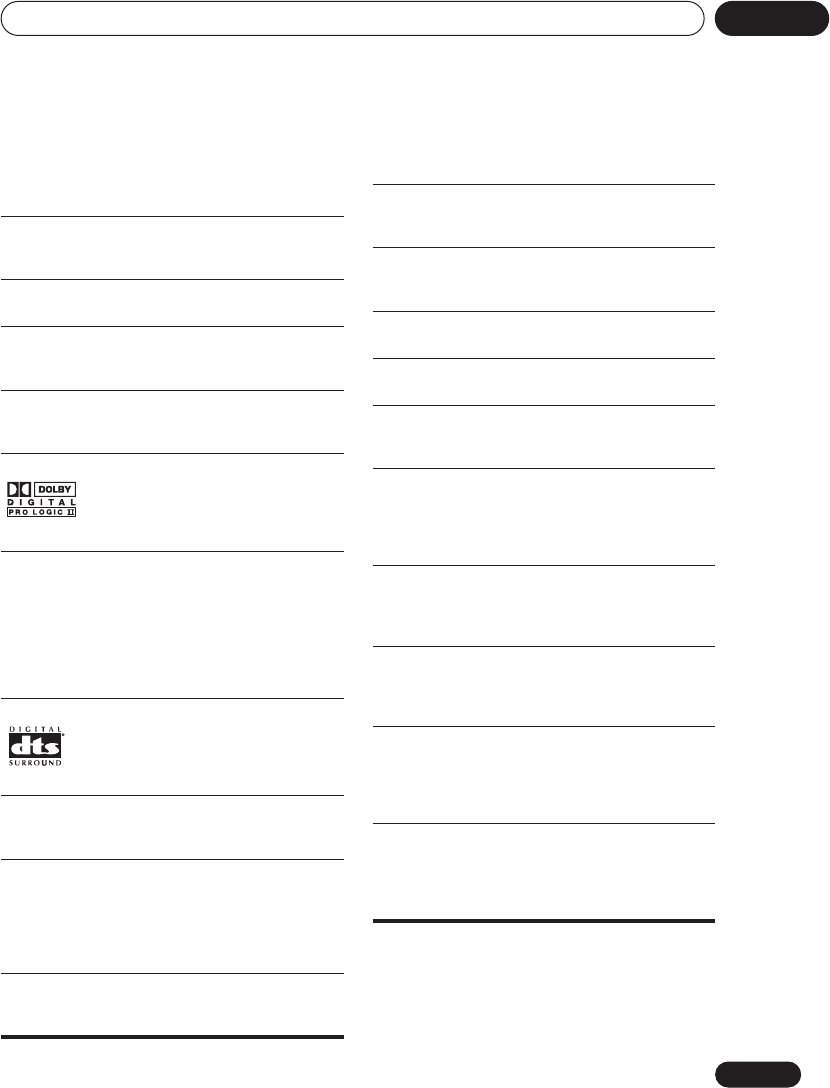
Additional information 12
91
En
Glossary
Manufactured under license from Dolby
Laboratories.“Dolby”, “Pro Logic” and the double-
D symbol are trademarks of Dolby Laboratories.
“DTS” and “DTS Digital Surround” are registered
trademarks of Digital Theater Systems, Inc.
Analog
audio Direct representation of sound by an
electrical signal. See also Digital audio.
Aspect ratio The width of a TV screen relative to its
height. Conventional TVs are 4:3;
widescreen models are 16:9.
Bonus Group
(DVD-Audio only)
An ‘extra’ group on some DVD-Audio discs
that requires a key number to access.
Browsable
pictures
(DVD-Audio only)
A feature of some DVD-Audio discs in
which the user can browse still pictures on
the disc as the audio is played.
Digital audio Indirect representation of sound using
numbers. See also Sampling frequency
and Analog audio.
Dolby Digital
A multichannel audio encoding system
developed by Dolby Laboratories that
enables far more audio to be stored on a
disc than PCM encoding. See also PCM
(Pulse Code Modulation).
DRM copy
protection DRM (digital rights management) copy
protection is a technology designed to
prevent unauthorized copying by
restricting playback, etc. of material on
devices other than the PC used to record it.
For detailed information, please see the
instruction manuals or help files that
came with your PC and/or software.
DTS A multichannel audio encoding system
developed by Digital Theater Systems that
enables far more audio to be stored on a
disc than PCM encoding. See also PCM
(Pulse Code Modulation).
Dynamic
range The difference between the quietest and
loudest sounds possible in an audio
signal.
EXIF
(Exchangeable
Image File)
A file format developed by Fuji Photo Film
for digital still cameras. Digital cameras
from various manufacturers use this
compressed file format which carries date,
time and thumbnail information, as well as
the picture data.
File
extension A tag added to the end of a filename to
indicate the type of file. For example,
“.mp3” indicates an MP3 file.
ISO 9660
format International standard for the volume and
file structure of CD-ROM discs.
JPEG A standard file format used for still
images. JPEG files are identified by the file
extension “.jpg”.
MP3 MP3 (MPEG1 audio layer 3) is a
compressed stereo audio file format. Files
are recognized by file extension “.mp3”.
MPEG audio An audio format used on Video CDs and
some DVD discs.
MPEG video A video format used on Video CDs and
some DVD discs.
PBC
(PlayBack
Control)
A system of navigating a Video CD through
on-screen menus recorded onto the disc.
PCM
(Pulse Code
Modulation)
Digital audio encoding system found on
CDs. Good quality, but requires a lot of
data compared to Dolby Digital, DTS and
MPEG encoded audio. See also Digital
audio.
Progressive
scan video All the lines that make up a video picture
are updated in one pass (compared to
interlace which takes two passes to
update the whole picture).
Regions These associate DVD-Video discs and
players with particular areas of the world.
See
DVD Video regions
on page 76 for
more information.
Sampling
frequency The rate at which sound is measured to be
turned into digital audio data. The higher
the rate, the better the sound quality. CD is
44.1 kHz; DVD can be up to 96 kHz. See
also Digital audio.
Super Audio
CD (SACD) A high quality audio disc format that can
accommodate high sampling rate stereo
and multichannel audio, as well as
conventional CD audio all on the same
disc.

Additional information12
92
En
Specifications
Amplifier section
Continuous Power Output (RMS):
Front, center, surround . . . . . 100 W per channel
(1 kHz, 10 % T.H.D., 6 Ω)
Subwoofer . . . . 100 W (100 Hz, 10 % T.H.D., 6 Ω)
FM tuner section
Frequency range. . . . . . . . . . . . . . 87.5 – 108 MHz
Antenna. . . . . . . . . . . . . . . . . . . 75 Ω, unbalanced
AM tuner section
Frequency range
With 9 kHz step. . . . . . . . . . 531 kHz to 1,602 kHz
With 10 kHz step. . . . . . . . . 530 kHz to 1,700 kHz
Antenna. . . . . . . . . . . . . . . . . . . . . . Loop antenna
Miscellaneous
Power requirements. . . . . . . . . . .AC 120 V, 60 Hz
Power consumption . . . . . . . . . . . . . . . . . . .180 W
Power consumption in standby. . . . . . . . . . 0.5 W
Dimensions. . . . 420 (W) x 126 (H) x 445 (D) mm/
16 9/16 (W) x 4 15/16 (H) x 17 1/2 (D) in.
Weight . . . . . . . . . . . . . . . . . . . 9.8 kg / 21 lb. 10 oz
Accessories (DVD/CD receiver)
Remote control . . . . . . . . . . . . . . . . . . . . . . . . . . . 1
AA/R6P dry cell batteries. . . . . . . . . . . . . . . . . . . 2
Video cable (yellow plugs) . . . . . . . . . . . . . . . . . . 1
AM loop antenna . . . . . . . . . . . . . . . . . . . . . . . . . 1
FM antenna . . . . . . . . . . . . . . . . . . . . . . . . . . . . . 1
Power cord . . . . . . . . . . . . . . . . . . . . . . . . . . . . . . 1
These operating instructions. . . . . . . . . . . . . . . . 1
Warranty Card . . . . . . . . . . . . . . . . . . . . . . . . . . . 1
Speaker System (S-HTD540)
(Front speakers x2, surround speakers x2, center
speaker x1, subwoofer x1)
Front speakers
Enclosure. . . . . . . . . . . Closed-box bookshelf type
(magnetically shielded)
System. . . . . . . . . . . . . . . . . . . . . . . .2-way system
Speakers:
Woofer . . . . . . . . . . . . . . . . . . .10 cm cone type
Tweeter . . . . . . . . . . . . . . . . . 5.2 cm cone type
Nominal impedance . . . . . . . . . . . . . . . . . . . . .6 Ω
Frequency range . . . . . . . . . . . . . 50 Hz to 20 kHz
Maximum Input Power . . . . . . . . . . . . . . . . 100 W
Dimensions . . . . 155 (W) x 364 (H) x 190 (D) mm
6 1/8 (W) x 14 3/8 (H) x 7 1/2 (D) in.
Weight . . . . . . . . . . . . . . . . . . . . 2.6 kg / 5 lb 12 oz
Center speaker
Enclosure . . . . . . . . . . Closed-box bookshelf type
(magnetically shielded)
System . . . . . . . . . . . . . . . . . 8.7 cm 1-way system
Speakers. . . . . . . . . . . . . . . . . . . 8.7 cm cone type
Nominal impedance . . . . . . . . . . . . . . . . . . . . .6 Ω
Frequency range . . . . . . . . . . . . . 65 Hz to 20 kHz
Maximum Input Power . . . . . . . . . . . . . . . . 100 W
Dimensions . . . . . 350 (W) x 120 (H) x 75 (D) mm
13 3/4 (W) x 4 3/4 (H) x 3 (D) in.
Weight . . . . . . . . . . . . . . . . . . . . . . 1 kg / 2 lb 3 oz
Surround speakers
Enclosure . . . . . . . . . . Closed-box bookshelf type
(magnetically shielded)
System . . . . . . . . . . . . . . . . . 8.7 cm 1-way system
Speakers. . . . . . . . . . . . . . . . . . . 8.7 cm cone type
Nominal impedance . . . . . . . . . . . . . . . . . . . . .6 Ω
Frequency range . . . . . . . . . . . . . 95 Hz to 20 kHz
Maximum Input Power . . . . . . . . . . . . . . . . 100 W
Dimensions . . . . 155 (W) x 110 (H) x 110 (D) mm
6 1/8 (W) x 4 5/16 (H) x 4 5/16 (D) in.
Weight . . . . . . . . . . . . . . . . . . . . 0.8 kg / 1 lb 13 oz
Subwoofer
Enclosure . . . . . . . . . . . . . . .Bass-reflex floor type
System . . . . . . . . . . . . . . . . . 16 cm 1-way system
Speaker. . . . . . . . . . . . . . . . . . . . .16 cm cone type
Nominal impedance . . . . . . . . . . . . . . . . . . . . .6 Ω
Frequency range . . . . . . . . . . . . . . 35 Hz to 2 kHz
Maximum Input Power . . . . . . . . . . . . . . . . 100 W
Dimensions . . . 190 (W) x 360 (H) x 327 (D) mm/
7 1/2 (W) x 14 3/16 (H) x 12 7/8 (D) in.
Weight . . . . . . . . . . . . . . . . . . . . 5.0 kg / 11 lb 0 oz

Additional information 12
93
En
Accessories (S-HTD540)
Speaker cables. . . . . . . . . . . . . . . . . . . . . . . . . . . .6
Non-skid pads . . . . . . . . . . . . . . . . . . . . . .2 sheets
Digital Wireless Speaker System (XW-
HTD640)
General
Digital Wireless Speaker System (Transmitter /
Wireless speaker)
Transmitter
AC adapter:
Power requirements . . . . . . . . . . . AC120V, 60 Hz
Power consumption . . . . . . . . . . . . . . . . . . . . .8W
Rated output . . . . . . . . . . . . . . . . . . . .12V/300mA
Power consumption (without AC adapter) . . .2W
Input . . . . . . . . . . . . . . . . . . . . . . . . . . . . .RCA jack
Weight . . . . . . . . . . . . . . . . . . . . . . . .0.3 kg / 11 oz
Dimensions . . . . . 166 (W) x 56 (H) x 112 (D) mm
6 9/16 (W) x 2 3/16 (H) x 4 7/16 (D) in.
Wireless speaker
Power requirements . . . . . . . . . . . AC120V, 60 Hz
Power consumption . . . . . . . . . . . . . . . . . . . .57W
Amplifier characteristics
Maximum power output . . . . . . . . . . . . . . 25W/ch
RMS(1kHz, THD 10%, 4Ω)
Speaker unit. . . . . . . . . . . . . . . 7 cm cone type x2
Weight . . . . . . . . . . . . . . . . . . . . . 4.0 kg / 8lb 14oz
Dimensions (without
antenna). . . . . . . .430 (W) x 180(H) x 138 (D) mm
16 15/16 (W) x 7 1/8 (H) x 5 7/16(D) in.
Accessories (XW-HTD640)
AC adapter . . . . . . . . . . . . . . . . . . . . . . . . . . . . . . .1
RCA stereo cord. . . . . . . . . . . . . . . . . . . . . . . . . . .1
Warranty card . . . . . . . . . . . . . . . . . . . . . . . . . . . .1
Power cable . . . . . . . . . . . . . . . . . . . . . . . . . . . . . .1
Speaker System (S-HTD630)
(Front speakers x2, center speaker x1, subwoofer
x1)
Front speakers
Enclosure . . . . . . . . . . Closed-box bookshelf type
(magnetically shielded)
System. . . . . . . . . . . . . . . . . . . . . . . .2-way system
Speakers
Woofer . . . . . . . . . . . . . . . . . . . . 10 cm cone type
Tweeter . . . . . . . . . . . . . . . . . . . .5.2 cm cone type
Nominal impedance. . . . . . . . . . . . . . . . . . . . . 6 Ω
Frequency range . . . . . . . . . . . . . 60 Hz to 20 kHz
Maximum Input Power. . . . . . . . . . . . . . . . .100 W
Dimensions. . . . 145 (W) x 235 (H) x 204 (D) mm/
5 11/16 (W) x 9 1/4 (H) x 8 1/16 (D) in.
Weight. . . . . . . . . . . . . . . . . . . . . . . 2 kg / 4 lb 7 oz
Center speaker
Enclosure . . . . . . . . . . Closed-box bookshelf type
(magnetically shielded)
System. . . . . . . . . . . . . . . . . .8.7 cm 1-way system
Speakers . . . . . . . . . . . . . . . . . . .8.7 cm cone type
Nominal impedance. . . . . . . . . . . . . . . . . . . . . 6 Ω
Frequency range . . . . . . . . . . . . . 70 Hz to 20 kHz
Maximum Input Power. . . . . . . . . . . . . . . . .100 W
Dimensions. . . . . 310 (W) x 110 (H) x 85 (D) mm/
12 3/16 (W) x 4 5/16 (H) x 3 3/8 (D) in.
Weight. . . . . . . . . . . . . . . . . . . . . . . 1 kg / 2 lb 3 oz
Subwoofer
Enclosure . . . . . . . . . . . . . . Bass-reflex floor type
System. . . . . . . . . . . . . . . . . . 16 cm 1-way system
Speaker . . . . . . . . . . . . . . . . . . . . 16 cm cone type
Nominal impedance. . . . . . . . . . . . . . . . . . . . . 6 Ω
Frequency range . . . . . . . . . . . . . . 35 Hz to 2 kHz
Maximum Input Power. . . . . . . . . . . . . . . . .100 W
Dimensions. . . . 190 (W) x 360 (H) x 327 (D) mm/
7 1/2 (W) x 14 3/16 (H) x 12 7/8 (D) in.
Weight. . . . . . . . . . . . . . . . . . . . .5.0 kg / 11 lb 0 oz
Accessories (S-HTD630)
Speaker cables . . . . . . . . . . . . . . . . . . . . . . . . . . . 4
Non-skid pads. . . . . . . . . . . . . . . . . . . . . . . 1 sheet

Additional information12
94
En
Digital Wireless Rear Speaker System
(XW-HTD630)
General
Digital Wireless Rear Speaker System
(Transmitter / Wireless speaker)
Transmitter
AC adaptor:
Power requirements. . . . . . . . . . . .AC120V, 60 Hz
Power consumption . . . . . . . . . . . . . . . . . . . . . 8W
Rated output . . . . . . . . . . . . . . . . . . . . 12V/300mA
Power consumption (without AC adaptor). . . 2W
Input. . . . . . . . . . . . . . . . . . . . . . . . . . . . . RCA jack
Weight . . . . . . . . . . . . . . . . . . . . . . . . 0.3 kg / 11 oz
Dimensions. . . . . .166 (W) x 56 (H) x 112 (D) mm
6 9/16 (W) x 2 3/16 (H) x 4 7/16 (D) in.
Wireless speaker
Power requirements. . . . . . . . . . . .AC120V, 60 Hz
Power consumption . . . . . . . . . . . . . . . . . . . . 57W
Amplifier characteristics
Maximum power output. . . . . . . . . . . . . . 25W/ch
RMS(1kHz, THD 10%, 4Ω)
Speaker unit . . . . . . . . . . . . . . .7 cm cone type x2
Weight . . . . . . . . . . . . . . . . . . . . . . 4.2 kg / 9lb 4oz
Dimensions. . . . .420 (W) x 178 (H) x 138 (D) mm
16 9/16 (W) x 7 (H) x 5 7/16(D) in.
Accessories (XW-HTD630)
AC adaptor. . . . . . . . . . . . . . . . . . . . . . . . . . . . . . . 1
RCA stereo cord . . . . . . . . . . . . . . . . . . . . . . . . . . 1
Operating Instructions . . . . . . . . . . . . . . . . . . . . 1
Warranty card . . . . . . . . . . . . . . . . . . . . . . . . . . . . 1
• This product includes FontAvenue® fonts
licensed by NEC corporation. FontAvenue
is a registered trademark of NEC
Corporation.
• Specifications and design subject to
possible modification without notice, due
to improvements.
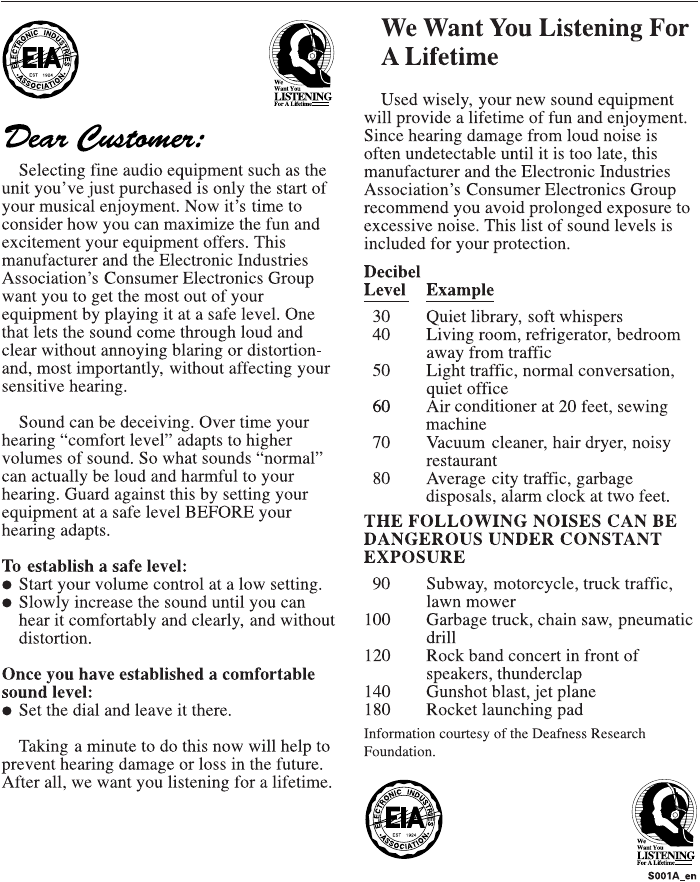
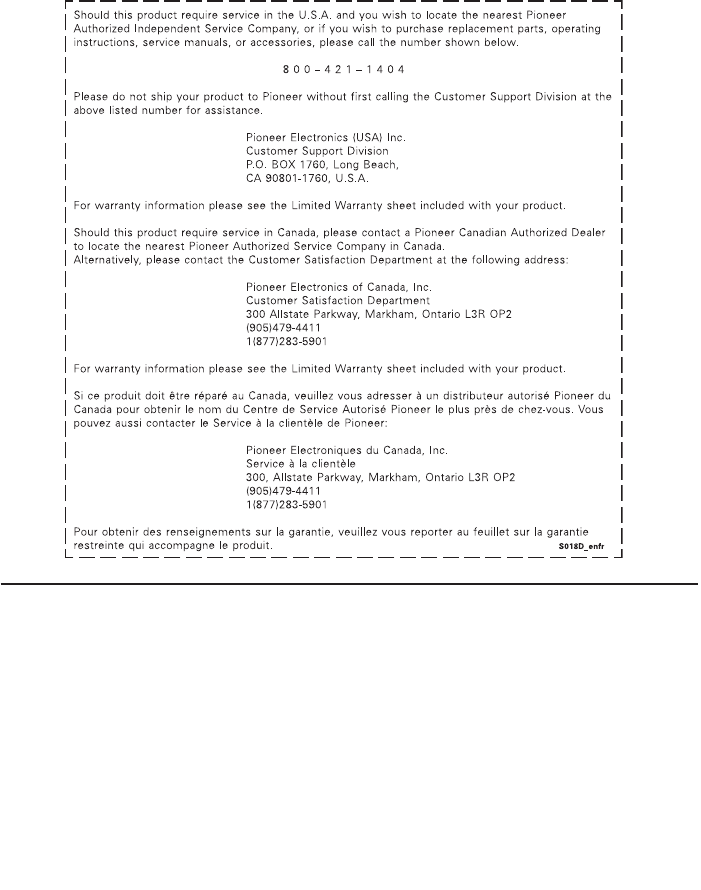
PIONEER CORPORATION
4-1, Meguro 1-Chome, Meguro-ku, Tokyo 153-8654, Japan
PIONEER ELECTRONICS (USA) INC.
P.O. BOX 1540, Long Beach, California 90810-1540, U.S.A. TEL: (800) 421-1404
PIONEER ELECTRONICS OF CANADA, INC.
300 Allstate Parkway, Markham, Ontario L3R OP2, Canada TEL: (905) 479-4411
PIONEER EUROPE NV
Haven 1087, Keetberglaan 1, B-9120 Melsele, Belgium TEL: 03/570.05.11
PIONEER ELECTRONICS ASIACENTRE PTE. LTD.
253 Alexandra Road, #04-01, Singapore 159936 TEL: 65-6472-1111
PIONEER ELECTRONICS AUSTRALIA PTY. LTD.
178-184 Boundary Road, Braeside, Victoria 3195, Australia, TEL: (03) 9586-6300
PIONEER ELECTRONICS DE MEXICO S.A. DE C.V.
Blvd.Manuel Avila Camacho 138 10 piso Col.Lomas de Chapultepec, Mexico,D.F. 11000 TEL: 55-9178-4270
K002E
<04C000001> Printed in <XRB3034-A>